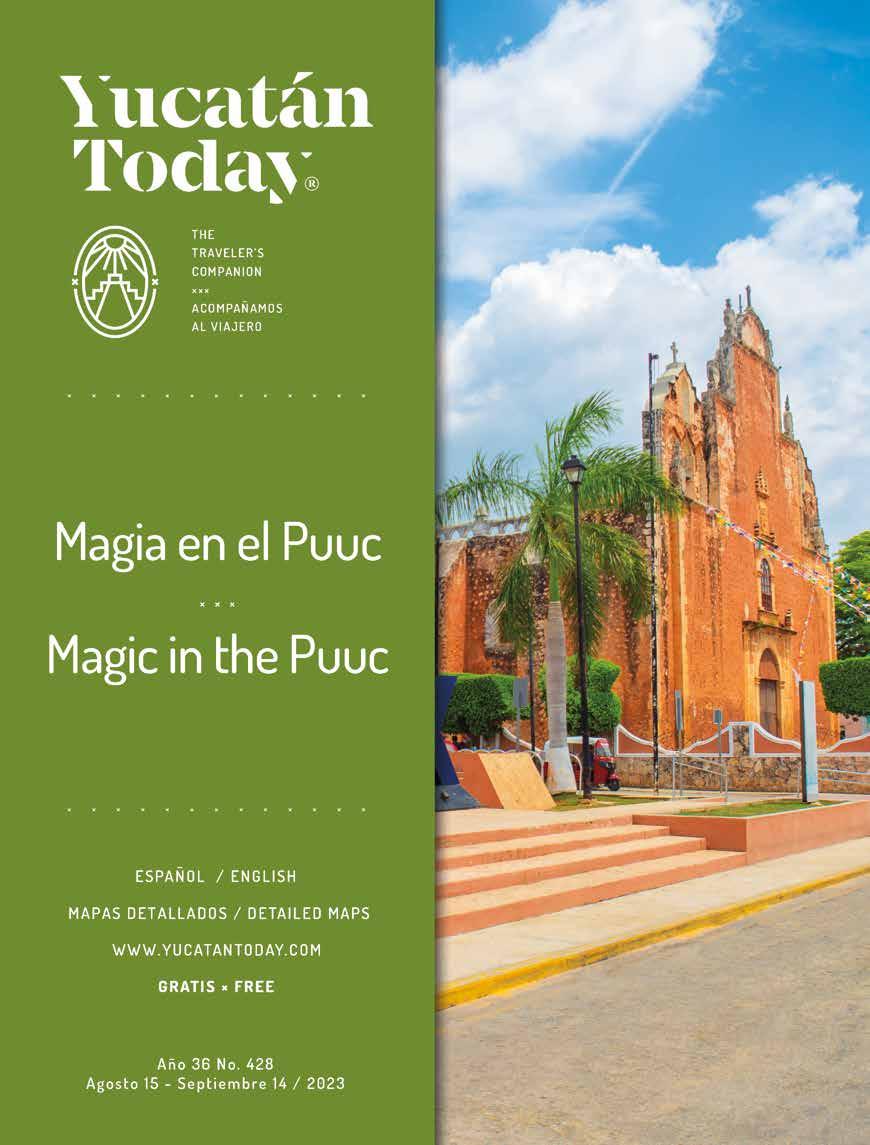
Yucatán Today, la compañera del viajero, es un medio bilingüe de información turística sobre destinos, cultura y el qué hacer en Yucatán con 35 años de trayectoria.
Yucatán Today, the traveler’s companion, is a bilingual tourist information medium about destinations, culture, and everyday life in Yucatán with 35 years of history.
xxx
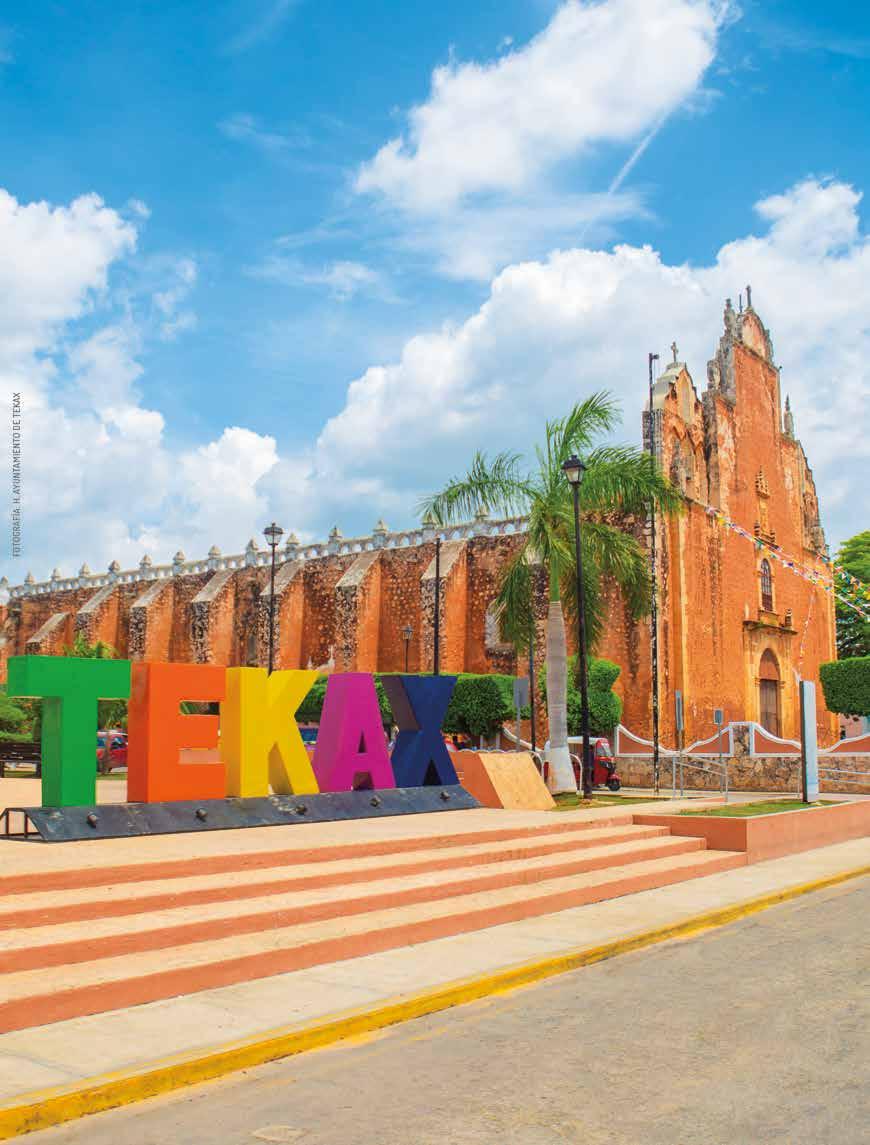

Los siete Pueblos Mágicos de Yucatán The Seven Magical Towns of Yucatán
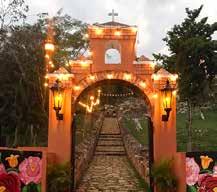
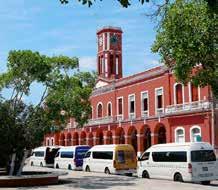
o necesitamos decirte que, en nuestra opinión, todo Yucatán está lleno de magia. Sin embargo, el gobierno de México tiene un programa que reconoce formalmente a ciertas poblaciones cuando éstas demuestran contar con ciertas características (tradiciones, historia, naturaleza, comida, etc.) que los hacen únicos y que vale la pena tomarse el tiempo para conocer.
En julio pasado, el gobierno de México anunció una nueva ola de Pueblos Mágicos, y desde luego no sorprende que Yucatán esté estrenando tres: Espita, Motul y Tekax. Éstos se unen a Izamal, Valladolid, Sisal y Maní para dejar a Yucatán con un total de siete maravillosos Pueblos Mágicos reconocidos.
Los factores que decidieron la inclusión de estas tres villas como Pueblos Mágicos son muchos, y cada uno merece su propio artículo; Espita, por ejemplo, considerada en algún momento la Atenas de Yucatán por su riqueza cultural, y Motul, por su innegable aporte a la gastronomía mexicana y su rol en la historia de Yucatán.
En esta edición, aprovechamos nuestra visita a la región Puuc, en el sur de nuestro bello estado, para llevarte a conocer uno de estos tres nuevos Pueblos Mágicos: Tekax. Este histórico poblado, cuyo nombre en maya (Ti’ K’aax) significa “allá en la selva”, esconde aún más magia de la que se ve a simple vista.
El verde de la selva a su alrededor, las vistas desde la Sierrita, la arquitectura e historia, tanto de su parroquia y exconvento dedicados a San Juan Bautista como de su Ermita… cada uno dejará su marca en tu corazón, pero podrían verse opacados por el esplendor de sus grutas y formaciones geológicas subterráneas.
Es quizá debido a sus grutas y todo lo que evocan que Tekax desarrolló (y prácticamente perfeccionó) una vocación natural por el turismo de aventura: además de espeleología y senderismo, encontrarás diversas opciones para hacer tirolesa, rappel, recorridos en cuatrimotos y bicicleta, y muchas cosas más.
Por si eso fuera poco, no olvides que Tekax se encuentra al extremo oriente de la región Puuc. Sólo siete kilómetros la separan de Chacmultún, el último sitio arqueológico maya visitable dentro de la misma; aunque es de los sitios menos conocidos (o quizá por esa misma razón), es una experiencia de exploración que vale incluir dentro de tu recorrido por esta área. ¿Te gustaría saber más? Nuestro artículo acerca de Tekax te espera en la página 18, y nuestro especial sobre la ruta Puuc, en la página 36. ¡Que siga la magia!
e don’t need to tell you that, in our opinion, every corner of Yucatán is filled with magic. However, the Mexican government has a program that formally recognizes places proven to be characterized by certain features (traditions, history, nature, food, etc.) that make them unique; Pueblos Mágicos (Magical Towns) are villages that are well worth a detour.
Last July, a new wave of Magical Towns was announced, and it’s no surprise that Yucatán has three wonderful new ones to boast: Espita, Motul, and Tekax. These, along with Izamal, Valladolid, Sisal, and Maní, make for a total of seven Magical Towns in Yucatán.

The factors that determined the inclusion of these three villages as Magical Towns are many, and each one deserves its own article. Espita, for example, was once considered the Athens of Yucatán due to its cultural wealth, and Motul has long been known for its undeniable contribution to Mexican cuisine and its role in our local history.
In this edition, since we were already heading south of the state to take you on a tour of the Puuc region, we’re re-introducing you to one of these three new Magical Towns: Tekax. This historic village, whose name in Maya (Ti’ K’aax) means “there in the jungle,” hides even more magic than first meets the eye.
The lush greenery, the views from its hills, the architecture and history of both its parish and former convent dedicated to Saint John the Baptist, its charming Ermita...each of those factors will leave its mark on your heart, but keep in mind they could all very well be overshadowed by the splendor of its caves and underground geological formations.
Perhaps it is because of the caves and the feelings they evoke that Tekax has developed (and practically perfected) a natural vocation for adventure tourism. In addition to spelunking and hiking, you will find various options for zip-lining, rappelling, ATV and bicycle tours, and much more.
As if that weren’t enough, there’s also its Maya legacy: Tekax, as mentioned above, is located at the easternmost end of the Puuc region. Just seven kilometers away you’ll find Chacmultún, one of the seven archeological sites in the Puuc that’s open to the public.
Although it is one of the lesser-known sites (or perhaps because it is), Chacmultún is an exploration experience worth including in your itinerary through this area. Ready to find out more more? Our article about Tekax awaits you on page 19, and our special feature on the Puuc route, on, page 38. Let the magic continue!
1 Life and Culture
PORTADA • COVER STORY
W N
Espita
Motul Tekax
FOTO: AYUNTAMIENTO DE ESPITA
FOTO: RALF HOLLMAN
FOTO: FERNANDA TUZ
uerido lector,
Es una verdadera alegría para mí darte la bienvenida a esta edición especial de Yucatán Today, dedicada a la región de la Sierrita de Ticul, también conocida como región Puuc. Esta micro-cordillera (cuyo punto más alto alcanza 210 m sobre el nivel del mar) se extiende de forma casi paralela a nuestra frontera con el vecino estado de Campeche, desde el municipio de Maxcanú hasta Tekax y parte de Tzucacab.
Este relieve, a pesar de su reducida altura, literalmente sobresale en una tierra tan plana como lo es Yucatán; aun así, no es lo único que hace especial a esta región. Su impresionante mundo subterráneo, su impactante vegetación, su gente, su conexión con su pasado y presente maya… Son muchísimos los factores que podríamos elegir para ilustrar por qué esta zona es ideal para adentrarse más a fondo en Yucatán y todo lo que representa.
A lo largo de esta edición irás descubriendo distintos aspectos de lo que el sur del estado te ofrece, incluyendo, desde luego, la ruta Puuc (los sitios arqueológicos mayas más decorados en Yucatán), pero también uno de los tres flamantes nuevos Pueblos Mágicos de Yucatán: Tekax. A nombre de todo el equipo de Yucatán Today, esperamos de todo corazón haber logrado transmitirte las emociones que experimentamos en nuestro recorrido, y que esta edición te inspire a planear tu propia aventura.
¡La Sierrita te espera!
DIRECTORIO
DIRECTORY
Todos los derechos reservados por Dynamic Offset SA de CV. Prohibida la reproducción total o parcial del contenido sin autorización por escrito de los editores.
La revista asume que el material aquí presentado es original y no infrige los derechos reservados de ley.
Reserva de derechos al uso exclusivo del título YUCATAN TODAY - Certificado de Derecho de Autor No. 050616181900 SECOFI.

Yucatán Today no se hace responsable por el contenido de los anuncios.

Yucatán Today is not responsible for the content of the advertisements.
TIRAJE

MONTHLY CIRCULATION
Calle
Mérida, Yucatán, México, C.P. 97000
Tel. (999) 927 8531
Q Dear reader
I am truly delighted to be welcoming you to this special edition of Yucatán Today, devoted to the region surrounding the Sierrita de Ticul (the Ticul hills), also known as the Puuc region. The Sierrita is a micro-mountain range (rising a whopping 210 m, or roughly 690 ft, above sea level) that runs almost parallel to our border with the neighboring state of Campeche, beginning at the municipality of Maxcanú and all the way down to Tekax and part of Tzucacab.
This relief, despite being roughly half as tall as, say, the Empire State Building, literally stands out in a land as flat as Yucatán; still, it isn’t the only factor that makes this region special. The land that surrounds the Sierrita boasts impressive underground cave formations, breathtaking vegetation, delicious food, warm people, and a deep connection to its Maya past and present…In other words, there’s plenty of elements to choose from when trying to explain why this area is perfect for a deeper exploration of Yucatán, and everything in it.
Throughout this issue you’ll discover several aspects of what the southwest region of our state has to offer, including, of course, the Puuc route (that is, a string of deeply ornate Maya archaeological sites), but also one of Yucatán’s brand new Magical Towns: Tekax. On behalf of everyone in the Yucatán Today team, we truly hope we’ve managed to convey everything we experienced while researching this issue, and that this edition inspires you to plan an adventure of your own. So there you have it: it’s time to run for the hills!
SOCIOS FUNDADORES • FOUNDING PARTNERS
Juan Manuel Mier y Terán Calero
Judy Abbott de Mier y Terán / judy@yucatantoday.com
DIRECTOR
Andrea Mier y Terán Abbott / andrea@yucatantoday.com
EDITOR • EDITOR
Alicia Navarrete Alonso / editor@yucatantoday.com
ASISTENTE EDITORIAL • EDITORIAL ASSISTANT


Sara Alba Prim / escribe@yucatantoday.com
ESCRITORES COLABORADORES • CONTRIBUTING WRITERS
Sara Alba, Carlos Argüelles, Brenda Ávila, Alberto Chuc, Raúl Gasque, Ralf Hollmann, Damián Medina, Alicia Navarrete, Fernanda Pacheco
DISEÑO GRÁFICO • GRAPHIC DESIGN
Magali Ramírez D. / diseno@yucatantoday.com
MERCADOTECNIA • MARKETING
Arianne Osalde / estrategia@yucatantoday.com
Carlos Guzmán Andrade / contenido@yucatantoday.com
Brenda Daniela Avila Acametitla / eventos@yucatantoday.com
María Fernanda Casanova Uc / jrdiseno@yucatantoday.com
ADMINISTRACIÓN • ADMINISTRATION
Renée Morales Jiménez / gerente@yucatantoday.com
Lic. Alitzel Muñoz Ornelas / contabilidad@yucatantoday.com
Yorgina Montalvo Pech / recepcion@yucatantoday.com
DISTRIBUCIÓN • DISTRIBUTION
Roberto Pérez Miguel / cobranza@yucatantoday.com
DISEÑO EDITORIAL • EDITORIAL DESIGN
Gustavo Reyes Asid / 6US diseño
DISEÑO DE LOGOTIPO Y PORTADA
H Creativos
• LOGO & COVER DESIGN
Yucatán Today, elegido como mejor creador de contenido turístico
Yucatán Today, chosen as best tourism content creator
Yucatán Today MEDIA KIT
2
Vida y Cultura
CARTA DE LA EDITORA • LETTER FROM THE EDITOR
10,000
MENSUAL
10,000
interior 10,
54
56,
39 #483
x
y
Centro
9
5 pm
Lun. - vie. / Mon. - Fri.
am -
•
YUCATÁN TODAY ES LA GUÍA RECOMENDADA POR YUCATÁN TODAY IS THE GUIDE RECOMMENDED BY Yucatan Today YucatanToday yucatantoday yucatantoday www.yucatantoday.com PUBLICIDAD • ADVERTISING 999 309 7762 / clientes@yucatantoday.com
‘Hay algo mágico en viajar y regresar todo cambiado’.
‘There is a kind of magicness about going far away and then coming back all changed.’
Alicia Navarrete Alonso editor@yucatantoday.com
—Kate Douglas Wiggin
VIDA Y CULTURA
Es muy yucateco: La casita del alux
Un día en la vida: El sur de Yucatán, un líder citrícola
Xe’ek’: La leyenda del cenote de Maní
Quiénes son los mayas: La casa tradicional maya
Enfoque: Choco-Story Uxmal, un museo interactivo
Lo mejor de Yucatán este mes
Galerías / Museos / DIR
Empezemos con el arte: Ko’ox Túukul Ko’ox Boom
¿Qué hay de nuevo?
Promociones y descuentos Eventos
¡DÓNDE IR Y CÓMO!
Cómo llegar
Estancia de siete días
Salidas familiares:Tekax
Acerca de Yucatán
Acerca de Mérida
Centro de Mérida / MAPA
Paseo de Montejo
Los barrios del Centro de Mérida Santa Lucía
Mérida Norte / MAPA
Ciudad de Mérida / MAPA
Dónde hospedarse / DIR
COMER EN YUCATÁN
Comer en Yucatán: Vive una experiencia de cocina tradicional maya
Cocina yucateca: Botana
Dónde comer / DIR
DESTINOS
Descubriendo lugares: La Ruta Puuc, más que sólo Uxmal Cenotes
Ruta de los Conventos / MAPA
Haciendas
Chichén Itzá
Valladolid / MAPA
Izamal
Sisal / Celestún Progreso
Chuburná Puerto / Chelem / Chicxulub Puerto / MAPA
Telchac Puerto / San Crisanto / Dzilam de Bravo / MAPA
Tizimín / El Cuyo
San Felipe / Río Lagartos / Las Coloradas
REFERENCIA RÁPIDA
Bienestar / Directorio de salud / DIR
Agencias de Viaje / Transportación / Bienes Raíces / DIR
Consulados / Números teléfonicos de emergencia / DIR
LIFE AND CULTURE
It’s Very Yucatecan: A House for an Alux
A Day in the Life: Southern Yucatán, Leader in Citrus Production
Xe’ek’: The Legend of the Maní Cenote
Who Are the Maya: The Traditional Maya House
In Focus: Choco-Story Uxmal, an Interactive Museum
Yucatán Top 10 This Month
Galleries / Museums / DIR
Let’s Start With Art: Ko’ox Túukul Ko’ox Boom
What’s New?
Promotions and Discounts
Events
WHERE TO GO AND HOW!
How to Get There
A Seven-Day Stay
Family Outings: Tekax
About Yucatán
About Mérida
Mérida Downtown / MAP
Paseo de Montejo
The Barrios in Mérida’s Centro
Santa Lucía
North Mérida / MAP
Mérida City / MAP
Where to Stay / DIR
EATING IN YUCATÁN
Eating in Yucatán: A Traditional Maya
Cooking Experience
Yucatecan Cuisine: Snacks
Where to Eat / DIR
DESTINATIONS
You’re Going Places: The Puuc Route, Beyond Uxmal
Cenotes
The Convent Route / MAP
Haciendas
Chichén Itzá
Valladolid / MAP
Izamal
Sisal / Celestún
Progreso
Chuburná Puerto / Chelem / Chicxulub Puerto / MAP
Telchac Puerto / San Crisanto / Dzilam de Bravo / MAP
Tizimín / El Cuyo
San Felipe / Río Lagartos / Las Coloradas
QUICK REFERENCE
Wellness/ Health Directory / DIR
Travel Agencies / Transportations / Real Estate / DIR
Travel Tips / Emergency Phone Numbers / Consulates / DIR
3 ÍNDICE • CONTENTS PASEO DE MONTEJO & YUCATÁN MAPAS EN PÁGINAS CENTRALES • MAPS IN CENTERFOLD 4 5 6 7 8 9 10 11 12 13 14 16 17 18 21 22 23 24 25 26 27 28 29 30 33 34 36 41 42 43 44 45 46 47 48 50 51 52 53 54 55 56
ARTÍCULO NUEVO NEW ARTICLE
La casita del alux A House for an Alux
e gustan los dulces. Cada vez que voy a la tienda compro algunos, aunque en realidad no son para mí. Sucede que, en mis andanzas por Yucatán, he observado la presencia, en ciudades y pueblos, de pequeñas casitas como de juguete, pero que no son ningún juego. Están allí; simplemente te las encuentras en la esquina, en alguna acera, al fondo de un patio o afuera de un edificio en construcción.
¿Qué son estas casitas que pueblan la geografía rural y urbana de la península yucateca? Porque las he visto incluso en la zona hotelera de Cancún. La respuesta está en la mitología maya, en la que existen los Aluxes: unos seres pequeños que guardan el monte, las cuevas y los cenotes. Dotados de poderes mágicos y un carácter travieso, los Aluxes viven entre nosotros sin que los veamos, aunque sí los percibimos: una sombra o un ligero soplo del viento pueden delatar su presencia.
Por lo regular son benignos, pero conviene no molestarlos. En el campo, los milperos piden su ayuda para proteger la siembra de animales o de personas ajenas. Para ello hacen ceremonias en las que se les ofrendan bebidas y alimento. En entornos urbanos la costumbre también se observa. Quizá no se hagan ceremonias, pero se construyen las casitas que te mencioné, con el fin de ganar el favor del Alux y cuidar la casa o permitir construir en algún terreno.
No hay, que yo sepa, un manual de edificación ni tampoco un modelo de casita único. A veces son una sencilla choza o bien una elaborada pirámide con todo y su Chac Mool.
Se sabe de obras de construcción que sufrían retrasos misteriosos hasta que se levantaba una casita para el Alux guardián del terreno; entonces, la obra continuaba sin problema. Por eso los dulces, aunque la fruta es buena opción también. Se les deja como ofrenda y muestra de respeto al Alux, una forma de agradecer su compañía y protección.
Habrá quien califique la costumbre como superstición, pero no faltan las historias de cómo alguien padeció las consecuencias de no creer o, peor aún, de faltar al respeto a algún Alux en el campo.
Además, las casitas de Alux son bonitas y, a mi entender, son un modo de mantener viva una manera de ver el mundo que nos distingue como yucatecos. Al igual que las hadas, los Aluxes existen en tanto se crea en ellos. Además, ¿qué sería del Mayab sin su mitología, sin sus seres mágicos?
Por eso compro dulces, para dejarlos en las casitas que hallo en el camino y el alux que vive allí, sepa que se le respeta.
have a sweet tooth. Every time I go to the store, I buy candy; they’re not really for me, though. You see, during my wanderings around Yucatán, I’ve noticed the presence of small, doll-sized houses located in cities and towns alike. However, these are not toys.
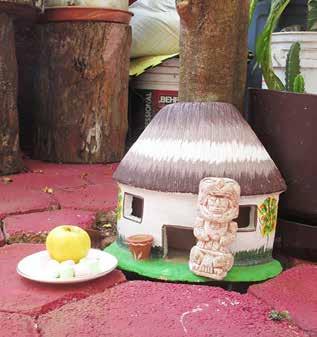
They’re simply there; you might come across them on a street corner, on a sidewalk, at the back of a courtyard, or outside a construction site.
What are these little houses that populate the rural and urban landscape of the entire Yucatán Peninsula? Because I’ve even seen them in Cancún’s hotel zone.
The answer lies in Maya mythology, where the Aluxes exist: small beings that guard the forests, caves, and cenotes. Endowed with magical powers and a mischievous personality, Aluxes live among us without being seen, but we can sense their presence through a shadow or a gentle breeze.
They’re usually amicable, but it’s best not to disturb them. In rural areas, farmers seek their help to protect their crops from animals or intruders. They perform ceremonies where drinks and food serve as offerings to the Aluxes. This practice is also observed in urban environments. Perhaps there are no ceremonies, but people build these tiny homes in order to gain the favor of the Alux, protect their homes, or allow construction on certain land.
There isn’t, as far as I know, a manual for these houses. Sometimes they look like traditional Maya homes, while others are elaborate pyramids, complete with their own Chac Mool statue.
There are stories of construction projects that experienced mysterious delays until a little home for the guardian Alux of the land was built. Once the house was in place, the construction would continue without any issues. That’s why sweets are offered to Aluxes as a sign of gratitude for their presence and protection.
Some may consider this custom superstitious, but there are countless stories of people who have suffered the consequences of not believing or, worse, disrespecting the Alux of a cave or a property. In addition, Alux houses are beautiful and, in my opinion, a way to keep alive a worldview that distinguishes us as Yucatecos.
Just like fairies, Aluxes exist as long as people believe in them. Besides, what would the Mayab be without its mythology and magical beings?
That’s why I buy sweets, to leave them in the tiny homes I find along the way so that the Alux who lives there knows that they are respected.
4 Vida y Cultura ES MUY YUCATECO · IT’S VERY YUCATECAN
POR / BY ALBERTO CHUC Q albertochuc M
I
FOTO: AYUNTAMIENTO DE MÉRIDA
El sur de Yucatán, un líder citrícola
Southern Yucatán, a Leader in Citrus Production
os yucatecos amamos las cosas aciditas; quizá por eso nos hemos convertido en verdaderos maestros del cultivo de cítricos. Toda la magia ocurre en el sur, en el área denominada como “subregión sur frutícola”. Esta zona está conformada por los municipios de Akil, Dzan, Maní, Oxkutzcab y Ticul, donde se produce el 45.6% de todos los cítricos que se cultivan en la entidad.
Y qué cítricos: ninguno que compres en el supermercado te dará un sabor comparable a los que puedes conseguir (en temporada, desde luego) durante tus viajes por el cono sur yucateco, donde las toronjas son más dulces, los limones más jugosos, y las naranjas más sabrosas.
La variedad de frutos que se cosecha es amplia, pero entre los más comunes están el limón persa, la mandarina, la toronja, la lima yucateca y la famosísima naranja agria. Si estás acostumbrado a comprar cítricos en el súper, o nos visitas de otras latitudes, quizá te sorprenda que aquí las naranjas, las toronjas y las mandarinas pueden tener toques de color, pero son predominantemente verdes.
Esto se debe a nuestras altas temperaturas; mientras que en otros lugares sus pieles (o cáscaras) cambian de color al entrar el otoño, en Yucatán necesitan continuar produciendo clorofila para protegerse del sol. Para saber si están maduras, necesitarás tentarlas o, mejor todavía, preguntarle a tu “marchante” (vendedor) si ya están buenas para consumir.
Cabe aclarar que cuidar de árboles cítricos no es tarea sencilla. La temperatura influye bastante, no sólo en el color, sino también en el desarrollo del limón y la toronja, alargando o acortando sus procesos de maduración. Además, se requiere de suelos con pHs específicos y patrones de riego o lluvia muy particulares para un crecimiento óptimo.
El esfuerzo de los campesinos del sur de Yucatán no es en vano. El estado ocupa el sexto lugar a nivel nacional en producción de naranjas, generando más de 185 mil toneladas durante el 2022. En el caso del limón, se produjeron más de 99 mil toneladas, ocupando el séptimo lugar; nada despreciable, considerando que México se ubica en los primeros cinco lugares en producción de cítricos, y en el primero específicamente cuando se trata de limones.
La gran calidad del trabajo de los agricultores yucatecos es indiscutible. Quien sea que haya probado una sopa de lima o un buen puchero es testigo de la excelencia del sureste. Así que, si por alguna razón andas en el sur del estado, que no se te olvide pasar a comprar “chinas” (como los yucatecos conocemos a las naranjas), para que puedas experimentar de primera mano las delicias que la tierra yucateca tiene para ofrecer.
Yucatecos love all things tangy; that may be why we’ve become true masters of citrus cultivation. All the magic happens in the south, in the area known as the “Southern Fruit Subregion.” This zone includes the municipalities of Akil, Dzan, Maní, Oxkutzcab, and Ticul, where 45.6% of all citrus harvested in the region is produced.
And we’re talking outstanding citrus: no store-bought fruit will carry the flavor provided by anything you try while you’re exploring southern Yucatán (while in season, of course). Here, grapefruit is sweeter, limes are juicier, oranges are tastier.

The variety of fruits harvested is vast, but among the most common are Persian lime, mandarin, grapefruit, Yucatecan lime, and the famous bitter orange. If you’re used to shopping for citrus at the supermarket, or are visiting from other places in the world, you may be surprised to find that here, oranges, grapefruit, and mandarin oranges might have touches of color, but are mostly bright green.
This is due to our warm weather; while elsewhere their skins change color as the leaves turn in the fall, in Yucatán they need to continue producing chlorophyll (the substance that makes plants green) to protect themselves from getting sunburned. To determine whether they’re ripe, you’ll have to feel them or, better yet, ask your “Marchante” (vendor) whether they’re already “buenas”.
It’s worth mentioning that taking care of citrus trees is quite a challenging task. According to a document from the National Agricultural Planning, the temperature has a significant influence not only on the color, but the development of fruits like limes and grapefruit, which affects their ripening processes. In addition, specific pH levels in the soil and specific irrigation patterns or rainfall are required for optimal growth.
But the efforts of farmers in southern Yucatán are not in vain. The state ranks sixth nationally in orange production, generating over 185 thousand tons in 2022. In the case of limes, over 99 thousand tons were produced, ranking seventh; not bad at all, considering México is among the top five citrus producers worldwide, and the first when it comes to limes specifically.
The high quality of the work of Yucatecan farmers is undeniable. Anyone who has tasted a Sopa de Lima or a good Puchero can testify to the excellence of our local citrus. So, if you happen to be in the southern part of the state, don’t forget to stop by and buy some “Chinas” (as we Yucatecos call oranges), so you can experience firsthand the delights that Yucatán has to offer.
5 Life and Culture UN DÍA EN LA VIDA • A DAY IN THE LIFE
FOTO: @ATNAVARRETE
Q charliarguelles
POR / BY CARLOS ARGÜELLES
L
Árbol de lima · Yucatecan lime tree
La leyenda del cenote de Maní The Legend of the Maní Cenote W Y
a sea que estés visitando Yucatán por primera vez o que seas un explorador experimentado de la región, es imposible no percibir el aire de misticismo que impregna cada rincón de Yucatán; ¿y qué mejor lugar para reflejar esto que un cenote? Los cenotes son uno de los sitios que no te puedes perder durante tu visita al estado.
Más allá de su ambiente etéreo, los cenotes también son un testimonio de la profunda importancia cultural y espiritual que tuvieron para la civilización maya. No es de extrañar que muchos cuentos y leyendas se entrelacen con estos refugios subterráneos, guardando secretos del pasado y profecías del futuro.
La leyenda del cenote Xcabachén, ubicado en el centro de Maní, es un relato fascinante que gira en torno a este pequeño cuerpo de agua dentro de una gruta del mismo nombre. Aunque su tamaño sea modesto, el cenote es el escenario principal de una podero sa leyenda. Se dice que todo comenzó cuando los españoles llegaron a la Península, ansiosos por expandir su imperio. Sin embargo, el caci cazgo Xiu tenía un audaz plan para enfrentarlos.
Los Xiu colocaron dos bolsas de maíz mági co dentro del cenote Xcabachén. La historia cuenta que aquellos que lo comieran se con vertirían en guerreros de piedra, condenados a la inmovilidad hasta que un hechicero los li berara. El cacique esperaba que estos guerre ros de piedra resucitaran en el momento ade cuado para luchar contra los invasores.
La leyenda advierte de una batalla épica don de los guerreros de piedra resucitados lucharán junto a una serpiente emplumada. Juntos, desa fiarán a los invasores y restaurarán el equilibrio en la Península.
Sin embargo, este enfrentamiento tendrá un costo. Como resultado de la batalla, la Tierra quedará completamente despojada de agua en todas partes, excepto por las aguas del cenote Xcabachén. Personas de todo el mundo acudirán desesperadas a Maní para saciar su sed. Allí serán recibidos por una anciana y la misma serpiente emplumada emergiendo del cenote, ofreciéndoles agua de un cocoyol. La anciana tendrá un requerimiento: a cambio del valioso líquido, las personas deberán entregar a un recién nacido. Los bebés serán entregados a la serpiente emplumada como alimento.
Según la leyenda, este acuerdo se cumplirá cuando las voces de los hombres y los sonidos de los animales resuenen desde las profundidades de las grutas del cenote. Un dato curioso: se dice que la anciana que custodia el cenote es la bruja de la leyenda del enano de Uxmal.
Como puedes ver, además del encanto y su notable lugar en la historia, Maní alberga una gruta verdaderamente mística donde muchas leyendas se entrelazan, todas remarcando el valor ancestral de estas maravillas naturales.

hether you’re a first-time visitor or a seasoned explorer of the region, you cannot escape the palpable mysticism that permeates every corner of Yucatán, and what better place to showcase this than a cenote? Cenotes are among the essential sites to explore during your visit to the state.
Beyond their ethereal ambiance, cenotes are also a testament to the profound cultural and spiritual significance they held for the Maya civilization. It’s no wonder that many tales and legends interweave with these otherworldly havens, carrying secrets of the past and prophecies of the future.
Such is the case of the legend of the Xcabachén cenote, a small body of water inside the cave bearing the same name in Maní Centro. Despite its modest size, it lies at the heart of an ominous legend. It is said that everything began when the Spanish arrived on the Peninsula, eager to expand their empire. However, the Xiu chieftain had a bold plan to confront them and protect their land.
The Xius placed two bags of magical maize inside the Xcabachén cenote. The tale says that those who consumed the maize would turn into stone warriors, condemned to immobility until a sorcerer freed them. The chieftain hoped that these stone warriors would come back to life at the right moment to fight against the foreign invaders.
The legend forewarns of an epic battle where the resurrected stone warriors will fight alongside a feathered serpent. Together, they’ll challenge the invaders and restore balance in the Peninsula.
However, this struggle will come at a cost. Because of the battle, Earth will be left completely devoid of water everywhere—except for the crystal-clear waters of the Xcabachén cenote. People from all over the world will flock to Maní to quench their thirst. There, they will be greeted by an elderly woman and the same feathered serpent, offering them water on a Cocoyol fruit shell. In exchange for the precious liquid, people will have to surrender a newborn baby. The babies will be handed over to the feathered serpent as nourishment, ensuring the survival and renewal of the cycle of life.
According to the legend, this arrangement will come to fruition when the voices of men and sounds from animals echo from the depths of the cenote’s caves. A cool fact: some say the elderly woman who guards the cenote is the witch at the heart of the legend of the dwarf of Uxmal.
In addition to its charm and remarkable place in history, Maní is also home to a truly mystical cave where many legends intertwine, all pointing to the age-old value of these natural wonders.
6 Vida y Cultura
XE’EK’: INCLASIFICABLE • XE’EK: UNCATEGORIZABLE
Grutas Xcabachén Calle 27 x 30, Centro Maní, Pueblo Mágico
POR / BY SARA ALBA
Maní
La casa tradicional maya The Traditional Maya House
uando pensamos en las ciudades mayas y sus habitantes, es común tener en la mente una gloriosa ciudad como Chichén Itzá o Uxmal, con sus piedras labradas, pirámides, juegos de pelota, etc. Hoy, sin embargo, sabemos que la población se refugiaba y tenía su vida social en otro contexto, uno que persiste al día de hoy. En la frescura de un techo alto, con materiales del monte, se levanta la hermosa y trascendente casa maya.
Su construcción es un arte ancestral que combina destreza y conocimiento del entorno. Saber reconocer la buena madera de la selva maya es un paso indispensable; no todos los “bejucos” son buenos, no todos son resistentes o durables con el paso de los años. Muchas de estas plantas se encontraban en el solar maya; sin embargo, cada vez es más difícil recolectarlos.
Esto no se debe únicamente al crecimiento del desarrollo urbano y la reducción de espacios silvestres, sino también a que la casa maya tradicional fue percibida por los españoles como primitiva, y es hasta el día de hoy considerada como un indicador de pobreza. La realidad es que la casa maya tradicional es un ejemplo sobresaliente de la eficacia en la arquitectura, que resulta, a partir de siglos de experimentación y aprendizaje, en una construcción que es ideal para nuestro clima: fresca en verano, cálida en invierno, y altamente resistente a tormentas y huracanes.
Aun así, las nuevas generaciones prefieren las construcciones de concreto, lo que hace que los conocimientos necesarios para elaborar una casa maya, que antes eran conocidos por todos, se estén haciendo cada vez más escasos en la población en general.
La casa maya es un legado que convive con el ecosistema de la región y es muestra del ingenio y el conocimiento de los constructores. Incluso los astros son partícipes en este procedimiento, siendo la luna la que marca en qué tiempos construir y en cuáles no. Dormir, cocinar, conversar, estar simplemente en una de estas construcciones es una experiencia con nuestras tradiciones ancestrales.
Aunque la casa maya invita a sus residentes a convivir con la fauna que vive a su alrededor, algunas cabañas modernas cuentan con pabellones para reducir el riesgo de encontrarse con la vida silvestre (por ejemplo, insectos) en los momentos de descanso; ese es el caso de las cabañas Pájaro Azul, en Akil, una opción de hospedaje tradicional donde puedes vivir la experiencia por ti mismo.
Visita www.yuc.today/230807 para saber más sobre los materiales y la construcción de la casa maya tradicional.
hen we think of Maya cities and their inhabitants, we often envision glorious cities like Chichén Itzá or Uxmal, with their dazzling stone pyramids. However, we now know that the population’s everyday life took place in a different context, one that persists to this day. Built with materials from the surrounding forest, rises the timeless Maya house.
Its construction is an ancient art that combines skill and knowledge of the environment. Being able to discern the finest wood hidden within the depths of the Maya jungle is an essential step; not all Bejucos (lianas) are resistant or durable. Many of these wild plants used to be found in the Solar Maya (Spanish for “Maya Backyard”), but it’s been increasingly difficult to collect them over the years.
This is not only due to the growth of urban development and the reduction of natural areas, but also because the traditional Maya house was perceived by the Spaniards as primitive and is to this day considered an indicator of poverty. The reality is that the traditional Maya house is an outstanding example of architectural efficiency, a construction that’s ideal for our climate, based on centuries of experimentation and learning. The Maya house is cool in summer, warm in winter, and highly resistant to storms and hurricanes. However, concrete constructions are now preferred, which means that the knowledge required to build a Maya house, once shared by everyone, is becoming increasingly scarce among the general population.
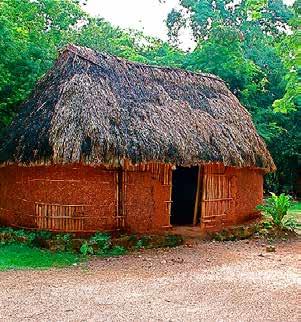
The Maya house is a living legacy that coexists with the region’s ecosystem, a testament to the ingenuity and knowledge of the builders. Even celestial bodies are involved in this process, with the moon marking the ideal times for construction and when it’s best to avoid it. Sleeping, cooking, having conversations, and simply being in one of these structures is an experience connected to our ancestral traditions.
While the traditional Maya house invites its dwellers to coexist with the wildlife that lives around them, some modern versions have nets to reduce the risk of encountering wildlife during moments of rest. That’s the case with Cabañas Pájaro Azul, a traditional lodging option in Akil where you can try the experience yourself.
Visit www.yuc.today/230807en to read the extended version of this article and to learn more about the construction of the traditional Maya house.
Cabañas Pájaro Azul
Calle 22 x 37 y 41, Colonia Hidalgo, Akil
m 997 105 3234
Q pajaro_azul_akil E Cabañas Pájaro Azul
7 Life and Culture ¿QUIÉNES SON LOS MAYAS? • WHO ARE THE MAYA?
C W
POR / BY DAMIÁN MEDINA
FOTO: JUAN MANUEL MIER Y TERÁN C.
Choco-Story Uxmal, un museo interactivo
Choco-Story Uxmal, an Interactive Museum
hoco-Story es, en pocas palabras, el museo del cacao en México. Sin embargo, describir así a Choco-Story Uxmal es no hacerle justicia en lo absoluto. Es verdad que el cacao, la base de lo que hoy conocemos como el maravilloso chocolate que endulza y hace felices nuestros días, fue un elemento invaluable para los pueblos prehispánicos de México, como fuente de alimento, moneda de cambio, elemento ceremonial… Y aprenderás sobre todo eso en este museo, y hasta sobre cómo el cacao llegó a Europa.
Pero no tienes que ser un adicto al chocolate ni un aficionado a la historia de la gastronomía para apreciar este maravilloso lugar, justo a las afueras de la zona arqueológica de Uxmal. Choco-Story Uxmal es una experiencia que te transporta desde que llegas a la que una vez fue una hacienda azucarera construida alrededor del siglo XVI. Lo primero que te sorprenderá será la abundante vegetación que te acompañará hasta la primera de seis salas de exhibición; cada una de ellas está dispuesta como una casa maya, lo que significa que entre ellas hay varios tramos naturales.
Choco-Story Uxmal es además una unidad de manejo ambiental (UMA), lo que significa que se encuentra reconocido por el gobierno como un sitio de protección y aprovechamiento sustentable de naturaleza, y no sólo por las plantas, sino porque también es hogar de diversas especies de animales que han sido rescatadas de vidas en cautiverio. Algunas de ellas, se espera, puedan reincorporarse a la vida silvestre; a otras sólo les queda pasar lo que les queda de vida en un lugar tan amplio y espacioso como Choco-Story.
Estoy segura que hay una parada que será la favorita para muchos: la sala de degustación de chocolate. Aquí podrás probar una tradicional bebida maya a base de cacao, en la cual tú mismo podrás elegir con qué acompañar tu bebida preparada según el método prehispánico. Sin embargo, uno de los momentos más especiales del recorrido será seguramente presenciar la representación de una ceremonia maya. En ella, al ritmo del Zacatán y el Tunkul (instrumentos de percusión prehispánicos), se le pide al dios de la lluvia, Chaac, sus favores para que la milpa pueda desarrollarse y crecer.
Si deseas vivir una experiencia al aire libre en la que podrás disfrutar y aprender del chocolate, los mayas y la naturaleza de Yucatán, no dudes en visitar Choco-Story Uxmal. Si el tiempo te lo impide, Choco-Story cuenta también con un museo interactivo en Valladolid que puedes hacer parte de tu recorrido.

Visita www.yuc.today/230808 para obtener más información sobre el tour, además de contenido adicional
hoco-Story is, in a nutshell, México’s cocoa museum. However, describing Choco-Story Uxmal like this doesn’t do it justice at all. It’s true that cocoa, the foundation of what we now know as the marvelous chocolate that sweetens and brightens our days, was an invaluable element for the pre-Hispanic civilizations of México, serving as food, currency, and a ceremonial item. You’ll learn all about that in this museum, and even about how cocoa made its way to Europe, where it became the delicacy we know today.
But you don’t have to be a chocoholic or a culinary history enthusiast to marvel at this extraordinary destination, located just outside the archeological site of Uxmal. Choco-Story Uxmal is an experience that transfers you from the moment you arrive to what was once a sugar plantation built around the 16th century. The first thing that will surprise you is the green lush that accompanies you to the first of six exhibition rooms, each one of which is arranged like a traditional Maya house, with plenty of natural spaces between them.
Choco-Story Uxmal is also an Environmental Management Unit (UMA), recognized by the government as a protected area for sustainable nature conservation. This designation not only safeguards the diverse plant life but also provides a sanctuary for various animal species rescued from captivity. Some of these creatures have the chance to be reintegrated into the wild, while others will spend the remainder of their lives in a place as vast and nurturing as Choco-Story.
I’m sure there’s a stop that will be the favorite for many: the chocolate tasting room. Here, you can try a traditional Maya cocoa-based beverage, and you even get to choose what to accompany your drink with, prepared according to the pre-Hispanic method. However, one of the most special moments of the tour will undoubtedly be the Maya ceremony reenactment. To the rhythm of the Zacatán and the Tunkul (pre-Hispanic percussion instruments), they ask the rain god, Chaac, for his favors so that the fields can grow and flourish.
If you want to live an outdoor experience where you can enjoy and learn about chocolate, the Maya, and Yucatán’s nature, don’t hesitate to visit Choco-Story Uxmal. If time doesn’t allow it, Choco-Story also has an interactive museum in Valladolid that you can include in your itinerary.
Visit www.yuc.today/230808en
photos.
Choco-Story Uxmal
m 999 289 9914
Q chocostory.mexico
POR / BY BRENDA ÁVILA
E Choco-Story Mexico
8 Vida y Cultura
for more information on tour prices, plus additional
C
ENFOQUE • IN FOCUS
C
CHOCO-STORY ES ANUNCIANTE EN YUCATÁN TODAY • CHOCO-STORY IS AN ADVERTISER IN YUCATÁN TODAY
Representación de ceremonia maya de la lluvia Maya rain ceremony performance at Choco-Story Uxmal
FOTO: YUCATÁN TODAY


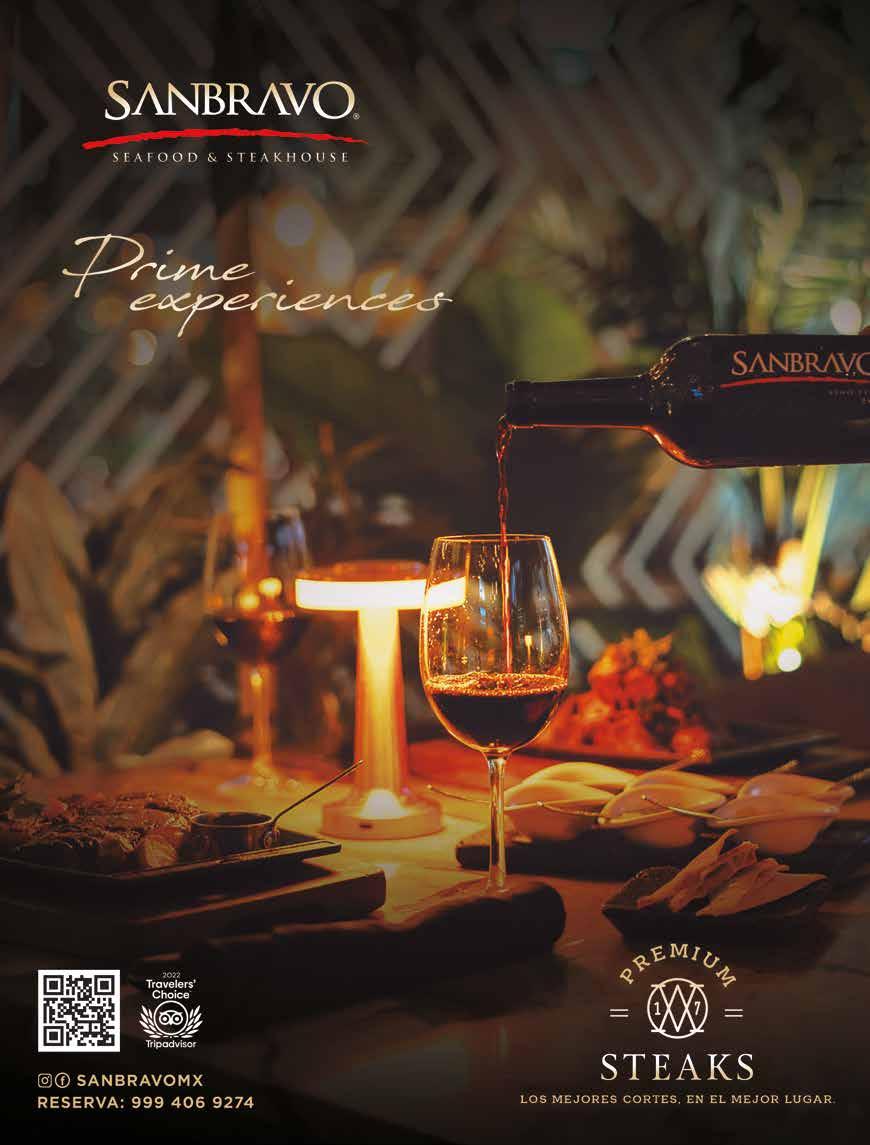
Disfruta la fiesta tradicional de Timucuy y baila al son los grupos musicales que se estarán presentado del 19 al 22 de agosto. Aprovecha tu visita y prueba los famosos helados artesanales de Hermenegildo Chan. Enjoy Timucuy’s annual fair, and dance to the bands that will be performing from August 19 to 22. Make the most of your visit and try the famous artisanal sorbets made by Hermenegildo Chan.
¡Noche de vaquería, tardeadas y mañanitas! Así nos recibirá Tahcabo en su feria del 18 al 25 de agosto. Llega temprano para disfrutar también del T’oox (la repartición) de cochinita y chicharra. Checa el calendario: Vaquería nights, afternoon gatherings, and birthday songs! That’s how Tahcabo will welcome us to its fair from August 18 to 25. Arrive early to also enjoy the T’oox (distribution) of Cochinita, and Chicharra. Check the calendar here:
www.yuc.today/Tahcabo23
Participa en la cabalgata organizada para fomentar el cuidado de los equinos y la convivencia familiar en Sotuta el 3 de septiembre, y aprovecha para recorrer este histórico poblado. ¡Habrá muchas sorpresas! Join the horseback ride organized to promote the care of horses and family togetherness in Sotuta on September 3, and take the opportunity to explore this historic town. There will be plenty of surprises!
E Mérida a Caballo A.C.
El recién restaurado Ex-Convento de Santo Domingo, en Uayma, te está esperando para que admires su arquitectura coqueta. Tip: La iglesia únicamente se encuentra abierta los fines de semana.
The newly renovated Former Convent of Santo Domingo in Uayma is waiting for you to admire its charming architecture. Tip: The former convent is only open to the public on weekends.
https://yuc.today/Mapa-Uayma
Este mes This month
¿Te quedas en Mérida? Visita el Parque Lineal Los Paseos, atractivo conformado por más de 15 kilómetros de parques. Todos los fines de semana podrás disfrutar de actividades deportivas y artísticas.
Are you staying in Mérida? Visit Parque Lineal Los Paseos, an attraction consisting of over 15 kilometers of parks. Every weekend, you can enjoy sports and artistic activities there.
www.yucatan.gob.mx/parquepaseos
Para gozar el final del verano sólo necesitas un castillo medieval: te sentirás en un cuento de hadas. Visita la Hacienda San Antonio Millet y enamórate de su arquitectura rodeada de naturaleza.
All you need is to enjoy the end of summer and a medieval castle to transport yourself into a fairy tale. Visit Hacienda San Antonio Millet, and fall in love with its architecture surrounded by nature.
E Hacienda San Antonio Millet
¡Disfruta de Mérida a través del deporte! Este 3 de septiembre puedes ir con tu familia a apoyar a los corredores en la carrera La Lupita, en donde habrá competencias infantiles, en patines y caminatas. Enjoy Mérida through sports! On September 3, you can bring your family to support the runners in the La Lupita race, which includes children’s races, rollerblading competitions, and walks.
E Botanas La Lupita
Conoce Espita, “La Atenas de Yucatán”. Es uno de los nuevos tres pueblos mágicos de Yucatán y se encuentra lleno de cultura, gastronomía y arquitectura colonial. ¡Descubre la magia por ti mismo!
Discover Espita, “The Athens of Yucatán.” It is one of the three new Magical Towns in Yucatán and is filled with culture, delicious cuisine, and colonial architecture. Uncover the magic for yourself!
E Ayuntamiento de Espita
Si viajas a Espita, tendrás que visitar el cenote Dzonotoch. Cuenta con recorridos en las cavernas, río subterráneo y baño maya. Admisión: adultos, $100 pesos; niños menores de 10 años $70 pesos.
If you’re traveling to Espita, you must visit the Dzonotoch cenote. It offers cave tours, an underground river, and a Maya bath experience. Admission is $100 pesos for adults and $70 pesos for children under 10 years old.
 E Cenote Dzonotoch
E Cenote Dzonotoch
Valladolid ya tiene ruta de museos, y uno de ellos es el Museo Xpeten Aak. Ahí podrás conocer la riqueza botánica de Yaxché, comisaría del municipio. Agenda tu visita en: Valladolid now has a museum route, and one of the stops is the Xpeten Aak Museum. There, you can explore the botanical richness of Yaxché, a village within the municipality. Plan your visit at:
E Museo comunitario yaxche “xpeten aak”
9 Life and Culture
E Ayuntamiento de Timucuy 2021-2024
LO MEJOR DE YUCATÁN ESTE MES • YUCATÁN TOP 10 THIS MONTH 1
8 2 7
10 4 9 5
3 6
TOP
10
FOTO: CENOTE DZONOTOCH
Cenote Dzonotoch, Espita
GALERÍAS / MUSEOS • GALLERIES / MUSEUMS
GALERÍAS • GALLERIES
Agustín Galería / Studio
Av. Rómulo Rozo #483 x 25 y 25-A, Itzimná m 999 262 4510 E Agustin Galería
Casa Museo Quinta Montes Molina
Paseo de Montejo #469, Mérida
E La Quinta Montes Molina
Centro Cultural La Cúpula
Calle 54 x 41 y 43, Centro, Mérida
Q E Centro Cultural la Cúpula
El Caimito
Calle 7 x 26 y 28, García Ginerés, Mérida
m 999 287 4417 E El Caimito
El Zapote Galería
Calle 57 #545-A x 66 y 68, Centro, Mérida
m 999 923 1391 E El Zapote
Galería Arte Municipal
Municipal Art Gallery
Calle 56 x 65 y 65-A, Centro, Mérida m 999 923 6869
Galería de Arte Sacro de Yucatán
Interior de la Iglesia / Inside Iglesia
San Francisco de Asís, Conkal
www.galeriadeartesacro.com/#about E Galería de Arte Sacro de la Arquidiócesis de Yucatán
Entrada / Entry: $30 pesos
Galería de Historiadores y Exploradores
Historians and Explorers Gallery
Interior / Inside Hotel Hacienda Uxmal
m 999 445 9845
Galería Nahualli
Calle 60 #405 x 43 y 45, Centro, Mérida
Q Nahualli Gallery
Lux Perpetua Art Centre
Calle 20 #87-E x 15, Col. Itzimná, Mérida
Q E Lux Perpetua Art Centre
SoHo Galleries
Calle 60 #400-A x 43 y 41, Centro, Mérida
m 999 344 7463
www.sohogalleriesmx.com

E SOHO Galleries
MUSEOS • MUSEUMS
FUERA DE MÉRIDA • OUTSIDE MÉRIDA
Casa de los Venados
Calle 40 #204 x 41, Centro, Valladolid
Donativo $100 pesos
Choco-Story • Chocolate Museum
Uxmal & Valladolid
m 999 289 9914
E Choco-Story Mexico
Entrada / Entry: $150 pesos
Hacienda Sotuta de Peón
Living Henequén Museum
Carr. Mérida - Peto, salida Tecoh m 999 941 6441
Recorridos / Tours: 9 am, 1 pm (español)
Entrada / Entry: $850 pesos adultos / adults, $499 pesos niños / children
Hacienda Yaxcopoil • Henequén Museum
Carr. / Highway Mérida - Uxmal Km 220 m 999 900 1193
Entrada / Entry: $125 pesos (niños gratis/ kids free)
Museo Comunitario de Yaxunah
Calle 25, Centro, Yaxcabá m 999 268 9216
Museo de Felipe Carrillo Puerto Calle 29 x 28, Centro, Motul m 991 915 1766
Museo del Meteorito
Malecón Tradicional x 66 y 68, Progreso m 999 942 1900
Entrada / Entry: $100 - $350 pesos
Museo de Ropa Étnica de México
Calle 49 x 40 y 42, San Juan, Valladolid m 985 113 6334
Entrada por donación / Entry by donation
Sendero Jurásico
Carretera Progreso - Chicxulub, Progreso m 999 588 4024
Entrada / Entry:
$200 pesos mexicanos / Mexicans
$300 pesos extranjeros / foreigners
$100 pesos niños / kids
EN MÉRIDA • IN MÉRIDA
Gran Museo del Mundo Maya de Mérida Calle 60 Norte, Col. Cordemex, Mérida m 999 341 0435 ext. 1005, 1070
www.granmuseodelmundomaya.com.mx
E Gran Museo del Mundo Maya de Mérida
Montejo 495, Casa Museo • House Museum
Calle 45 #495 x 43, Paseo de Montejo www.montejo495.com
E Montejo 495
Entrada / Entry: $50 pesos a $250 pesos
Museo Inmigración Coreana
Korean Immigration Museum
Calle 65 #397-A x 44 y 46, Centro, Mérida
E Museo Conmemorativo de la Inmigración Coreana a Yucatán
Gratis / Free
Museo de Arte Popular • Folk Art Museum
Calle 50-A #487 x 57, Centro, Mérida
Q E Museo de Arte Popular Yucatán
Gratis / Free
Museo de la Canción Yucateca
Yucatecan Song Museum
Calle 57 #464-A x 48, Centro, Mérida
E Museo de la Canción Yucateca A.C.
Entrada / Entry: $50 pesos
Museo de la Ciudad • City Museum
Calle 56 x 65 y 65-A, Centro, Mérida
E Museo de la Ciudad de Mérida
Gratis / Free
Museo Fernando García Ponce - MACAYArte Contemporáneo • Contemporary Art
Calle 60 x 61 y 63, Centro, Mérida
E MACAY
Museo Palacio Cantón
Anthropology Museum
Paseo de Montejo x Calle 43, Mérida
E Museo Palacio Cantón
Entrada / Entry: $90 pesos
Palacio de la Música
Calle 59 x 58, Centro, Mérida
E Palacio de la Música - Centro Nacional de la Música Mexicana
Entrada / Entry: $25 - $200 pesos
10 Vida
Cultura
y
Ko’ox Túukul Ko’ox Boom: el taller de arte en Dzan
Ko’ox Túukul Ko’ox Boom: The Art Workshop in Dzan
zan es un municipio verde, con olor a cítricos por todos lados y con una calma y abundante parsimonia que confirma el profundo Yucatán maya. Al entrar, una comunidad de flamboyanes te reciben. Ahí, a los lados de la carretera, también hay zanjas y huecos que, dicen, fueron túneles para proteger a los rebeldes mayas que pelearon en la Guerra de Castas.
En el corazón de Dzan, pasando caminos donde se intercalan casas mayas, comercios pequeños y casas remodeladas, arribas al taller Ko’ox Túukul Ko’ox Boom (Vamos a pensar, vamos a pintar) de José Chi Dzul.
Al llegar puedes ver un muro grande que dice “Éste es el primer taller de arte contemporáneo del sur de Yucatán”, firmado por el propio José. Y no se equivoca. Este taller funciona compartiendo los fundamentos, conocimientos y técnicas que José ha aprendido en la Universidad de las Artes de Yucatán, en las residencias de arte que ha realizado en el extranjero y, sobre todo, en el conocimiento conceptual de la sabiduría ancestral maya.
Es importante no imaginarse un taller lujoso ni ostentoso. El taller de José versa su sofisticación en el trato directo con el artista. La misión del taller es compartir sus conocimientos a los alumnos que tiene en Dzan y desarrollar la obra que posteriormente expone en museos e instituciones nacional e internacionalmente. Las obras de José tienen una serie de características originales; la caligrafía, el mensaje de sus textos en lengua maya y la técnica que ha ido desarrollando lo hacen un artista muy completo.
El taller cohabita con la casa de la familia de José. Ahí, como en la antigua usanza de la casa yucateca, hay gallinas, puercos y hasta vacas. De esa forma se conjuntan los tres ejes fundamentales de una casa tradicional: hogar, granja para autoconsumo y taller de trabajo.
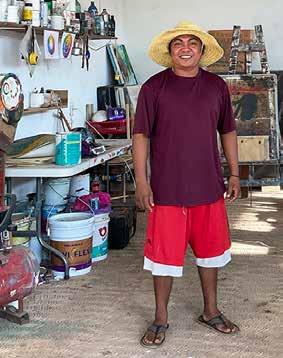
Las obras de José están hechas con pintura acrílica y óleo, pero también con recado negro, recado rojo y tierra. Estos últimos los empezó a adherir a sus obras durante la pandemia. Él dice que durante ese periodo las entradas de dinero fueron muy limitadas y la compra de pintura fue muy difícil. De ahí que empezó a trabajar con lo primero que tenía cerca de él.
Las puertas del taller están efectivamente abiertas. Para concertar una cita con José simplemente hay que escribirle un mensaje por correo electrónico. Durante la visita, José comparte sus obras y puede mostrarte el municipio de Dzan. Es sin duda una experiencia íntima que se recomienda a cualquier persona que esté buscando autenticidad, calidad y un profundo arraigo de lo maya en la gestación de arte contemporáneo.
zan is a small green town in the heart of the south of Yucatán, where citrus-smell perfume enters every corner. Upon entering, an abundance of Flamboyán trees greet you. Once you’ve passed them, you’ll see ditches and holes that, as the legends go, were once tunnels that protected the Maya rebels who fought in the Caste War of Yucatán.
In the heart of Dzan, after passing roads interspersed by Maya houses, small businesses, and renovated houses, you’ll arrive at Ko’ox Túukul Ko’ox Boom (Let’s think, let’s paint), José Chi Dzul’s contemporary art workshop.
There, you will see a large wall that reads “This is the first contemporary art workshop in southern Yucatán,’’ signed by José himself. And he is not wrong. This atelier works by sharing the knowledge and techniques that José has learned at the University of the Arts of Yucatán, in the art residencies that he has carried out abroad, and, above all, in his deep familiarity with the core of the Maya conceptual wisdom.
It’s important not to imagine a luxurious workshop. Its sophistication stems from direct contact with the artist. In addition to sharing his knowledge with his local students, the atelier is also where José develops the work that he later exhibits in museums nationally and internationally. José’s works have a series of original archetypes. The calligraphy, the statement of his texts in Maya, and his technique make him a very well-rounded artist.
The workshop shares its space with José’s family house. As in the old-fashioned Yucatecan way, there are chickens, pigs, and even cows. José’s place combines the three fundamental axes of a traditional house: a home, a farm for self-consumption, and a workshop.
José’s artworks are made with acrylic and oil paint, but also with black Recado, red achiote (the condiment you use for Cochinita Pibil), and soil from the artist’s backyard. These last elements began to adhere to his works during the pandemic. He says that during that time, income was limited and purchasing paint became difficult. Hence why he began to work with things he could find near him.
To make an appointment with José, you simply need to email him in advance. During the visit, José will share his works and show you the municipality of Dzan. It is, without a doubt, an intimate experience recommended to anyone looking for authenticity, quality, and deep rooting of the Maya in the creation of contemporary art.
Ko’ox Túukul Ko’ox Boom
José Chi Dzul
Calle 32 x 21 y 23 S/N Dzan
Q josechidzul
11 Life and Culture
EMPEZEMOS CON EL ARTE • LET’S START WITH ART
D
D
FOTO: RAÚL GASQUE
José Chi Dzul
POR / BY RAÚL GASQUE Q raul.gasque
FELIZ ANIVERSARIO A CALLEVEINTE
SIXTEEN YEARS OF CALLEVEINTE
Este año, Calleveinte cumple 16 años ofreciendo lo mejor en muebles, telas e interiorismo. This year, Calleveinte turns 16, always offering the best in furniture, fabrics, and interior design.
www.calleveinte.com.mx
Q calleveinte
DISFRUTA DE UN MANI & PEDI EN CASA KIOOL ENJOY A MANI-PEDI AT CASA KIOOL
¡Renovamos nuestros servicios de mani & pedi! Tu experiencia será más placentera mientras disfrutas una deliciosa bebida y snack en una habitación sólo para ti, con suave música y relajantes aromas. ¡Tenemos todo listo para apapacharte!
We’ve revamped our manicure and pedicure services! Your experience will be even more enjoyable while you enjoy a delicious drink and snack in your own private room, with soft music and relaxing aromas. We have everything ready to pamper you!
Q casakiool E CASA KIOOL Mérida
NUEVO CENOTE EN CENOTES SANTA BÁRBARA NEW CENOTE AT CENOTES SANTA BÁRBARA
Cenotes Santa Bárbara estrena nueva etapa y te ofrece ahora cuatro cenotes, incluyendo el cenote abierto “Pool Cocoom”. Contamos con un elevador para ingresar al cenote, un nuevo restaurante de comida rápida, mirador, y juegos de agua para toda la familia.
Cenotes Santa Bárbara is opening a new section! You can now swim in four cenotes, including the open cenote “Pool Cocoom”. We have an elevator for access to the cenote, a new fast food restaurant, a viewpoint, and water activities everyone in your family will enjoy.
Q cenotesantabarbara
MARTES DE PING-PONG EN FUNDACIÓN MEZCALERÍA
PING-PONG TUESDAYS AT FUNDACIÓN MEZCALERÍA
En apoyo a Ricardo Villa, deportista yucateco que en agosto y septiembre estará representando a México, en la disciplina de tenis de mesa en los FISU y en los Juegos Panamericanos, estaremos realizando eventos y actividades relacionadas con el Ping-Pong cada martes en La Fundación Mezcalería.
In support of Ricardo Villa, a Yucatecan table tennis athlete, we will be hosting events and activities related to Ping-Pong every Tuesday at La Fundación Mezcalería.
Q lafundacionmezcaleria
RENOVACIÓN DE VOTOS DE AMOR CON HERMANO MAYA
RENEWAL OF LOVE VOWS WITH HERMANO MAYA
¡Celebra el amor y las antiguas tradiciones con nosotros! Sé parte de una ceremonia especial dedicada a unir dos almas en su viaje juntos. Disfruta del ambiente místico, los rituales sagrados y las bendiciones de longevidad. No te pierdas esta extraordinaria celebración del amor y nuevos comienzos.
Celebrate love and ancient traditions with us! Join our special ceremony dedicated to uniting two souls on their journey together. Experience the mystical ambiance, sacred rituals, and blessings of longevity. Don’t miss this extraordinary celebration of love and new beginnings.
E Hermano maya
CLASES DE COCINA EN HOTEL DEL PEREGRINO COOKING CLASSES AT HOTEL DEL PEREGRINO
Al hospedarte con nosotros, obtendrás un increíble descuento del 23% en nuestras clases de cocina. Además, disfruta de un recorrido por el mercado principal, en donde podrás vivir una auténtica interacción cultural con la gente local.
By staying with us, you will receive an incredible 23% discount on our cooking classes. Plus, enjoy a tour of the main market, where you can experience an authentic cultural interaction with the local people.
E Hotel Del Peregrino
BIENVENIDO A LA CASA DE TU ALMA WELCOME TO THE HOUSE OF YOUR SOUL
Enamórate de la cultura mexicana que envuelve todos nuestros rincones y vive la magia del romance al caer la noche.
Fall in love with the Mexican culture that embraces every corner, and experience the magic of romance as the night falls.
QE lemuuchhotel
TOUR DE SNORKEL Y COMIDA EN CASA MAYA CON MAYAN ECOTOURS
SNORKELING TOUR AND MEAL WITH MAYAN ECOTOURS
Todo incluido en el tour de snorkel en cenotes y comida con una familia Maya. Conocerás sus viviendas, costumbres, modo de vida y hasta algunas palabras en maya, un contacto personal y cercano con las raíces de Yucatán. All-inclusive snorkeling tour in cenotes and a meal with a Maya family. You will get to know their homes, customs, way of life, and even learn some words in Maya, creating a personal and close connection with the roots of Yucatán. www.mayanecotours.com
E
Mayan Ecotours
EXPLORA LA SELVA Y ALDEAS MAYAS CON MAYALAND ADVENTURES
EXPLORE THE MAYA JUNGLE AND VILLAGES WITH MAYALAND ADVENTURES
Aventuras y experiencias en la jungla maya. Paseo en Land Rover vintage a la plantación y la antigua hacienda, degustación de fruta en la aldea maya, planetario maya, museo del chocolate, comida y uso de la alberca de The Lodge at Uxmal para refrescarse. Información y reservaciones Maya jungle experiences and adventures. Vintage Land Rover tour to the plantations and the old Hacienda vestiges, fruit tasting at the Maya village, Maya planetarium, Choco-Story museum, lunch and free time to freshen up at The Lodge at Uxmal swimming pool. Information and reservations:
m 997 123 2707
www.mayalandadventures.com
Q mayalandadventures
ESPECIALES DEL MES EN MERCI
MONTHLY SPECIALS AT MERCI
¡Disfruta nuestros especiales del mes! Nuestro pan de agosto es el rol de queso crema y mermelada de temporada, y el de septiembre, el Pain Suisse de avellana y chocolate. ¿Prefieres un postre? En agosto tendremos nuestra Crepe Suzette con helado de vainilla, y en septiembre, la deliciosa Tartaleta Bourdaloue.
Enjoy our limited-time specials! In August, our pastry of the month is the cream cheese roll with seasonal jam, and in September, a chocolate Pain Suisse. Looking for dessert instead? In August, try our Crepe Suzette with vanilla ice cream, and in September, the Bourdaloue Tart.
Q mercimid E Merci
VISITA EL OUTLET DE MET / VISIT MET’S OUTLET!
¡Ven a MET! En nuestro outlet tenemos muchos muebles en remate. Te esperamos con las mejores ofertas y el mejor servicio. ¡No dejes pasar esta oportunidad! Visit us at MET! We have a lot of furniture on sale. We’re waiting for you with the best offers and the best service. Do not miss this opportunity!
www.mueblesentransito.com
QE Muebles En Transito
DESCUBRE AL ARTE DE VIAJAR CON HOTEL OLBIL DISCOVER THE ART OF TRAVEL WITH OLBIL HOTEL Vive una experiencia de encuentro con la naturaleza y la cultura a través de la arquitectura y el arte mexicano. Experience a journey of connecting with nature and culture through Mexican architecture and art.
QE olbilhotelvalladolid
NOCHES VIBRANTES TE ESPERAN EN PASEO 60 VIBRANT NIGHTS AWAIT AT PASEO 60
¡Que tus noches no se vuelvan aburridas! Disfruta de la mejor música en vivo en Paseo 60, acompañado de una gran oferta gastronómica y un Mercado Gourmet, boutiques de arte, moda, belleza, hoteles, y mucho más.
¡Te esperamos!
Never have a dull night! Enjoy the best live music at Paseo 60, accompanied by a wide range of food options, and a Gourmet Market, art boutiques, fashion, beauty, hotels, guided tours on the Turibus through the streets of our beautiful city, and much more. We look forward to welcoming you!
Q paseo60 E Paseo 60
NUEVO MENÚ DE VERANO EN PICHETA
NEW SUMMER MENU AT PICHETA
La mejor terraza de Mérida estrena menú de verano. Ven a disfrutar nuevos platillos de autor y cócteles frescos para este verano.
The best terrace in Mérida is launching its summer menu. Come and enjoy new signature dishes and refreshing cocktails for this summer.
QE pichetamx
LO MEJOR PARA TUS OJOS
NOTHING BUT THE BEST FOR YOUR EYES
Sean cuales sean tus necesidades, ponemos a tu servicio una gran gama de lentes, para que, sea cual sea tu
12 Vida y Cultura ¿QUÉ HAY DE NUEVO? • WHAT’S NEW
estilo de vida, exista la lente perfecta para ti. Agenda tu cita en línea, cotiza y comprueba que tenemos los mejores precios todo el año.
Whatever your needs, Star Óptica offers a wide range of eyeglasses, so that you’ll have the perfect lens to suit your lifestyle. Schedule an appointment at our website and get a quote; we offer everyday low prices, year-round.
L 999 137 0060
www.staroptica.com


SABORES LEGENDARIOS TE ESPERAN EN TEXAS
ROADHOUSE
LEGENDARY FLAVORS AWAIT AT
TEXAS ROADHOUSE
¡Pan recién horneado, cortes importados, costillas tan tiernas que se desprenden del hueso, cerveza bien helada y margaritas legendarias! Si lo que buscas es un lugar con comida, servicio y ambiente legendario, ¡sin duda tienes que visitar Texas Roadhouse!
Freshly-baked bread, imported steaks, ribs so tender they fall off the bone, ice-cold beer, and legendary margaritas! If you’re looking for a place with legendary food, service, and ambience, you definitely have to visit Texas Roadhouse!
Q texasroadhousemexico
E Texas Roadhouse México

UNA FUSIÓN DE SABORES EN BC66
A FUSION OF FLAVORS AT BC66
En BC66 se fusionan los sabores de la cocina francesa con los ingredientes regionales de Yucatán, así como se fusionan las voces y ritmos latinos e internacionales para acompañar nuestros desayunos/brunch todos los fines de semana de 10:30 am - 12 pm.
At BC66, the flavors of French cuisine blend with the regional ingredients of Yucatán, just like the beats of Latin and international music come together to accompany our breakfast/ brunch every weekend from 10:30 am to 12 pm.
Q bistro_cultural E BC66




MÁS QUE UNA LIBRERÍA
MORE THAN A BOOKSTORE
¡Between the Lines es tu librería indie local! Tenemos libros en inglés, tarjetas de felicitación, diarios, rompecabezas, juegos y más. Nuestras estanterías contienen una variedad ecléctica de ficción, no ficción, historia Maya, gastronomía, libros sobre México, y tenemos un lindo rincón para niños.
Between the Lines is your local indie bookstore! We have books in English, greeting cards, journals, puzzles, games, and more. Our bookshelves carry an eclectic variety of fiction, non-fiction, Maya history, gastronomy, books about México, and we have a great kids’ corner.
QE Between the Lines Merida
DESAYUNOS EN TEYA SANTA LUCÍA
BREAKFASTS AT TEYA SANTA LUCÍA
Disfruta de nuestros desayunos en Teya Santa Lucía. Disponibles todos los días a partir de las 8 am. Enjoy our breakfasts at Teya Santa Lucía. Available every day starting at 8 am.
Q teyasantalucia
DISCOUNTS

Paquete de desayuno por $175 pesos. Q bistro_cultural
Conoce nuestro Programa de Lealtad. QE Between the Lines Merida
Hasta 25% en toda la tienda: muebles, accesorios, blancos, etc. Hasta agosto 31. Q calleveinte

Mani & Pedi Spa por $550 pesos. Lun. y jue. 1 - 3 pm. Sólo efectivo. Q casakiool
Precios especiales para niños de 4 a 10 años. Q cenotesantabarbara
40% de descuento en renovación de votos de amor. E Hermano maya
Margaritas a 2 x $100 pesos. Lun. - mar. 6 - 9 pm. Q lafundacionmezcaleria
Platillo del día con bebida por $110 pesos. Q lanegritacantina
Tarifas especiales en reservas anticipadas. QE lemuuchhotel
Tour Uxmal a $1,500 pesos + IVA p/p (min. 4 pax). Q mayalandadventures
Todo incluido en el tour de snorkel en cenotes y comida con familia Maya.
10% de descuento en pago en efectivo. QE Muebles En Transito
10% de descuento en renta de autos en septiembre. E México Rent A Car
Tarifas especiales reservando con anticipación. QE olbilhotelvalladolid
Renta tu bici en Paseo 60: una hora por $20 pesos. Q paseo60
Cóctel con plato fuerte al mencionar este anuncio. QE pichetamx
Meses sin intereses en productos seleccionados. L 999 137 0060
Early Dine: Platillo a elegir y dos guarniciones a sólo $199 pesos. Q texasroadhousemexico
¡Happy Hour! Cocteles seleccionados. Lun. - vie. 1 - 6 pm.
Q teyasantalucia
Breakfast package for $175 pesos. Q bistro_cultural
Ask about our Loyalty Program!
QE Between the Lines Merida
Up to 25% storewide: furniture, accessories, linens, etc. Through August 31. Q calleveinte

Mondays and Thursdays, Mani & Pedi Spa for $550 pesos, 1 - 3 pm. Cash only. Q casakiool
Discounted fees for children aged 4 to 10. Q cenotesantabarbara

40% off on our vow renewal ceremony. E Hermano maya
Two for $100 pesos on Margaritas. Mon.Tue. 6 - 9 pm. Q lafundacionmezcaleria
Enjoy our daily special with a beverage for $110 pesos. Q lanegritacantina
Special rates for bookings made 30 days in advance. Q E lemuuchhotel
Uxmal tour for $1,500 pesos + tax per person (4 min.). Q mayalandadventures

All-Inclusive snorkeling tour in cenotes and meal with a Maya family.
10% off when you pay cash.
QE Muebles En Transito
10% off on car rentals throughout September. E México Rent A Car

Special rates on advanced bookings. QE olbilhotelvalladolid
Rent your bike at Paseo 60: $20 pesos per hour. Q paseo60 E Paseo 60
Free Cocktail with main course, by mentioning this ad. QE pichetamx

Special packages and 0% financing on select eyewear. L 999 137 0060
Early Dine: One of seven entrées with two side dishes for only $199 pesos! Q texasroadhousemexico
Happy Hour! Select cocktails. Mon. - Fri. 1 - 6 pm.
Q teyasantalucia

13 Life and Culture PROMOCIONES Y
DESCUENTOS • PROMOTIONS AND
CARTELERA MENSUAL EN MÉRIDA • MONTHLY CALENDAR IN MÉRIDA
Biciruta nocturna / Biciruta at night: Paseo de Montejo
Primer sábado de cada mes, 6 - 10 pm
First Saturday of each month, 6 - 10 pm

Arte / Art:
Exposición: Atención
14 de septiembre - 14 de octubre; entrada libre
September 14 - October 14; free admission
Centro Cultural José Martí
Arte / Art:
Exposición temporal: Herencia y tradición
Museo de Arte Popular de Yucatán
Mar. - sáb. 10 am - 5 pm, dom. 10 am - 3 pm entrada libre
Tue. - Sat. 10 am - 5 pm, Sun. 10 am - 3 pm
free admission
E Museo de Arte Popular de Yucatán
Concierto / Concert:
Romeo Santos
20 de agosto, 9:30 pm; desde $590 pesos
August 20, 9:30 pm; starting at $590 pesos Estadio Carlos Iturralde www.funticket.mx
Cinematografía / Cinematography: Taller infantil / Children’s workshop: ¡Luces, cámara y acción!
23 - 25 de agosto; taller gratuito
August 23- 25; free workshop Centro Cultural de Mérida Olimpo cultura@merida.gob.mx
Orquesta Infantil y Juvenil de Mérida
27 de agosto, 5 pm; entrada libre
August 27, 5 pm; free admission Centro Cultural de Mérida Olimpo
..............
Arte / Art:
Dibujantes peninsulares
Desde el 1 de septiembre; entrada libre
Opening September 1; free admission
E Centro Cultural Punto MID
Concierto / Concert:
Candlelight: Mexicanísimo
2 de septiembre, 7 pm; $300 pesos
September 2, 7 pm; $300 pesos
Palacio de la Música
www.feverup.com
Concierto / Concert:
Ricky Martin
17 de sepiembre, 9 pm; desde $2,585 pesos
September 17, 9 pm; starting at $2,585 pesos
Foro GNP Seguros
www.eticket.mx
EVENTOS SEMANALES IN MÉRIDA • WEEKLY EVENTS IN MÉRIDA
LUNES / MONDAY ...................
Recorrido Gratuito / Free Walking Tour
(Bilingual) 9:30 am, Palacio Municipal
Recorrido Gratuito / Free Walking Tour
(Bilingual) 6:30 pm, Módulo información en Paseo de Montejo x Av. Colón.
Vaquería / Traditional Yucatecan Dancing
9 pm, Palacio Municipal
...............
MARTES / TUESDAY ...............
Recorrido Gratuito / Free Walking Tour
(Bilingual) 9:30 am, Palacio Municipal
Cata de Miel / Honey Tasting (Bilingual)
5 - 7 pm, www.mielnativa.com/experiencias
Recorrido Gratuito / Free Walking Tour
(Bilingual) 6:30 pm, Módulo información en Paseo de Montejo x Av. Colón.
Martes de Trova: 8 pm, C. C. Olimpo
Remembranzas Musicales
8:30 pm, Parque de Santiago
.........
MIÉRCOLES / WEDNESDAY .........
Recorrido Gratuito / Free Walking Tour
(Bilingual) 9:30 am, Palacio Municipal
Cata de Miel / Honey Tasting (Bilingual)
5 - 7 pm, $450 pesos; calle 62 x 53, centro
Recorrido Gratuito / Free Walking Tour
(Bilingual) 6:30 pm, Módulo información en Paseo de Montejo x Av. Colón
Miércoles de Trova
7 pm, Museo de la Canción Yucateca
Video mapping: Diálogos del Conquistador
8 pm, Gratis / Free Casa Montejo, Plaza Grande, Mérida
............... JUEVES / THURDAY ..............
Recorrido Gratuito / Free Walking Tour
(Bilingual) 9:30 am, Palacio Municipal
Recorrido Gratuito / Free Walking Tour
(Bilingual) 6:30 pm, Módulo información en Paseo de Montejo x Av. Colón.
Callejón Artesanal / Craft Alley
6 - 11 pm, Parque de Santa Ana
Serenata / Santa Lucía Serenade
9 pm, Parque de Santa Lucía
................ VIERNES / FRIDAY ................
Recorrido Gratuito / Free Walking Tour
(Bilingual) 9:30 am, Palacio Municipal
Callejón Artesanal / Craft Alley
6 - 11 pm, Parque de Santa Ana
Recorrido Gratuito / Free Walking Tour
(Bilingual) 6:30 pm, Módulo información en Paseo de Montejo x Av. Colón.
Recorrido Nocturno: Noche de Leyendas
Night Tour: Noche de Leyendas
7 pm, $80 pesos - $140 pesos
Catedral de Mérida
Video mapping: Piedras Sagradas
8 pm, Gratis / Free
Catedral de Mérida, Calle 60 x 61 y 63
.............
SÁBADO / SATURDAY .............
Mercado Slow Food Mérida Norte
8:30 am - 1 pm, Parque Pista Roja
Mercado Riqueza Local: 8:30 am - 1:30 pm
Parque Gonzalo Guerrero E Riqueza Local
Mercado Slow Food Yucatán
9 am - 1 pm, Av. Reforma x 33-D, Mérida
E Slow Food Yucatán
Recorrido Gratuito / Free Walking Tour (Bilingual) 9:30 am, Palacio Municipal
El Minaret mirador / Tower View
10 am - 10 pm, $50 pesos, P. de Montejo
Pok Ta Pok: 8 pm, Plaza Grande, Mérida
Noche Mexicana: 8 pm, Remate de Paseo de Montejo
..............
DOMINGO / SUNDAY ..............
Biciruta (Bicicletas en Renta)
Biciruta (Bikes for Rent) 8 am - 12 pm, Paseo de Montejo
El Minaret mirador / Tower View
10 am - 10 pm, $50 pesos, P. de Montejo
Mérida en domingo / Mérida on Sundays
12 pm, evento gratuito/ Free event
Palacio Municipal, calle 62 x 61 y 63
14 Vida y Cultura EVENTOS DEL MES: 15 AGOSTO - 14 SEPTIEMBRE · EVENTS THIS MONTH: AUGUST 15 - SEPTEMBER 14
EN YUCATÁN •
Chichen Itzá:
Video mapping Noches de Kukulcán Visita el sitio web para ver fechas disponibles Check website for available dates www.nochesdekukulkan.com.mx
Dzibilchaltún:
Video mapping Pasos de Luz
Jue. - dom., 7:30 - 9:30 pm
Thu. -Sun., 7:30 - 9:30 pm
$719 pesos; boletos en taquilla (efectivo)
Tickets at the box office (cash only) www.nochesdekukulkan.com.mx/evento/4
Izamal:
Video mapping Senderos de Luz
Jue. - sáb., 8 pm
Thu. - Sat., 8 pm
Parque de los Cañones, Izamal
$104 pesos (mexicanos / Mexicans)
$149 pesos (extranjeros / foreigners)
Maní:
Tour del Convento / Tour of the Convent Lunes a viernes agenda en: Monday to Friday reserve at: direccionturismo2022@gmail.com
Sábado y domingo / Saturday and Sunday 12 pm, 1 pm, 2 pm y 3 pm
Admisión / admission: $35 pesos
Uxmal:
Video mapping Ecos de Uxmal
7:30 y 8:15 pm, mar. - mié., vie. - dom.
7:30 and 8:15 pm, Tue. - Wed., Fri. - Sun.
$719 pesos; boletos en taquilla (efectivo)
Tickets at the box office (cash only) www.nochesdekukulkan.com.mx/evento/2
Valladolid:
Video mapping Noches de la Heroica
Valladolid
9 pm en español y 9:30 pm en inglés
9 pm in Spanish, 9:30 pm in English Mar. - dom. / Tue. - Sun.
Valladolid:
Recorrido a pie gratuito de Valladolid
Free walking tour of Valladolid
Lun. - sáb., 9:35 am y 7:30 pm, en el Parque Principal Francisco Cantón.
Tue. - Wed., Fri. - Sun., 9:35 am and 7:30 pm, at the Francisco Cantón park.
Tahcabo:
Feria Tahcabo 2023
Tahcabo Fair 2023
18 - 25 de agosto / August 18 -25 www.yuc.today/Tahcabo23
................ LUNES / MONDAY .................
6 pm, La Negrita, Calle 62 x 49, Centro
7 pm, El Cardenal Cantina, C. 63 x 70 Centro
7:30 pm, Dzalbay Cantina, Centro
8 pm, Paseo 60, Calle 60 x 35, Centro
8 pm, Avec Amour, Parque Santa Lucía
9 pm, Mercado 60, Calle 60 x 51, Centro
10 pm, La Fundación Mezcalería
............... MARTES / TUESDAY ...............
6 pm, La Negrita, Calle 62 x 49, Centro
7 pm, El Cardenal Cantina, C. 63 x 70 Centro
7:30 pm, Dzalbay Cantina, Centro
8:30 pm, Paseo 60, Calle 60 x 35, Centro
8 pm, Avec Amour, Parque Santa Lucía
8 pm, Martes de Trova, C. Cultural Olimpo
8 pm, Trópico 56, remate Paseo de Montejo
8:30 pm, Remembranzas Musicales, Santiago
9 pm, Mercado 60, Calle 60 x 51, Centro
10 pm, La Fundación Mezcalería
......... MIÉRCOLES / WEDNESDAY .........
6 pm, La Negrita, Calle 62 x 49, Centro
7 pm, El Cardenal Cantina, C. 63 x 70 Centro
7:30 pm, Dzalbay Cantina, Centro
8 - 10 pm, Avec Amour, Parque Santa Lucía
8:30 pm, Hennessy’s Irish Pub, P. de Montejo
8:30 pm, Paseo 60, Calle 60 x 35, Centro
8:30 pm, Trópico 56, remate P. de Montejo
9 pm, Bistrola 57, Calle 60 x 57, Centro
9 pm, Mercado 60, Calle 60 x 51, Centro
10 pm, La Fundación Mezcalería
.............. JUEVES / THURSDAY ..............
5 y 7:30 pm, Dzalbay Cantina, Centro
6 pm, La Negrita, Calle 62 x 49, Centro
7 pm, El Cardenal Cantina, C. 63 x 70 Centro
7 pm, Jazz en Wayam, Av. Colón x 6 y Reforma
8 pm, Avec Amour, Parque Santa Lucía
8 pm, Cadadía bar café, Calle 53 x 46, Centro
8 pm, Restaurante Hacienda Teya, Sta. Lucía
8:30 pm, Hennessy’s Irish Pub, P. de Montejo
9 pm - 2 am, Catrín, DJ en la terraza
9 pm, Fah, Calle 60 x 53 y 55, Centro
9 pm, Jazz en Maya de Asia, Plaza The Harbor
9 pm, Jazz en Rosas&Xocolate
9 pm, Mercado 60, Calle 60 x 51, Centro
9 pm, Paseo 60, Calle 60 x 35, Centro
9 pm, Serenata en Parque de Santa Lucía
9:30 pm, Bistrola 57, Calle 60 x 57, Centro
10 pm, La Fundación Mezcalería
10 pm, Trópico 56, remate P. de Montejo
................ VIERNES / FRIDAY ................
10:30 am, Bistro Cultural, C. 66 x 43, Centro
3 - 8 pm, Catrín, DJ en el salón
6 pm, La Negrita, Calle 62 x 49, Centro
6 pm, El Cardenal Cantina, C. 63 x 70 Centro
6:30 pm, Jazz at CASA T’HŌ
7:30 pm, Mercado 60, Calle 60 x 51, Centro
8 pm, Avec Amour, Parque Santa Lucía
8 pm, Restaurante Hacienda Teya, Sta. Lucía
8 pm, Hennessy’s Irish Pub, P. de Montejo
8:30 - 11:30 pm, DJ en Maya de Asia
8:30 - 11:30 pm, Lagos Taverna Griega
9 pm, Cadadía bar café, Calle 53 x 46, Centro
9 pm, Casa Chica, P. de Montejo x 45
9 pm - 2 am, Catrín, Dj en la terraza
9 pm, Jazz en Rosas&Xocolate
9 pm, Mercado 60, Calle 60 x 51, Centro
9 pm, Paseo 60, Calle 60 x 35, Centro
9:30 pm, Bistrola 57, Calle 60 x 57, Centro
9:45 pm, Trópico 56, remate P. de Montejo
10 pm, La Fundación Mezcalería
.........................
SÁBADO ........................
10:30 am, Bistro Cultural, C. 66 x 43, Centro
3 - 8 pm, Catrín, DJ en el salón
6 pm, La Negrita, Calle 62 x 49, Centro
6 y 10:45 pm, Trópico 56, remate P. Montejo
6:30 pm, Jazz at CASA T’HŌ
7:30 pm, Mercado 60, Calle 60 x 51, Centro
8 pm, Avec Amour, Parque Santa Lucía
8 pm, Restaurante Hacienda Teya, Sta. Lucía
8 pm, Patio Petanca, C. 57 x 48, Centro
8:30 pm, Hennessy’s Irish Pub, P. de Montejo
8:30 - 11:30 pm, DJ en Maya de Asia
8:30 - 11:30 pm, Lagos Taverna Griega
9 pm, Cadadía bar café, Calle 53 x 46, Centro
9 pm, Casa Chica, P. de Montejo x 45
9 pm - 2 am, Catrín, DJ en la terraza
9 pm, Fah Mérida, C. 60 x 53 y 55, Centro
9 pm, Jazz en Rosas&Xocolate
9 pm, Maya de Asia, Plaza The Harbor
9 pm, Mercado 60, Calle 60 x 51, Centro
9 pm, Paseo 60, Calle 60 x 35, Centro
9:30 pm, Bistrola 57, Calle 60 x 57, Centro
10 pm, La Fundación Mezcalería
...................... DOMINGO .......................
9:30 am, Jarana en Mansión Mérida
10 am, Jazz en Rosas&Xocolate
10:30 am, Bistro Cultural, C. 66 x 43, Centro
6 pm, La Negrita, Calle 62 x 49, Centro
6:30 pm, Hennessy’s Irish Pub, P. de Montejo
8 pm, Avec Amour, Parque Santa Lucía
8 pm, Cadadía bar café, Calle 53, 46, Centro
8 pm, Paseo 60, Calle 60 x 35, Centro
9 pm, Casa Chica, P. de Montejo x 45
9 pm, Mercado 60, Calle 60 x 51, Centro
9 pm, Paseo 60, Calle 60 x 35, Centro
10 pm, La Fundación Mezcalería
15 Life and Culture
MUSICA EN VIVO • LIVE MUSIC www.yuc.today/eventos www.yuc.today/events CONSULTA LA CARTELERA COMPLETA EN: CHECK OUT THE FULL PROGRAM AT:
IN YUCATÁN
Yucatán tiene tanto por ver y hacer que puede ser difícil hacer planes. En las siguientes páginas encontrarás información sobre algunos de los mejores destinos en Yucatán incluyendo lo que no te puedes perder y costos. Combínalo con nuestro Mapa Peninsular a color para planear tu itinerario sin problemas. Para más consejos útiles para tu estancia aquí, checa nuestra página 56. ¡Que comience la aventura!
Yucatán has so much to see and do that you’re bound to be overwhelmed by the choices! On the following pages, you will find information on some of Yucatán’s best destinations, including highlights and entry fees. Pair it perfectly with our color Map of the Peninsula so that you can plan your itinerary hassle-free. Check out our page 56 to get additional tips that will be useful during your stay in our area. Let the adventure begin!
TRANSPORTE PÚBLICO EN MÉRIDA • PUBLIC TRANSPORTATION IN MÉRIDA
BICICLETAS PÚBLICAS • PUBLIC BIKE SHARING
El Ayuntamiento de Mérida tiene un programa de bicicletas compartidas, gratis hasta el 31 de agosto. Toma una escaneando el código QR en las bici-estaciones o mediante la app. The Mérida city government has a bike-sharing program, free through August. Take one by scanning the QR code at bike stations or through the app. www.yuc.today/g-EnBici
AUTOBUSES URBANOS• CITY BUSES
SERVICIO VA Y VEN • VA Y VEN BUSES
Con boleto (a la venta en el aeropuerto) o tarjeta recargable / With ticket (available at the airport) or rechargeable card
Recarga en los cajeros (Periférico) o en tiendas Oxxo / Top-ups at ATMs on Periférico and Oxxo stores
Rutas / Routes
Ruta aeropuerto / Airport route
Tarifa / Fee: $45 pesos (sin tarjeta / non-cardholders)
Paradas / Stops: TAME 68, Santa Lucía, Paseo 60, Fiesta Americana, C.I. de Congresos y TAME 69.
Periférico
Tarifa / Fee: $12 pesos (5 am - 11 pm)
$14 pesos (11 pm - 5 am)
Circuito Metropolitano
Tarifa / Fee: $12 pesos
Horario / Hours: 5 am - 11 pm
AUTOPISTA DE CUOTA A CANCÚN Y PLAYA DEL CARMEN
La carretera de cuota se encuentra en obras, por lo que hay secciones con carriles reducidos, embotellamientos y velocidad reducida.
Toma tus precauciones.
Servicios: baños públicos, parador con tiendas, restaurantes, cafetería y gasolinera (Km 153, a la altura de Valladolid).
OTROS SERVICIOS • OTHER SERVICES
Circuito Aventura / Adventure circuit
Conecta / Connects Centenario, Animaya y Parque de Deportes Extremos Gratuito / Free Horario / Hours: Mar. - dom. / Tue. - Sun. 8 am - 8 pm
RUTAS E INDICACIONES • ROUTES AND DIRECTIONS
www.yuc.today/moovitapp
TOUR DE LA CIUDAD • CITY TOUR
Turibus
Salidas / Starting point: Catedral de Mérida, Paseo 60 www.turibus.com.mx/merida
Carnavalito
Salidas / Starting point: Parque de Santa Lucía www.carnavalitocitytour.com.mx E carnavalitocitytour
TOLL ROAD TO CANCÚN AND PLAYA DEL CARMEN
There is currently construction going on around the toll road; there are lane closures, traffic jams, and slow-moving traffic. Please drive carefully.
Services: restrooms, rest stops with shops, restaurants, coffee shop, and gas station (Km 153, by the exit to Valladolid).
Mérida Cancún
Mérida
Chichén Valladolid Cancún
Mérida Valladolid Playa del Carmen
Mérida Mérida Playa del Carmen Cedral (Holbox)
Tarifas en pesos para vehículos de dos ejes; costo adicional por eje y/o carga. Rates in pesos for two-axle vehicles; tolls increase by additional axle and/or weight.
Sólo efectivo / Cash only
FORÁNEOS • BEYOND MÉRIDA
SERVICIOS DE LUJO •
LUXURY SERVICES
· Terminal ADO Mérida Paseo 60
Calle 60 x 35, Centro
· Terminal ADO Mérida Altabrisa
Calle 26 x Av. República de Corea www.ado.com.mx
Sólo destinos en otros estados / Destinations in other states only:
Cancún, Aeropuerto de Cancún y Playa del Carmen (Quintana Roo), Villahermosa (Tabasco)
PRIMERA Y SEGUNDA CLASE •
FIRST- AND SECOND-CLASS SERVICES
Terminal ADO Mérida Centro Histórico
Calle 69 x 68 y 70, Centro, Mérida
Tel. 999 924 0830
Destinos en Yucatán / Destinations in Yucatán: Chichén Itzá, Uxmal, Valladolid, Tizimín, Oxkutzcab, Peto, Tekax, Ticul, Tzucacab
Destinos en otros estados / Destinations in other states: Calkiní, Campeche, Ciudad del Carmen, Champotón, Escárcega (Campeche), Villahermosa (Tabasco), Cancún, Playa del Carmen, Cobá, Tulum (Quintana Roo)
SEGUNDA CLASE • SECOND-CLASS SERVICES
Terminal de Autobuses Noreste – LUS
Calle 67 x 50 y 52, Centro, Mérida
Tel. 999 924 6355 y 999 924 7865
www.autobusesdelnoreste.com.mx/horarios
Destinos en Yucatán / Destinations in Yucatán: Acanceh, Baca, Buctzotz, Cansahcab, Chumayel, Conkal, Dzidzantún, Dzilam de Bravo, Dzilam González, Dzoncauich, Mamita (Mama), Maní, Mocochá, Motul, Oxkutzcab, Petectunich, Sucilá, Suma, Teabo, Tecoh, Tehuitz, Tekat, Tekit, Telchaquillo, Temax, Tepich, Tipikal, Tizimín
CONECTIVIDAD AÉREA • AIRLINES
Vuelos directos / Non-stop flights: Internacionales / International Miami (AA), Houston (UA), Dallas (AA), Toronto (WJ), Guatemala (TAG), La Habana (VA), Flores (TAG) Nacionales / Domestic Ciudad de México (AM, V, VA, MC), Cancún (MA, MC), Guadalajara (V, VA), Guanajuato (V, VA), Monterrey (V, VA), Oaxaca (V), Quéretaro (VA), Tijuana (V), Toluca (VA), Tuxtla Gutiérrez (VA), Veracruz (VA), Villahermosa (VA)
Leyenda / Legend:
AA: American Airlines (www.aa.com) / AM: Aeromexico (www.aeromexico.com) / MA: MAYAir (www.mayair.com.mx) / MC: Magnicharters (www.magnicharters.com) / TAG: Transportes Aéreos Guatemaltecos (www.tag.com.gt) / UA: United Airlines (www.united.com) / V: Volaris (www.volaris.com)
VA: VivaAerobus (www.vivaaerobus.com) / WJ: WestJet (www.westjet.com)
16 ¡Dónde ir y Cómo!
LLEGAR • HOW TO GET THERE
CÓMO
$609.00 $385.00 $321.00 $223.00 $94.00 $129.00 $544.00 $458.00






Ruta Puuc + Pueblos Mágicos del sur The Puuc + Two Magical Towns: A Route

Lunes
Explora el centro y Paseo de Montejo en Mérida, y aprovecha para deleitarte con algún platillo del amplio abanico gastronómico que Mérida ofrece; checa nuestro listado de restaurantes (pág. 34) para darte una idea. Después dirígete al recién nombrado Pueblo Mágico de Tekax para disfrutar la vista desde lo alto de la Ermita de San Diego de Alcalá.
Martes
Usa nuestro artículo “Tekax: nuevo Pueblo Mágico de Yucatán” (pág. 18) para armar un día lleno de aventura en Tekax, recorriendo desde por encima de las copas de los árboles hasta lo más profundo de las grutas explorables. Por la tarde, refréscate en la piscina del hotel Cielo y Selva Tekax.
Miércoles
Hoy conocerás otro Pueblo Mágico: Maní y su histórico convento te esperan para saber más de la época colonial del estado. Programa tu tour guiado (pág. 42) y pide que te acompañen a conocer las Grutas de Xcabachén. No puedes irte de Maní sin probar el Poc Chuc y visitar alguno de sus meliponarios.
Jueves
Sé el primero en ingresar a la zona arqueológica de Labná a las 8 am, y disfruta tener todo el sitio para ti solo; así, empezando desde temprano, no tendrás ningún problema en visitar este sitio, Xlapak y Sayil con calma y sin prisa, y aún así terminar a tiempo para ir a almorzar a Ticul. Ticul es la capital yucateca del calzado y la alfarería; aprovecha para hacer tus compras.
Viernes
Éste es el día que reservamos (literalmente, pues la experiencia lo requiere) para visitar el taller de arte contemporáneo Ko’ox Túukul Ko’ox Boom del que te hablamos en la página 11. Libera tu creatividad con José y conoce más sobre las manifestaciones culturales desde la perspectiva maya que se están gestando hoy en día.
Sábado
Retoma el recorrido por la ruta Puuc con Kabah y Uxmal; llega temprano para ganarle a las multitudes y al calor. Después, sorpréndete con el eco-museo del cacao, Choco-Story y deléitate con los chocolates de su tienda. En Santa Elena podrás visitar su museo, que a pesar de ser conocido como el Museo de las Momias, tiene una gran exhibición sobre la región Puuc y la Guerra de Castas.
Domingo
Después de un día agitado, relájate visitando a una de las haciendas restauradas en Yucatán. De regreso a Mérida puedes visitar la Hacienda Sotuta de Peón y hacer su recorrido; luego disfruta una comida excepcional ya sea ahí mismo o en la Hacienda Temozón Sur.
Monday
Explore Centro and Paseo de Montejo in Mérida, and make sure to try one of the city’s wide, modern culinary offer; check our restaurant directory (page 34) to get your appetite going. After lunch, head to the newly-minted Magical Town of Tekax and enjoy the spectacular view from the Ermita (hermitage) of San Diego de Alcalá on top of the hill.
Tuesday
Use our article “Tekax: Yucatán’s Newest Magical Town” (p. 19) to put together an adventure-filled day. You can go from above the canopy to the furthest depths of the underground caves. Cool off at the Cielo y Selva Tekax hotel pool—your mind and body will thank you for the break.
Wednesday
Today we’re heading off to another Magical Town: Maní and its historical convent await to shed light on some of the turmoil of Yucatán’s colonial past. Make sure to schedule your guided tour (p. 42) and to request the tour be extended to the Xcabachén caves. You can’t leave Maní without trying Poc Chuc and visiting one of its stingless bee farms.
Thursday
Be the first to enter the Labná archeological site for the day at 8 am sharp, and enjoy having the whole place to yourself. By getting an early start you’ll ensure fitting in this site along with Xlapak and Sayil without rushing, and still be done in time for lunch in Ticul. Now, Ticul is the Yucatán capital for shoes and pottery; make sure to tour some workshops and do some shopping.
Friday
This is the day we’ll reserve (literally, as bookings are required) to visit the Ko’ox Túukul Ko’ox Boom contemporary art workshop we describe in page 11. Remember, you don’t have to be an “artist” to make or appreciate art; let your creativity flow with José’s guidance, and learn about cultural expression from a contemporary Maya perspective as it’s being carried out to this day.
Saturday
Let’s go back to the Puuc route at Kabah and Uxmal; get an early start to beat the crowds and the summer heat. Afterwards, discover the wonders of Choco-Story, the chocolate eco-museum. But save the chocolate bars you’ll be buying for later. Santa Elena offers several lunch options that you can then combine with its museum, which, in spite of being known as the Mummy Museum, has a great exhibit on the Puuc region and the Yucatán Caste War.
Sunday
After a busy day, a laid-back visit to one of Yucatán’s many restored hacien das will feel like a gift from heaven. On the way back to Mérida you can visit Hacienda Sotuta de Peón for a tour, and then enjoy a regional meal, either there at the end of your tour, or in Hacienda Temozón Sur, in nearby Abalá.
17 Where To Go and How!
ESTANCIA DE SIETE DÍAS • A SEVEN-DAY STAY
Tekax: nuevo Pueblo Mágico de Yucatán
Tekax: One of the Yucatán’s Newest Magical Towns

l municipio de Tekax o “la Sultana de la Sierra” se encuentra en el corazón del sur de Yucatán. Entre valles y cerros, este nuevo pueblo mágico ofrece una gran variedad de actividades familiares, para aventureros y amantes de la naturaleza.
Con su rica cultura y tradiciones, su gente amable y alegre, sus actividades de ecoturismo y su infinidad de flora y fauna, Tekax no te decepcionará; puedes ir por un fin de semana, o también puedes aprovechar y quedarte varios días, usando Tekax como base para explorar más a fondo la región. En el corazón de la reserva estatal biocultural del Puuc, donde empieza el inframundo de las cavernas, Tekax te espera para vivir experiencias únicas y auténticas.
En Tekax existen muchas experiencias que se pueden realizar dependiendo del nivel de aventura que busques. Si te gusta el senderismo, la bajada en rapel, los circuitos offroad en bicicleta de montaña o cuatrimoto, o si prefieres el avistamiento de aves, la energía mística de la selva, Tekax es para ti y para toda tu familia.
Te presentamos una propuesta de itinerario para pasar un fin de semana disfrutando al máximo este nuevo Pueblo Mágico y sus alrededores, con un sinfín de actividades que llevarás en tus recuerdos para siempre.
UN FIN DE SEMANA EN TEKAX
Viernes
El viernes será para conocer la parte más tradicional de Tekax en un recorrido apto para todas las edades. Inicia tu aventura conociendo el centro histórico; tómate las fotos obligatorias en las letras de Tekax y continúa con una visita a su iglesia, la segunda más grande de Yucatán después de la Catedral de Mérida. Date una vuelta por el callejón de los murales, otro lugar del centro que no puede faltar en tu visita; sus 10 preciosos murales relatan la historia y la cultura del municipio, y son tan espectaculares que no podrás resistirte a tomarte cientos de fotos.
Si lo deseas, puedes pasar a la oficina de turismo en los bajos del Ayuntamiento (lunes a domingo, 8 am - 8 pm); su amable personal estará listo para orientarte con guías y
explicaciones sobre los lugares que podrás visitar. También hay disponible una pequeña muestra de productos artesanales en venta para ayudar a las comunidades mayas que los producen. Además, si no llevas contigo la edición más reciente de tu revista Yucatán Today, ahí podrás encontrarla.
Ya que estás aquí, puedes subir al balcón del Ayuntamiento, conocer la sala de fotografía y disfrutar la hermosa vista panorámica del centro, la iglesia, el parque y, en los altos, la Ermita que visitarás más tarde.
Después puedes tomarte un tiempo para visitar (bajo previa reservación) Caricoa, productora artesanal de chocolate. ¡Te enseñan todo el proceso de producción y también ofrecen degustación! Chicos y grandes disfrutarán la experiencia de principio a fin.
Para terminar este día, sube a la Ermita, la estrella de la Sultana de la Sierra. Puedes entrar a la capilla; ahí se encuentra San Diego de Alcalá, el santo custodio de la ciudad y los murales alusivos a sus milagros. La vista desde el observatorio te llenará de paz y alegría; después, cruza el puente de ma-
dera que te lleva hasta el kiosco, con unas vistas espectaculares de la ciudad.
Sábado
Inicia el día desayunando en El Bistró: deliciosa comida regional e internacional, con ricos cafés y frappes. ¡La antigua casona colonial le da un toque único!
Éste es el momento para empezar a decidir tu nivel de aventura. Para una experiencia emocionante, pero menos intensa, elige el parque Kaalmankal, con su péndulo, su columpio con vista infinita y su gruta. Chicos y grandes disfrutarán iniciarse en un pequeño rapel que seguramente los invitará a repetir la experiencia una y otra vez.
Para un recorrido de más alta adrenalina, elige el parque Gruta Chocantes: aventúrate en la tirolesa más alta del estado (una experiencia sin igual) y explora la gruta que da su nombre al parque, donde podrás ver impresionantes “cascadas” de carbonato de calcio. Si eres de los que no quiere dejar piedra sin voltear, mejor elige un tour de cuatrimotos con Tekax Adventours y participa en ambas experiencias.
18 ¡Dónde ir y Cómo!
SALIDAS FAMILIARES • FAMILY OUTINGS
E
FOTO: H. AYUNTAMIENTO DE TEKAX
Ermita
SALIDAS FAMILIARES • FAMILY OUTINGS
Almuerza auténtica comida regional casera en la cocina económica de Doña Mirna, en el centro, y después aprovecha para descansar y refrescarte; no importa qué versión del recorrido hayas elegido, seguramente sentirás que te hará falta. Por la noche, el centro te ofrece diversas opciones para cenar; si buscas opciones tradicionales, nada mejor que una rica sopa de lima o unos panuchos y salbutes de la Lonchería Gorocica, a la entrada de Tekax.
Domingo
Vive una aventura gastronómica en el mercado municipal temporal y compra frutas y verduras de la mejor calidad para llevar a casa o continuar con tu viaje. Para desayunar, prueba los legendarios Tacos de Us; te aseguro que te encantarán.
Completa tu aventura en Tekax en el extremo oriente de la región Puuc: la zona arqueológica de Chacmultún. Sus murales y juego de pelota son testigos de la importancia de la ciudad durante el periodo posclásico maya. Para llegar tienes que pasar por varias comunidades mayas como Canek, San Marcos y Kancab; no te pierdas la oportunidad de conocerlas y convivir con sus habitantes, que siempre están encantados de recibir visitas y presentarte sus hogares, talleres, cocinas tradicionales y mucho más.
Como mencionamos al principio, si tu itinerario tiene unos días extra, Tekax es también una excelente base para conocer la región. El Pueblo Mágico de Maní, por ejemplo, está a sólo 35 minutos en auto, y es otro punto que definitivamente vale la pena incluir en tus planes.

Lo que no es debatible es lo mucho que este nuevo pueblo mágico tiene para ofrecer a todo aquel que lo visite, como habrás leído, chicos y grandes tienen garantizados momentos únicos. Así que si la aventura es algo que has estado esperando, Tekax es el lugar perfecto para comenzar.
Visita www.yuc.today/230818 para leer la versión completa de este artículo, con más fotos y opciones de restaurantes y hospedaje para complementar tu recorrido.
The municipality of Tekax, also known as “Sultana of the Mountains” is located in the heart of southern Yucatán. Surrounded by valleys and hills, this newly announced Magical Town offers a wide variety of family activities for adventurers and nature lovers.
With its rich culture and traditions, friendly and joyful people, ecotourism activities, and abundant flora and fauna, Tekax will not dis-
appoint. You can visit for a weekend or even stay for several days, using Tekax as your base to explore the region more extensively. Located within the Puuc biocultural state reserve, where the underworld of caves begins, Tekax awaits you and yours to experience unique and authentic adventures.
There are many experiences to choose from in Tekax, depending on your preferred level of adventure. Whether you enjoy hiking, rappelling, off-road biking and ATV circuits, or bird watching within the mystical energy of the jungle, Tekax has something for you and your entire family.

Here’s a sample itinerary you can use to spend a full weekend enjoying this new Magical Town and its surroundings, with a multitude of activities that will create lasting memories.
A WEEKEND IN TEKAX Friday
Friday is for exploring the most traditional part of Tekax on a tour suitable for all ages. Begin your adventure by visiting the Centro (Downtown). Take some pictures at the iconic Tekax letters and continue with a visit to its church, the second largest in Yucatán after the Mérida Cathedral. Take a stroll through the alley of murals, another must-visit place in

19 Where To Go and How!
Tirolesa
FOTO: H. AYUNTAMIENTO DE TEKAX
Mural FOTO: YUCATÁN TODAY
SALIDAS FAMILIARES • FAMILY OUTINGS
Downtown Tekax. Its 10 beautiful murals depict the history and culture of the municipality and are so breathtaking that you won’t be able to resist taking hundreds of photos.

If you wish, you can stop by the tourism office, located in the lower level of the City Hall (open Monday to Sunday, 8 am - 8 pm). Their friendly staff will be ready to provide guidance regarding the places you can visit. There is also a small display of artisanal products available for purchase to support the Maya communities that produce them. While you’re here, you can go up to the City Hall’s balcony and enjoy the beautiful panoramic view of Downtown Tekax, the church, the park, and, in the distance, the Ermita that you will visit later.
Later, take some time to visit (under previous reservation) Caricoa, an artisanal chocolate producer. They’ll show you the entire production process and also offer you tastings! Both kids and adults will enjoy the experience from start to finish.
To finish the day, climb up to the Ermita, the star of the “Sultana of the Mountains”. You can enter the chapel, where you will find Saint Didacus of Alcalá (San Diego de Alcalá), the city’s patron saint, and the murals depicting his miracles. You’ll love the view of the village from above.
Saturday
Today is when you’ll decide your level of adventure. For an exciting, yet less intense experience, you can choose Kaalmankal Park, with its pendulum, swing with an infinite view, and cave. Both kids and adults will enjoy rappeling down an open cave, enough to feel like wanting to do it over and over again. For a higher adrenaline tour, choose the Gruta Chocantes park: venture on the highest zipline in the state
OTRAS GRUTAS EN YUCATÁN OTHER CAVES YOU CAN VISIT
Aktún Usil En estas grutas verás altares, cerámica y otros vestigios prehispánicos.
Calcehtok
Se caracterizan por sus túneles, donde es posible escalar y/o hacer rapel.
Tzabnah
Esta gruta cuenta con algunos cenotes cristalinos donde podrás refrescarte.
Maxcanú
These caves include a display of pre-Hispanic Maya vestiges and glyphs.
Oxkintok
It’s characterized by its tunnels, which you can climb up and/or rappel down.
Tecoh
The two-hour tour goes through several crystalclear cenotes where you can cool off.
Todas las grutas requieren acompañamiento de un guía. / Caves in Yucatán cannot be visited without a trained guide.
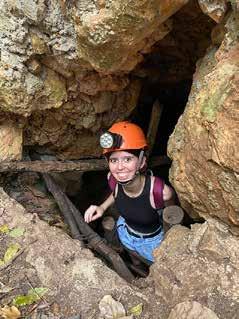
and explore its cave, where you’ll find impressive calcium carbonate “waterfalls.” If you’re the type to not leave any stone unturned, it’s better to choose an ATV tour with Tekax Adventours and visit both parks.
For lunch, have delicious, authentic, homemade regional food at Doña Mirna’s kitchen; then, take some time to rest and refresh. No matter which version of the tour you have chosen, you will likely feel like taking it easy.
In the evening, Centro offers various options for dinner. If you’re looking for traditional offerings, nothing beats a delicious lime soup or some Panuchos and Salbutes at Lonchería Gorocica, located at the entrance of Tekax.
Sunday
Experience a culinary adventure at the temporary municipal market and purchase the finest quality fruits and vegetables to bring back with you or carry on with your journey. For breakfast, try the legendary Tacos de Us; you’re guaranteed to love them.
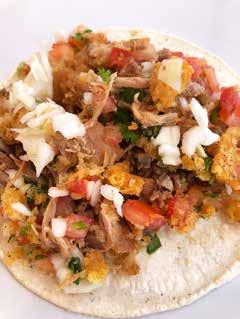
Complete your adventure in Tekax at the eastern end of the Puuc region: the archaeological site of Chacmultún. Its murals and Grand Ball Court bear witness to the city’s importance during the Maya Postclassic period. To get there, you have to pass through several Maya communities such as Canek, San Marcos, and Kancab; don’t miss the opportunity to get to know them and interact with the locals, who are always delighted to receive visitors and show you their homes, workshops, traditional kitchens, and much more.
As we mentioned earlier, if your itinerary has a few extra days, Tekax is also an excellent base for exploring the region. The Magical Town of Maní, for example, is only a 35-minute drive away and it’s another place that is definitely worth including in your plans.
It is clear this Magical Town has plenty to offer to anyone who visits it, as both young and old are guaranteed unique moments. So if adventure is something you have been waiting for, Tekax is the perfect place to start.
Visit www.yuc.today/230819 for the full version of this article, with more photos, and options for food and lodging to complement your visit.
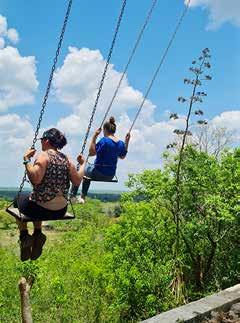
20 ¡Dónde ir y Cómo!
• • • E Tekax Ayuntamiento
Gruta Chocantes
Parque Kaalmankal Taco de chicharra en los Tacos de Us
FOTO: YUCATÁN TODAY
FOTO: OLIVIA CAMARENA CERVERA
FOTO: YUCATÁN TODAY
ACERCA DE YUCATÁN • ABOUT YUCATÁN
l estado de Yucatán se encuentra poblado por aproximadamente dos millones de personas. Al suroeste colinda con el estado de Campeche, al sureste con el estado de Quintana Roo, y al norte con el Golfo de México. Sus principales industrias están relacionadas con el turismo, la construcción, la pesca, la producción de puerco y aves, la manufactura y otros servicios.
Yucatán es parte del territorio que ocupó la civilización maya, particularmente conocida por sus estudios avanzados de astronomía, matemáticas y medicina, además de la fundación de grandes ciudades, cuyos vestigios sobreviven hasta el día de hoy.
La capital del estado, Mérida, fue fundada por Francisco de Montejo y León “El Mozo” en 1542. A partir de entonces, los españoles ejercerían en el estado una enorme influencia religiosa y cultural que duraría tres siglos, pero no sin resistencia. En 1847, por ejemplo, estalló la Guerra de Castas entre la población maya y la de origen español; entre sus causas figuraban las terribles condiciones laborales que se volvían más comunes debido a la creciente industria de henequén en Yucatán. Hacia el final del conflicto (que no tuvo una resolución como tal), Yucatán se consolidó como el principal productor de fibras del mundo, lo cual llevó a un tiempo de prosperidad económica en el estado, visible en la opulencia de las antiguas haciendas y casonas del Paseo de Montejo.
La cultura yucateca de hoy es definitivamente mestiza: una mezcla de la maya y la española, que incluye a menor grado influencias como las de Francia, Cuba, Países Bajos, Corea y Líbano, lo cual puede verse particularmente en nuestra cocina regional y arquitectura.

La lengua maya aún se habla extensamente, con aproximadamente 520,000 hablantes nativos en el estado. El español que se habla en Yucatán frecuentemente emplea palabras de origen maya, tales como “tuch” (ombligo) o “xiix” (el resto de algo). Este dialecto tiene un gran significado en la identidad cultural de nuestra región.
Con el tiempo, la influencia de diferentes culturas y la belleza natural de la península la han convertido en un destino que lo tiene todo. Camina por las calles de ciudades coloniales y pueblos mágicos; visita haciendas históricas; nada en las aguas cristalinas de nuestros cenotes, playas y ojos de agua; explora grutas misteriosas; baila al ritmo de
la jarana, trova y bolero; y disfruta deliciosa gastronomía con raíces precolombinas. ¡Ya queremos que conozcas nuestro estado!
The state of Yucatán is populated by approximately two million people, and is bordered by the state of Campeche to the southwest, the state of Quintana Roo to the southeast, and the Gulf of México to the north. Its main industries are related to tourism, construction, fishing, pork and poultry production, manufacturing, and other services.
Yucatán is part of the territory where the Maya civilization originated, thrived, and stood out for its people’s advancements in astronomy, math, architecture, and medicine.
The state capital, Mérida, was founded by Francisco de Montejo y León “El Mozo” in 1542. From then on and for three centuries, the Spanish colonizers would wield a heavy religious and cultural influence throughout the region, although definitely not without resistance. In 1847, for example, the Guerra de Castas (Caste War) broke out between the Maya and the population of Spanish descent, caused partly by the terrible working conditions in the growing henequén industry. Towards the end of the conflict (which was ultimately never formally resolved), Yucatán established itself as the world’s most important suppplier of natural fibers, which led to a time of economic prosperity in the state.
Today’s Yucatecan culture is definitely “Mestizo,” a mix of Spanish and Maya, and to a lesser degree other influences such as French,
Cuban, Dutch, Korean, and Lebanese, which can be seen and felt in our regional cuisine and architecture.
The Maya language is still widely spoken by approximately 520,000 native speakers throughout the state, but even the Spanish spoken in Yucatán employs words of Maya origin such as “tuch” (bellybutton) and “xiix” (the last bit of something). Language holds enormous significance to the cultural identity of the region.
With time, the influence of different cultures and the natural beauty of the peninsula have created a destination which has it all. Walk through the streets of colonial cities and Pueblos Mágicos; visit historic haciendas; dive into our clear, blue cenotes, beaches, and natural springs; explore mysterious caves; dance to the rhythm of Jarana, trova, and bolero; eat delicious food with pre-Columbian roots; and let yourself be charmed by the kindless of the locals. We can’t wait for you to see our state!

21 Where To Go and How!
E
FOTO: FELIX CUTZ
Vaquería, Tizimín
érida se ubica en el noroeste de Yucatán y es la capital del estado. Con cerca de un millón de habitantes en su área metropolitana, también es la ciudad más poblada de la Península y una de las ciudades con mayor crecimiento en todo México. Puede que esto te sorprenda, porque cuando nos visites verás que Mérida mantiene las tradiciones, las costumbres y el encanto que pocas ciudades modernas pueden presumir.
La ciudad fue fundada en 1542 por Francisco de Montejo “El Mozo” sobre los restos de la ciudad maya T’hó. Fue él quien la bautizó como Mérida, por su ciudad natal en España. Estas raíces mayas y coloniales están aún muy visibles en muchos de los edificios del Centro Histórico al día de hoy; incluso se pueden llegar a observar en un mismo edificio, como es el caso de la Catedral de San Ildefonso y la Iglesia del Jesús, ambas construcciones coloniales con glifos mayas claramente visibles.
Las principales áreas de interés para los visitantes suelen ser el Centro Histórico y Paseo de Montejo. Estos son ideales para explorar por la mañana y tarde gracias a los tradicionales barrios y mercados, espléndidas casonas, así como museos y monumentos históricos. Pero no te equivoques, también de noche están llenos de vida, gracias a que

en años recientes se han establecido numerosos restaurantes y bares modernos que mantienen vibrantes al Centro y Montejo a todas horas.
Nuestro clima tropical, arquitectura, calidez humana, proximidad a la playa y formaciones geológicas impresionantes, como cenotes y grutas, han enamorado a más de uno que ha “tomado agua de pozo”, un dicho local para aquellos visitantes que terminan quedándose para siempre. Esto ha ocasionado que la ciudad tenga una influencia más internacional, incluyendo nuevas y diversas ofertas gastronómicas.
Esperamos que disfrutes nuestros museos, recorridos, actividades culturales gratuitas disponibles todas las noches de la semana, centros comerciales grandes y pequeños, tiendas de artesanías y, sobre todo, los deliciosos sabores de nuestra comida regional y nacional. Cuando estés satisfecho, sabemos que seguirás gozando tu aventura al descubrir el resto de nuestro estado.
¡Bienvenido a Mérida!
érida is located in the northwestern part of Yucatán and is the capital of the state. With close to one million residents in the metropolitan area (accounting for roughly half of
the state’s population), it is also the most populated city in the Yucatán Península, and one of the fastest growing cities in México. You might be surprised by this, because once you’ve visited our city, you’ll see that it maintains the traditions, customs, and old-city charm that few cities can boast.
It was founded in 1542 by Francisco de Montejo “El Mozo,” on the remains of the Maya city of T’hó, and was named Mérida after his own hometown in Spain. These Maya and colonial roots are still very visible in the buildings of the Centro Histórico today. Sometimes, you can even see both represented in the same building, such as on the Catedral de San Ildefonso which is a colonial construction; if you look very closely, you will see Maya glyphs etched on the stones of the building.
The main areas of interest for visitors are usually the Centro Histórico and Paseo de Montejo. Here, we find the traditional city “barrios” and markets, grandiose homes, several museums, and historical monuments, which make them ideal for exploring in the morning and afternoon. But don’t be fooled, these areas are equally lively in the evenings, as in recent years they have seen the birth of many modern restaurants, entertainment venues, and bars which keep Centro and Montejo buzzing throughout the whole day.

Our tropical climate, architecture, warm people, proximity to the beach, and impressive geological formations such as cenotes and caves have enamored more than one visitor who “tomó agua de pozo”—or “drank from the well,” a local saying of visitors who wind up staying forever. This has caused the city to have an increasingly international fame which includes a growing renowned and diverse food scene.
We hope you enjoy our museums, city tours, free cultural activities available every night of the week, shopping centers both big and small, handcraft shops, parks, friendly locals, and especially, the delicious flavors of our regional and national cuisine. When you’ve had your fill, we expect you’ll continue to enjoy your time adventuring through the rest of our state. Welcome to Mérida!
22 ¡Dónde ir y Cómo! ACERCA DE MÉRIDA • ABOUT MÉRIDA
M M
Palacio Municipal de Mérida
FOTO: JUAN MANUEL MIER Y TERÁN C.
no de los lugares más icónicos de la ciudad de Mérida es el espléndido Paseo de Montejo que es sin duda no sólo la más bella avenida de nuestro estado, sino también la más importante. Gracias a los frondosos árboles, así como diversos hoteles, cafés y restaurantes que delinean la avenida, es conocida como “los Campos Elíseos” de Mérida.
El majestuoso boulevard fue inaugurado en 1888 para conmemorar al fundador de la ciudad de Mérida, Francisco de Montejo y León, justo en el marco de una época de gran prosperidad económica debido a la producción del henequén, el “oro verde”, en el estado, que era exportado a todo el mundo. Esta riqueza sin precedentes vio nacer las majestuosas casonas y mansiones familiares. Con el tiempo, muchas de las mansiones de esta avenida terminaron siendo abandonadas y luego convertidas en bancos, museos o restaurantes, tales como Montejo 495, Casa Museo; Yerba Santa o el Palacio Cantón, hogar del Museo de Antropología e Historia.
La mejor forma de recorrer esta avenida es caminando bajo la sombra de sus árboles. Empieza por El Remate del Paseo de Montejo (por la Calle 47) y dirígete hacia el norte. Pasarás llamativos restaurantes, glorietas con historias especiales, simpáticos cafés, irresistibles tiendas, y bares acogedores. Llega al Monumento a la Patria y regresa por el otro lado de la avenida para ver lo que se ha instalado ahí con el tiempo.
Caminar por esta avenida es un nostálgico viaje al pasado de Yucatán; pero no hay que olvidar que también es parte de su vibrante presente. Una gran variedad de actividades culturales se presentan aquí cada semana, tal como la Noche Mexicana cada sábado a partir de las 8 pm en el Remate
y la Biciruta y Corredor de Arte todos los domingos a partir de las 8 am. El Mercado de Santa Ana, justo al lado del Remate es algo que no puede faltar en tu lista para una experiencia gastronómica yucateca.
ne of the most iconic places in the city of Mérida is Paseo de Montejo, which is the most beautiful and important avenue in our state. Thanks to the lush tropical vegetation, along with many hotels, cafés, and restaurants that line the streets, it’s known as Mérida’s “Champs Elysées”.
This majestic boulevard was inaugurated in 1888 to commemorate the city’s founder, Francisco de Montejo y León, and was built in the midst of an era of great economic prosperity: back then, Yucatecan sisal fibers were being exported to countries around the world to make rope and textiles. This unprecedented wealth saw the birth of grand mansions that served as family homes, built in the European style that was popular at the time, many times with materials imported from all over the globe. As the families moved away, the mansions turned into banks, museums, and restaurants, such as Montejo 495, Casa Museo; Yerba Santa; or the striking Palacio Cantón,
¿YA SABÍAS? / DID YOU KNOW?

Fue construido en 1888 en honor del fundador de Mérida.
Inicia en la Calle 47 y termina en el Monumento a la Patria.
¡También tiene mucha cultura!
Visita sus increíbles museos, como Montejo 495, Casa Museo; El Minaret y el Palacio Cantón.
It was built in 1888 to celebrate Mérida’s founder.
It begins at Calle 47 and ends at the Monumento a la Patria.
It’s also full of culture! There are incredible museums to discover, such as Montejo 495, Casa Museo; El Minaret, and Palacio Cantón.
home to the regional Anthropology and History Museum and its impressive Maya exhibits.
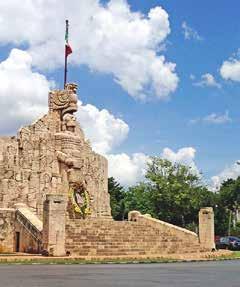
The best way to explore this promenade is by walking under the shade of its lush and abundant trees. Start at El Remate de Paseo de Montejo (the beginning, at Calle 47) and take a stroll up one side of the avenue. You will pass both traditional and modern restaurants, roundabouts with fascinating stories behind them, cute cafés, irresistible stores, and cozy bars. Once you reach the Monumento a la Patria, snap a picture, and then walk back south on the other side of the street.
Walking down Paseo de Montejo is a nostalgic trip to Yucatán’s past, but one mustn’t forget that it’s also a part of its vibrant present. Different cultural activities take place here each week, such as the Noche Mexicana, an event that happens every Saturday at El Remate at 8 pm, as well as the Biciruta and Art Corridor, which you can find on Sunday mornings starting at 8 am. The Santa Ana Market, right next to El Remate, is also something that has to go on your list for a very foodie experience.
24 ¡Dónde ir y Cómo!
U O
PASEO DE MONTEJO
FOTO:
PASOS
Monumento a la Patria
LAURA
¡110 Años!
Breve Historia de la Residencia
Ernesto y María Cámara Zavala en 1904 le comisionaron al afamado y premiado arquitecto francés Gustave Umbdenstock los planos originales.
En 1964, Fernando Barbachano Gómez Rul adquiere la residencia y con su esposa e hijos hacen de ésta su hogar. La familia Barbachano Herrero la ha vivido ininterrumpidamente hasta el día de hoy.
Construida como la residencia más moderna de su época, Montejo 495, Casa Museo no ha tenido modi caciones ni en su estructura, ni en su estilo; la decoración es original de principios del siglo XX; conserva los muebles de manufactura Francesa, comisionados a los mas renombrados ebanistas de París; sus premiadas lamparas de Baccarat; sus cuadros y esculturas re ejan el exquisito diseño Art Nouveaux muy apreciado en Yucatán durante el auge henequenero.
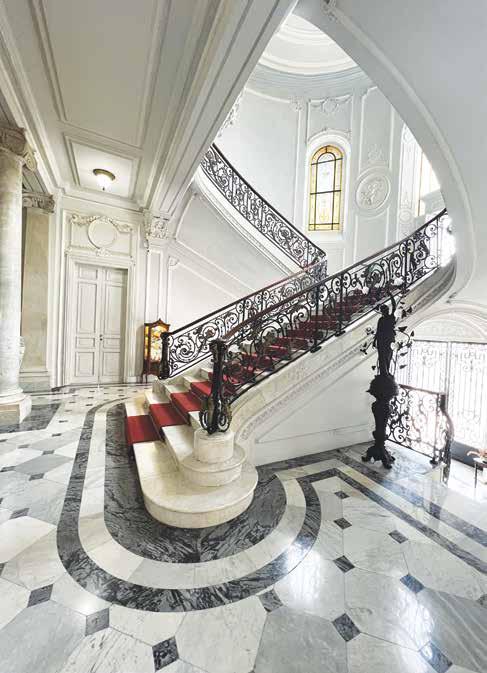
Más allá de la larga lista de personalidades que han convivido con la familia Barbachano. Montejo495, Casa Museo, es un hogar que re eja en cada rincón la historia de esta afamada familia pionera de la industria turística en México.

Visitas Guiadas - Guided Visits Martes a Domingo de 9 am a 5 pm 999 924 0037 • 999 995 6761 • montejo495 Paseo de Montejo 495, Esquina 45, Centro, Mérida de Yucatán, México 97000 www.montejo495.com
Monumento Histórico de México y Patrimonio Cultural de Francia en el Exterior



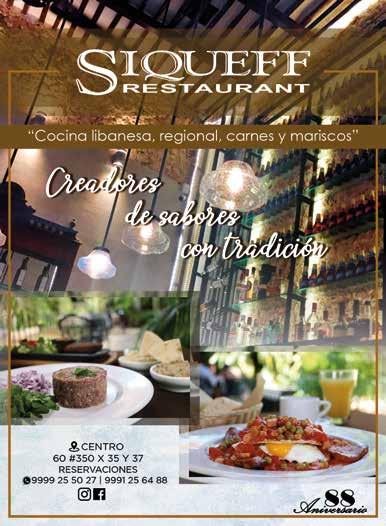
Hoy en día, lo que conocemos como “el centro” de Mérida abarca una superficie de unos 10 kilómetros cuadrados; sin embargo, durante mucho tiempo, ésta fue la extensión total de la ciudad. El centro era, básicamente, la Plaza Grande, y todo a su alrededor, los barrios residenciales, distribuidos alrededor de sus respectivas iglesias.
Actualmente, el centro de Mérida se divide en ocho barrios, muy distintos a las colonias que se encuentran fuera de él. Hay muchos motivos para amar los barrios: su arquitectura, monumentos históricos, dinámica vida cotidiana, diversidad gastronómica. En la página 26 te hablaremos de Santa Lucía, y aquí, sobre San Sebastián, La Ermita y San Juan. Para saber sobre los cuatro restantes (Santa Ana, Santiago, Mejorada y San Cristóbal) continúa leyendo en nuestro sitio web.
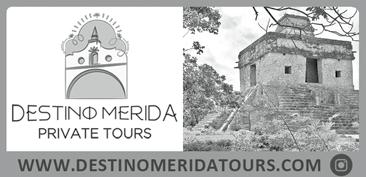
San Sebastián (Calle 70 x 75): Es uno de los más antiguos y de mayor tradición en Mérida, y sigue siendo residencial. Cuenta con un diverso mercado; su iglesia está dedicada a la Virgen de la Asunción. Cada agosto se realizan peregrinaciones y gremios en honor de la Santa Patrona. Tiene valor gastronómico inigualable al ser la cuna del panucho y la sede del Festival del Pib, delicia yucateca que se realiza para el Día de Muertos.
La Ermita (Calle 66 x 79): La Ermita de Santa Isabel se encuentra en el corazón del que podría ser el barrio más singular de los ocho. En la plaza se encuentra un kiosco que acompaña a la iglesia, y que está rodeado por muy lindo jardín con bancas, enmarcado por hermosas casonas de estilo colonial; las calles de adoquín y su particular trazo, evocan la historia de la Ermita como el límite de la ciudad y última parada antes de salir al Camino Real a Campeche.
San Juan (Calle 64 x 69): La iglesia alrededor de la cual se asienta este barrio fue construida por ahí de 1770; la plaza que se encuentra frente al templo se estableció en 1883. Fue poco después que la plaza se fue adornando, por ejemplo, con la fuente de “La Negrita”, que hasta hoy podemos ver y que fue traída de París a principios del siglo XX. En este barrio encontrarás la mayoría de los sitios de taxis que salen de Mérida.
Conoce los demás barrios aquí: www.yuc.today/barrios-merida
NO TE LO PIERDAS

San Sebastián Panuchos frente al parque El campo de softbol
La Ermita
El jardín a un costado de la iglesia Marquesitas en el parque
San Juan
El monumento a Benito Juárez, erigido en 1909 La fuente de “La Negrita”
The area we currently know as “Centro,” the city’s historical center, covers about 4 square miles; however, for a long time, that was the extension of the entire city. The center back then was the main square, and everything around it, the city’s Barrios or neighborhoods.
So now we consider the Centro to be divided into eight Barrios, very different in name and concept to the Colonias (also neighborhoods) that make up the city today. There are plenty of reasons to love our Mérida’s Barrios: their architecture, historical monuments, their food— you take your pick. You’ll read about Santa
Lucía on page 26; in this issue, we’ll be telling you about San Sebastián, La Ermita, and San Juan. To learn about the other four (Santa Ana, Santiago, Mejorada, and San Cristóbal), visit the link at the end of this page.

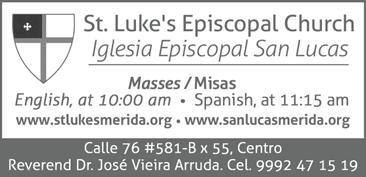
San Sebastián (Calle 70 x 75): One of the oldest, most traditional Barrios in Mérida. It features a very diverse market, and a church devoted to Our Lady of the Assumption. Every year, in August, there are regional parades in her honor. Plus, it offers amazing gastronomic value, as it is the birthplace of Panuchos and home of the Festival del Pib, a Yucatecan delicacy made for Janal Pixan (our Día de Muertos).
La Ermita (C. 66 x 79): An Ermita refers to a somewhat remote religious temple, where there aren’t regular services as it is usually on the outskirts of a community. This one is devoted to Saint Elizabeth. The square across the church features a lovely gazebo, and a garden with benches, surrounded by colonial-style homes. The stone-lined streets and their peculiar layout evoke the history of the Ermita as being beyond the city limits, the last stop for travelers taking the Camino Real (royal road) to Campeche.
San Juan (Calle 64 x 69): The church in this Barrio was built around 1770; the square across from it was established in 1883. It was from then on that the beautification of the area began, like“La Negrita” fountain we can see to this day, which was brought from Paris in the early 20th century. This Barrio is where you’ll find most of the public transportation vans going from Mérida to most towns in the state.
Visit www.yuc.today/meridas-barrios to learn about more Barrios.
NOT TO MISS
San Sebastián Panuchos by the park
The softball field
La Ermita
The garden by the church Marquesitas at the park
San Juan
The monument to Benito Juárez, built in 1909
The “La Negrita” fountain
25 Where To Go and How!
LOS BARRIOS DEL CENTRO DE MÉRIDA • THE BARRIOS IN MÉRIDA’S CENTRO
FOTO: GOBIERNO DEL ESTADO
San Sebastián
l Barrio de Santa Lucía se ha convertido en una de las zonas favoritas del Centro Histórico. Tiene un pasado lleno de historia y vida gracias a que es una de las áreas más antiguas de la ciudad.
Entre los principales atractivos del barrio están la iglesia y el parque (ambos ubicados en Calle 60 x 55). Los inicios de esta área remontan a 1565, tan sólo unos años después de la fundación de Mérida. Lo que ahora conocemos como Santa Lucía empezó únicamente como una ermita y plazuela para los servicios religiosos de los esclavos y fungió así por varios años. Fue hasta 1804 que se construyó la agradable plaza que conocemos hoy en día y que se fue modificando a lo largo de los años.
La amplia gama gastronómica de la zona incluye restaurantes ubicados dentro de los arcos del parque y en las calles aledañas. Podrás disfrutar desde modestos esquites y marquesitas en puestos ambulantes, hasta sofisticados platillos inspirados en sabores mexicanos e internacionales.
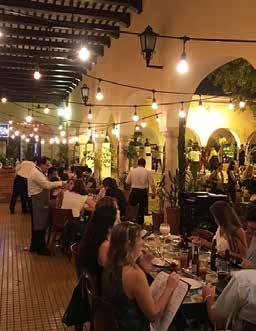
Aprovecha caminar por las calles del barrio para contemplar arquitectura colonial, hoteles boutique e irresistibles tiendas para comprar el regalo ideal; una excelente opción es Between the Lines, en Plaza Carmesí, donde encontrarás libros, papelería y mucho más (Calle 62 x 53). Si sientes mucho calor, encontrarás opciones de helados y frappés para refrescarte mientras te sientas en alguna de las bancas o te tomas una foto en la Sillas Confidentes gigantes del parque y disfrutas de sus áreas verdes que dan un ambiente muy tropical.
Si coincides con este parque un jueves por la noche, quédate a la Serenata a disfrutar la música y los bailes que han sido tradicionales de esta sede desde 1965. Si visitas
un domingo por la mañana, deléitate con los mejores pasos de baile de nuestros residentes y únete a ellos si lo deseas. También puedes visitar el mercado que se instala ahí en este día o la clásica Biciruta que pasa por la calle 60.
Vístete fresco y disfruta uno de los barrios más queridos y tradicionales de la ciudad.
NO TE LO PIERDAS / WHAT TO SEE
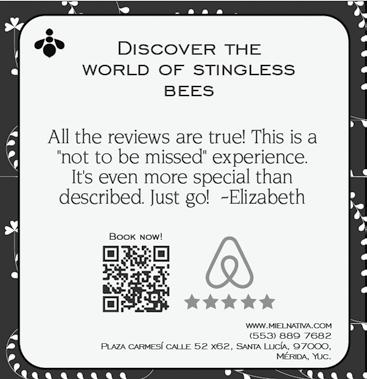
La Serenata, jueves 9 pm.
· Restaurantes bellos.
· Tiendas boutique y de artesanías.

· Una foto en las “Sillas Confidentes” gigantes.
· The Serenata, Thursdays 9 pm.
· Charming restaurants.
· Boutiques and handcraft shops.
· A selfie in the giant “Confidente” chairs.
Today, Santa Lucía has become one of the Centro Histórico’s favorite areas, but it also has a past that’s full of history because it’s one of the city’s oldest neighborhoods.
Amongst Santa Lucía’s main attractions are the church and the park (both located on Calle 60 x 55). This area’s beginnings go way back to 1565, just a few years after the founding of the city of Mérida. What we now know as Santa Lucía started out just as a shrine for slaves to hold their religious services, and it continued this way for many years. The pleasant plaza we know today wasn’t built until 1804 and has been modified throughout the years.
The zone’s culinary offering includes restaurants that are located both in the archways of the park and on nearby streets. You can enjoy everything from modest Esquites and Marquesitas served by food carts, to sophisticated dishes inspired by Mexican and international flavors.
Walk down the streets of Santa Lucía and gaze at colonial architecture, boutique hotels, and
irresistible stores to pick up the perfect souvenir; among them stands out Between the Lines, where you’ll find books, stationery and more (Calle 62 x 53). If you’re feeling particularly hot, you’ll find refreshing ice creams and frappés that will help you cool off while you sit on one of the park benches, snap a picture in the giant Confidente chairs, or just wander around enjoying the green gardens and tropical ambiance.
If you’re around on a Thursday evening, stay for the Serenata and enjoy the traditional shows that has been held each week since 1965, and which combines traditional Trova singers with Jarana dancers, and other performances. If you’re at the park on a Sunday morning, you’ll also have plenty to see and do. Check out some sweet dance moves and join in if you’d like. You can also visit the market that sets up there or the classic Biciruta that runs up Calle 60.
Dress nice and cool, and enjoy one of Mérida’s most beloved Barrios.
26
SANTA LUCÍA FOTO:YUCATÁN TODAY
Apoala, Santa Lucía
© YUCATÁN TODAY Calle 60 Calle 62 Calle 55 Iglesia de
Parque de
Ki’Xocolatl Hacienda
Chuc
Best Car Rental Biblioteca Central Estatal Central State Library Calle 53 ·
·
Artesanaria Hda.
Point ¡Dónde ir y Cómo!
Santa Lucía
Santa Lucía
Teya
Estacionamiento Parking
Between the Lines
Miel Nativa
Sotuta de Peón Pick Up
l clima tropical, el estilo de vida relajado y las calles seguras de Mérida la han convertido en una de las ciudades de más rápido crecimiento en el país. El Centro Histórico siempre será el lugar de museos, galerías, eventos culturales y la hermosa arquitectura colonial. Sin embargo, se ha visto un fuerte crecimiento en los alrededores de la ciudad; entre los más importantes, en el norte de Mérida.
Esto se está reflejando sobre todo en la incorporación de poblaciones que antes se consideraban pueblos independientes, como ha sido el caso de Dzityá, Temozón Norte, Cholul y Conkal. Esto significa que hay una amplia variedad de inmuebles nuevos en esta zona; la oferta incluye departamentos, condominios, casas y townhouses con todo tipo de amenidades, y que además se encuentran cerca de importantes centros educativos, comercios y servicios de salud.
Tanto el norte como el centro ofrecen todo tipo de comercios nacionales e internacionales, incluyendo una amplia variedad de restaurantes, tiendas y muchos otros productos y servicios. Una importante diferencia entre la vida en el centro y el norte de la
ciudad es la accesibilidad peatonal: el norte está hecho para ser experimentado en auto, y las opciones de transporte público son algo limitadas.
El norte de la ciudad, sin embargo, destaca por su amplia oferta de productos y servicios, especialmente dentro de plazas comerciales de lujo. Éstas ofrecen (además de tiendas, restaurantes y supermercados) eventos para niños y mascotas, opciones de entretenimiento que van desde salas de cine hasta auditorios para conciertos, e incluso actividades como tirolesa, kneeboarding o patinaje sobre hielo (¡imagínate eso en Yucatán!).
Además, el norte de Mérida se ha convertido en el epicentro de servicios de salud para el sureste mexicano al tener excelentes hospitales como Star Médica, el Hospital Regional de Alta Especialidad y El Faro del Mayab.
The tropical climate, laid-back lifestyle, and safe streets of Mérida have made it one of the fastest-growing cities in México. The Centro Histórico will always be the place for museums, galleries, cultural events, and beautiful colonial architecture. However, there has been significant growth in the suburbs; among the most important, in the north of Mérida.
This is especially visible as areas that used to be considered independent villages, such as Dzityá, Temozón Norte, Cholul, and Conkal, are now part of the city. This means there is a wide array of new real estate offerings in the area, including apartments, condos, houses and townhouses with all sorts of amenities; they all boast their closeness to the most important educational, shopping and healthcare centers.
In north Mérida, you can definitely find all kinds of national and international businesses, including a wide range of restaurants, specialized stores, shopping malls, and many other products and services. An important difference between life in Centro and Norte is that in the latter it’s much harder to get by without a car; distances are longer, and public transportation options are limited.
Still, north Mérida stands out for the many products and services it offers, especially within luxury shopping malls. These offer (in addition to stores, restaurants, and supermarkets), events geared at children and pets, entertainment options ranging from multiplexes to concert halls, and even activities like ziplining, kneeboarding, or ice skating (in Yucatán? Who’d have thought?).
Mérida has also become the epicenter for health-related services for México’s southeast. There are excellent hospitals in the north part of the city such as Star Médica, Hospital Regional de Alta Especialidad, and El Faro del Mayab.
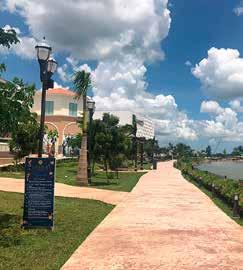
27 Where To Go and How! MÉRIDA NORTE • NORTH MÉRIDA FOTO: LA ISLA La Isla · Ábito LOMA BONITA XCUMPICH CAMPESTRE CHUBURNÁ SAN RAMÓN NORTE SANTA GERTRUDIS COPÓ BENITO JUÁREZ NORTE SOL CAMPESTRE CORDEMEX MONTECARLO MÉXICO NORTE MONTEALBÁN MONTEVIDEO VILLAS LA HACIENDA Tecnológico Calle 17 Calle 17 Calle 40 Calle 21 Calle 38 Calle 42 Calle 19 Calle 22 Calle 19 Calle23 Calle 10 Calle 23 Calle 71 Calle33 Calle 39 Prol.Montejo ShutánMedina Campestre Calle 9 Calle 5 Calle18 Calle 33 Periférico Periférico Calle23 Calle36Diagonal Andrés García Lavín PASEO DE MONTEJO CENTRALES SALIDA Progreso 36 km Hacienda Xcanatun 3 km Dupuis A 6 3 e l l a C Av.Dr.Fdo.Dájer CámaradeComercio Av. Líbano Calle 20 • CENTERFOLD Gran Plaza Sam’s Club Plaza Galerías Chedraui Costco Gran Museo del Mundo Maya Mangus City 32 Faro del Mayab La Isla Cabo Norte City Center Victory Platz Town Square Siqueff Meridano Inmobiliaria · Lagos Taverna Griega · Maya de Asia · Secretaría de Relaciones Exteriores Texas Roadhouse The Harbor Alta Especialidad Altabrisa Monumento a las Haciendas Club Campestre Ki’Xocolatl Calleveinte Merci · Ábito · Ki’Xocolatl Glorieta El Centrito Glorieta El Pocito Sanbravo Uptown Mérida Star Médica
Dr. Javier Cámara · Ábito · Ki’Xocolatl
· Urología del Sureste
Real Kantoyná
© YUCATÁN TODAY
Siglo XXI
E
Altabrisa, City Center, City 32, Galerías Mérida, La Isla, Plaza Mangus, The Harbor y Uptown.
PLAZAS / MALLS MÉRIDA NORTE
TODAS LAS DISTANCIAS SON PARTIENDO DEL CENTRO DE LA CIUDAD • ALL DISTANCES SHOWN ARE FROM DOWNTOWN
by Angsana 12
· Lagos Taverna Griega
· Maya de Asia
Oficina Municipal de Atención a Migrantes
FRANCISCO DE MONTEJO
THE HARBOR
PLAZA LAS AMÉRICAS
Dupuis PLAZA DORADA
Faro del Mayab
Ábito
LA ISLA
Texas Roadhouse ·
MONTES DE AMÉ PLAZA GALERÍAS CITY CENTER MANGUS
CHOLUL
Costco
GRAN PLAZA Gran Museo del
BENITO JUÁREZ
Sam's Club
XCUMPICH MÉXICO NORTE
VICTORY PLATZ
Club Campestre
MONTECRISTO
PLAZA ALTABRISA
MAYA
MACROPLAZA
GARCÍA GINERÉS
PLAZA FIESTA
ITZIMNÁ
Óptica Parque de
INALÁMBRICA
ALEMÁN
JESÚS CARRANZA
CENTRO
General / Cemetery
PLAZA ORIENTE Unidad Deportiva Kukulcán
AEROPUERTO INTERNACIONAL MANUEL CRESCENCIO REJÓN
MELITÓN SALAZAR
DOLORES OTERO
AZCORRA VERGEL SANTA ROSA
REPARTO GRANJAS
SAMBULÁ KANASÍN
SERAPIO RENDÓN
Reserva Ecológica Cuxtal / Park
28 ¡Dónde ir y Cómo! 20 SALIDA 21 SALIDA 1 SALIDA 3 SALIDA 2 SALIDA 4 SALIDA 6 SALIDA 7 SALIDA 11 SALIDA 14 SALIDA 13 SALIDA 16 SALIDA 18 SALIDA 9 SALIDA 8 SALIDA Ruta de los Conventos Tixkokob 25 km Hda. San José 38 km Z.A. Aké 38 km Hacienda Sotuta de Peón 33 km Conkal 17 km Real Kantoyná Baca 35 km Motul 47 km San Crisanto 80 km Marcrisanto Tizimín 170 km Río Lagartos 218 km Las Coloradas 236 km Celestún vía Tetiz 90 km Hda. Xcanatun
Foro GNP 14 km Club de Golf La Ceiba 14 km Univ. Anáhuac Mayab 15 km Yucatán Country Club 15 km Dzibilchaltún 16 km Progreso 36 km Bayside Real Estate Telchac Puerto 62 km Hacienda Teya 13 km Tekit 69 km Izamal 72 km Chichén Itzá 120 km Tekax 130 km Hotel Cielo y Selva Valladolid 160 km Cobá 220 km Tulum 266 km Playa del Carmen 290 km Cancún 306 km Isla Mujeres 330 km Umán 16 km Campeche 180 km Hda. Temozón 42 km Maxcanú 65 km Hda. Santa Rosa 75 km Uxmal 80 km Choco-Story 80 km Halachó 81 km Ticul 84 km Kabáh 102 km Oxkutzcab 113 km Hacienda Petac 20 km Hunucmá 30 km Sisal 53 km Chelem 45 km Chuburná Puerto 50 km Loltún 118 km Labná 118 km Xlapak 121 km Sayil 126 km Campeche 174 km Chetumal 386 km Villahermosa 560 km CDMX 1314 km 18 180 180 80 176 261 281 261 PÁGINA 30 CENTRALES PÁGINA 25
km
Prol.Montejo Av.RepúblicadeCorea Paseo de Montejo García Lavín Circuito Colonias Mérida 2000 Juan Pablo II JacintoCanek Calle2A Calle22 Calle 59 Reforma CalleCalle65 69 Calle 50 Calle 60 Calle 86 Calle66 Calle 42 Calle 28 Calle27 Yucatán Calle 35 Calle 39 Tecnológico Periférico Periférico Periférico Periférico Periférico Alemán Calle 21 Calle 21 Calle51 Calle7 Colón Itzáes Cupules Periférico CorreaRachó Aviación NORA QUINTANA PENSIONES TANLUM FRACC. DEL PRADO CHUBURNÁ CAMPESTRE LOS PINOS SANTA MARÍA CHICHÍ SUARÉZ POLÍGONO 108 JARDINES DE MÉRIDA FIDEL VELÁZQUEZ CHUMINÓPOLIS CAUCEL CIUDAD CAUCEL SUSULÁ TIXCACAL ITZINCAB XCANATÚN DZITYÁ LAS AMÉRICAS CONKAL ALTABRISA SAN JOSÉ TECÓH SAN ANTONIO XLUCH CINCO COLONIAS EMILIANO ZAPATA EL ROBLE CIUDAD INDUSTRIAL MULSAY XOCLÁN BOJÓRQUEZ MÉXICO BUENAVISTA
Hospital de
Especialidad Chedraui Control Odontológico IMSS Sam's Club Chedraui Spanish Center Mérida Chedraui Acuaparque Chedraui Chedraui Texas Roadhouse Caucel IMSS IMSS Cruz Roja IMSS IMSS IMSS IMSS IMSS IMSS CMA IMSS
Siglo XXI
Alta
Feria Yucatán
XMATKUIL:
Cementerio
Centenario / Zoo
Boulevard
Xoclán
/ Cemetery
Animaya / Zoo
Infante
Cementerio
ENCUENTRA MÁS NEGOCIOS EN LOS MAPAS DE AMPLIACIÓN YOU CAN FIND MORE BUSINESSES ON ENLARGED AREA MAPS Star
Mundo Maya
la Alemán
•
© YUCATÁN TODAY
· Secretaría de Relaciones Exteriores
Parque Recreativo de Oriente MAPA / Ciudad de Mérida
MAP / Mérida City
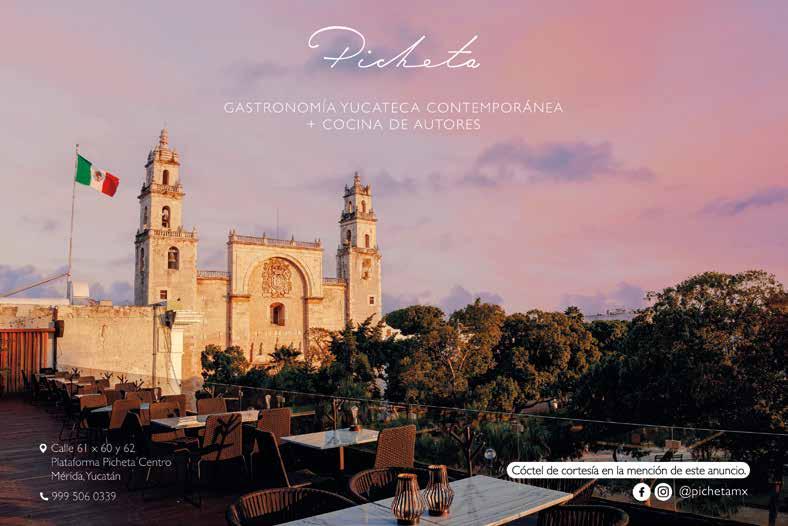





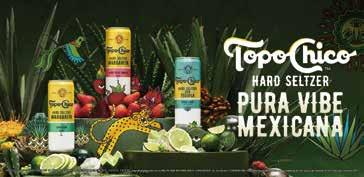



Colonia Centro Fraccionamiento del Norte Colonia Jesús Carranza Colonia Itzimná Colonia México Colonia Yucatán Colonia Buenavista Colonia Pedregales de Tanlum Colonia Campestre Colonia Chuburná Av. Colón Av.Cupules Av. José Díaz Bolio Calle 60 Av. Alemán Circuito Colonias Circuito Colonias AvenidaCampestre Av.Reforma PaseodeMontejo Av.PérezPonce PASEO COLEGIO ROGER’S HALL SANJUANISTAS COLEGIO MÉRIDA LA PLANCHA (Art.123) Ferrocarriles MONUMENTO A LA PATRIA CIC CENTRO INTERNACIONAL DE CONGRESOS DE YUCATÁN ESTADIO SALVADOR ALVARADO TELMEX REMATE DE PASEO DE MONTEJO SANTA ANA ESAY SANTA LUCÍA ITZIMNÁ MÉXICO INM - INSTITUTO NACIONAL MIGRACIÓNDE Calle 47 Calle 45 Calle 43 Calle 43 Calle 35 Calle 51 Calle 55 Calle54 Calle50 Calle54 Calle46 Calle 42 Calle 64 Calle52 Calle56 Calle 33-A Calle 49 Calle 53 Calle 37 Calle 37 Calle44 Calle48 Calle 66 Calle 39 Calle60 Calle56 Calle62 Calle62 Calle58 Calle 41 Calle 41 Calle 33-B Calle62-A Calle 39 Calle 21 Calle20 Calle15 Calle33 Calle20 Calle 37 Calle 27 Calle36 Calle40 Calle 35 Calle20 Calle 21 Calle 21-A Calle 19 Calle7 Calle 13 Calle 35 Calle 60 Calle22Calle20 Calle Walmart Plaza de Toros Dr. Javier Cámara SoHo Galleries Centro de Artes Visuales Agustín Galería Las Cruces Consulado EUA Yaaxtal Trotter’s Palacio Cantón Yerba Santa Rosas & Xocolate Montejo 495 Fiesta Americana Villa Mercedes Paseo 60 CEM CMA La Negrita Café La Habana · La Mezca BC66 Casa Ki’ool · Between the Lines · Miel Nativa Café Alameda Artesanaria Quinta Montes Molina Hostik Hostal Cada día Bar-Café · Ábito · Café Kuun · Café Montejo · Los Almendros Yucatán Giving Outreach Teya MET Muebles en Tránsito Soriana Burger King · Café Orgánico · Mercado Slow Food Casa Consciente CENTRO PAG. 25 Siqueff La Pigua Catrín El Pinar Pan Montejo Trópico 56 Ábito Crabster Ki’Xocolatl Merci Teya Viva · María Raíz y Tierra · Asai Centro Comercial Colón Mexico International Real Estate Office Depot Galería Lux Perpetua Hamaka Professional Co. Hosting Casa Chica
Colonia Chuburná de Hidalgo
Colonia Gonzalo Guerrero
Colonia Juan B. Sosa
Colonia Xcumpich


Colonia Cordemex

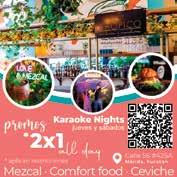


Colonia Sodzil Norte
Colonia Campestre
Colonia Villas La Hacienda
Colonia Benito Juárez Norte
Colonia Montes de Amé
Colonia San Ramón Norte
Calle 60 Calle 9
Cámara de Comercio
Av. Temozón
a Progreso
PROLONGACIÓN COSTCO CLUB CAMPESTRE DE YUCATÁN INSTITUTO TECNOLÓGICO DE MÉRIDA CENTRO DE CONVENCIONES SIGLO XXI GRAN MUSEO DEL MUNDO MAYA DE MÉRIDA SECRETARÍA DE SEGURIDAD PUBLICA UNIVERSIDAD MARISTA Centro Universitario Montejo DECATHLON INAH SAT SAM’S CLUB HOME DEPOT CHEDRAUI SELECTO LA GRAN PLAZA Calle 42 Calle 39 Calle 38 Calle 21 Calle 5B Calle 42 Calle 17 9 6 e l l a Calle 71 Calle 33 Calle 31 Calle 40 Calle 23 Calle 21 5 7 Calle 75 Calle20 CalleCalle1H 3 Calle1GCalle1FCalle1ECalle1D Calle 36C Calle 36D Calle 14 Calle 12 Calle 16 Calle 79 Uxmal & Ruta Puuc Aeropuerto Celestún Campeche Río Largartos Izamal Valladolid Cancún C PLAZA GALERÍAS 261 Dupuis Yucatán Country Club Hacienda Xcanatún by Angsana Foro GNP Plaza La Ceiba Club de Golf La Ceiba Dzibilchaltún Progreso Bayside Real Estate Telchac Puerto Dzityá Feria Tunich Sanbravo Starbucks · Ábito · Ki’Xocolatl THE HARBOR · Lagos Taverna Griega · Maya de Asia · Secretaría de Relaciones Exteriores Walmart Express Espacio Quiropráctico Francés Texas Roadhouse
ProlongaciónMontejo
o c i r é f i r e P
Carretera
PASEO DE MONTEJO Y
RESTAURANTE YA’AXCHE

Hosted by Chef Wilson Alonzo
 Halachó, Yucatán
Halachó, Yucatán
DÓNDE HOSPEDARSE • WHERE TO STAY

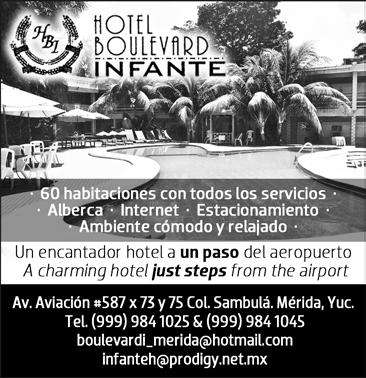
Leyenda / Key: Número de habitaciones / Total rooms Pago con tarjeta / Cards accepted Familiar / Family Servicio de alimentos y bebidas / Food and beverage service Estacionamiento / Parking Anunciante / Advertises in Yucatán Today


29 Where To Go and How!
Hotel Chichén Itzá Calle 15 #45, Pisté Chichén Itzá 42 998 240 8247 www.mayaland.com Boulevard Infante Av. Aviación x 73 y 75 Mérida 84 999 984 1025 www.hotelboulevardinfante.com Fiesta Americana Paseo de Montejo, Centro Mérida 350 999 942 1111 www.fiestamericana.com Hacienda Xcanatun by Angsana Carr. Mérida - Progreso Mérida 54 999 930 2140 E Hacienda Xcanatun Las Cruces Calle 60 x 27, Alcalá Martín Mérida 16 999 925 5521 www.hotellascrucesmerida.com Luz en Yucatán Calle 55 x 58 y 60, Centro Mérida 14 999 924 0035 www.luzenyucatan.com Villa Mercedes C.C. by Hilton Av. Colón x calle 60, Centro Mérida 127 999 942 9000 Q villamercedesmerida Hotel Cielo y Selva Calle 51 x 102 y 104, Chobenché Tekax 20 997 979 0010 Q cieloyselvatekax The Lodge at Uxmal Frente al sitio / across from site Uxmal 40 997 123 2707 www.mayaland.com El Sultán de la Sierra Calle 50 #211 x 55 y 57, Centro Tekax 26 997 974 2169 E Hotel “El Sultán de la Sierra” Hotel Puuc Calle 55 x 44, Centro Oxkutzcab 51 997 975 0103 E HOTEL PUUC Hacienda Chichén Resort Carr. Chichén Itzá - Valladolid Chichén Itzá 29 999 442 7741 www.haciendachichen.com Hacienda Santa Rosa Carr. Mérida-Campeche Maxcanú 11 999 923 1923 www.yuc.today/HdaStaRosa Hotel del Peregrino Calle 51 x 54 y 56, Centro Mérida 12 999 924 3007 www.hoteldelperegrino.com Hotel Hacienda Mérida Calle 62 x 51 y 53, Centro Mérida 13 999 924 4363 www.hotelhaciendamerida.com Rosas & Xocolate Hotel & Spa P. de Montejo x 41, Centro Mérida 17 999 924 2992 www.rosasandxocolate.com The Diplomat Boutique Hotel Calle 78 x 59 y 59-A, Centro Mérida 5 999 117 2972 www.thediplomatmerida.com Hacienda Temozón Km 182 Carretera Mérida-Uxmal Temozón Sur 28 999 924 1333 www.yuc.today/HdaTemozon Hacienda San José Km 30 Carr. Tixkokob-Tekantó Tixkokob 15 999 923 8089 www.yuc.today/HdaSanJose Hacienda Uxmal A 200 m del sitio / from site Uxmal 62 997 123 2707 www.mayaland.com Hotel Le Muuch Calle 42 x 35 y 33, Centro Valladolid 21 985 109 8493 QE lemuuchhotel Hotel Olbil Calle 41 x 28 y 30, Santa Ana Valladolid 12 985 244 2758 QE olbilhotelvalladolid Cedros Hotel Boutique Calle 26 x 25 #199, Centro Espita 8 986 114 3220 www.casonaloscedros.com SaakLuum Ruta Puuc Calle 26 (salida a Ticul) Sacalum 6 998 291 8950 E QuintaSaakLuum Pensión San Diego Calle 52 #202 x 53 y 55, Centro Tekax 4 997 101 4546 Q pensionsandiegotekax Hamaka Hosting Chelem Solicita informes / ask for details Chelem 1 999 965 8953 www.hamaka.mx Hamaka Hosting Mérida Centro y norte Mérida 24 999 965 8953 www.hamaka.mx Hamaka Hosting Progreso Solicita informes / ask for details Progreso 1 999 965 8953 www.hamaka.mx Hacienda Petac Carr. Mérida - Dzununcán Petac 999 161 7265 www.haciendapetac.com Hamaka Hosting Sisal Solicita informes / ask for details Sisal 4 999 965 8953 www.hamaka.mx Casa Bugambilia Calle 51 x 50 y 52,Centro Tekax 5 997 101 3345 casabugambiliastkx@gmail.com Casa Sultana Calle 50 x 45 y 47,Centro Tekax 1 997 113 0695 E Casa Sultana
HOTELES BOUTIQUE B&B
HOTELES
Vive una experiencia de cocina tradicional maya A Traditional Maya Cooking Experience

No importa si has vivido aquí toda tu vida, si nos visitas por primera vez, o si eres un viajero experimentado que busca probar algo distinto en Yucatán: disfrutar de sus cocinas tradicionales es algo que definitivamente querrás vivir.
Lo llamativo de las cocinas tradicionales, que también se conocen como aldeas mayas, es tener la oportunidad de sumergirse en la cultura maya durante un par de horas.
Anunciadas y promocionadas como la experiencia más novedosa en Yucatán, el objetivo es generar una mejor comprensión de lo que implica la preparación de los alimentos tradicionales que comemos y los ingredientes utilizados para prepararlos, así como ver un poco de la vida de los habitantes de estas comunidades.
¿Cómo elegir una experiencia así cuando ahora tenemos tantas opciones, sabiendo que algunas serán inevitablemente mejores que otras? Con “mejores” me refiero a aquéllas que realmente brinden una apreciación y comprensión mucho más profunda de la cultura y las personas, sin sentirte
como un mero espectador o, peor aún, un intruso en la vida de las personas con las que has compartido tu tiempo.
Cada aldea, es decir, cada grupo de emprendedores locales, comparte su esencia en lo que hacen; sin embargo, hay tres aspectos básicos que se ofrecen o al me -
Al elegir dónde ir, las fotos serán una buena referencia. Las mejores experiencias suelen incluir:
Flores frescas, materiales naturales presentados en jícaras, utensilios de madera y anfitriones cómodos en su ropa tradicional.
Un ambiente de grupo pequeño; evita los lugares que parecen estar preparados para recibir a grupos de turistas en grandes cantidades.
Imágenes de invitados como tú participando activamente en la preparación de los alimentos y acompañamientos.
Ollas y sartenes oscurecidos por el fuego, pilas de leña, árboles y plantas, y el tradicional fuego para cocinar.
nos se mencionan: hacer tortillas de maíz a mano en el comal tradicional, sobre un fogón de tres piedras; cocinar en un Pib u horno de tierra; y, antes de comenzar, conocer bien de cerca los ingredientes que usarás (y cómo se ven antes de ser preparados) para darte una mejor idea de lo que aportan a la receta.
Tres cocinas tradicionales certeras en Yucatán

Por supuesto, no he visitado todas las cocinas tradicionales que existen en nuestro extado, pero tengo algunas favoritas que definitivamente vale la pena visitar. Todas están disponibles a través de guías locales y compañías turísticas selectas, o puedes reservar con los dueños a través de sus redes sociales o contactándolos directamente. Conócelas en la página siguiente.
hether you are a first-time visitor or a seasoned traveler looking to go deeper than on a previous trip to the Yucatán Peninsula, a traditional cooking/foodie or village experience is something you’ll definitely want to partake in.
30
COMER EN YUCATÁN • EATING IN YUCATÁN W
Aldea X’batún
Chef Wilson Alonzo en el mercado de Halachó Chef Wilson Alonzo at the Halachó market
FOTO: OLIVIA CAMARENA CERVERA
FOTO: OLIVIA CAMARENA CERVERA CÓMO ELEGIR TU EXPERIENCIA
Comer en Yucatán
Known as Cocinas Tradicionales (traditional kitchens) or Aldeas Mayas (Maya villages), the main attraction is to immerse oneself in Maya culture for a few hours.

Advertised and promoted as the new and latest thing to do, the objective is to come away with a better understanding of what goes into the preparation of the traditional foods we eat and the ingredients used to prepare them, as well as to see a little of life in and around the villages or towns where these experiences can be had.
So, how do you choose such an experience when there are now so many, as some are inevitably going to be better than others? By “better” I mean providing a far greater appreciation and understanding of the culture and people and not feeling like a spectator or, worse, an intruder, into the life of the people you’re spending time with.
Each group of local entrepreneurs puts their own stamp on what they do, but there are some basics that are offered or at least referenced: making fresh corn tortillas by hand on the traditional comal and cooking fire; cooking in a traditional Pib (underground oven); and getting a close look at the ingredients you’ll be using before the process starts, to give you a better idea of what each adds to the recipe.
Three Tried and True Cocinas Tradicionales (Traditional Kitchen Workshops) in Yucatán


Of course, I have not visited all the “cocinas tradicionales” in Yucatán, but I have a few favorites that are definitely worth visiting. All are available through local guides and select tour companies, or you can make reservations directly with the folks through social media, phone, or Whatsapp.
HOW TO CHOOSE AN EXPERIENCE
When choosing where to go, guest photos can be a helpful reference. The best experiences usually include:
Fresh flowers and ingredients (usually presented in dried gourds), wooden utensils, and hosts comfortably wearing well-loved traditional clothing.
A small group atmosphere; avoid places that are set up for visits from busloads of tourists.
Images of guests like yourself actually taking part in the preparation of the foods and accompaniments.
The Pib, fire-blackened pots and pans, stacks of firewood, trees and plants, and the traditional cooking fire.
ALDEA X’BATUN - VALLADOLID
Esta aldea se encuentra a pocos minutos en auto del centro de Valladolid, justo a la salida del periférico que rodea esta ciudad (que alguna vez fue tranquila y ahora se expande rápidamente), ubicada a medio camino entre Mérida y Cancún.
La recepción al llegar es cálida y auténtica, y te ofrecerán una refrescante bebida fría. Árboles, vegetación y el sonido de los pájaros te rodean. Aquí se puede sentir mucha energía femenina positiva; la paciencia de tus anfitrionas es infinita, y realmente se preocupan por tu experiencia.
La cocina abierta cuenta con una mesa comunitaria lo suficientemente grande como para que una familia o grupo de amigos puedan ayudar a picar, mezclar y preparar la comida del día. Hay hamacas para descansar entre cada actividad, bajo la sombra de árboles nativos que no sólo se han preservado, sino que se han incorporado al diseño de toda la propiedad. Puedes visitar su huerta donde se cultivan hierbas y plantas comestibles, e incluso pasar la noche en una tradicional casa maya para disfrutar una experiencia de inmersión completa. Si tuviera que elegir una sola palabra para resumir esta experiencia, definitivamente sería “armonía”.
La experiencia puede durar de tres a cinco horas, según el menú y cuánto te diviertas. Tus anfitriones serán el restaurantero (y visionario) local José Cen y su familia.
Aldea X'Batun is a few minutes' drive from the center of Valladolid, just off the Periférico or ring road that encircles this once-sleepy and
now rapidly expanding city, located halfway between Mérida and Cancún.
The reception upon arrival is smilingly warm and authentic, and you’ll be offered a cool refreshing drink. Trees, vegetation, and the sound of birds are all around you. One can feel a lot of positive female energy here; your hostesses are unfailingly patient and really care about your experience.
The open kitchen features a communal table large enough so that a family or group of friends can help with the chopping, mixing, and preparation of the day’s meal. There are hammocks for resting between activities, under the shade of native trees that have been not only saved, but incorporated into the design of the entire property. You can visit their Huerta (garden) where herbs and edible plants are grown and, if you like, you can even stay the night in a traditional Casa Maya to enjoy the full immersion experience. If I had to choose one word to sum up this experience, it would be “harmony”.
The experience can be three to five hours long, depending on what the menu is and how much fun you are having.
Your hosts at Aldea X’Batun include local restaurateur and man with a vision José Cen and his lovely family.
Aldea X’Batun Valladolid, Yucatán
m 985 852 6555
31
Q
aldeaxbatun
Aldea X’Batun
Pib, Aldea X’Batun
Fogón de tres piedras, Aldea X’Batun Three-stone fire, Aldea X’Batun
FOTO: OLIVIA CAMARENA CERVERA FOTO: OLIVIA CAMARENA CERVERA
Eating in
FOTO: OLIVIA CAMARENA CERVERA
Yucatán
LA CHOZITA XA’ ANIL NAH SANTA ELENA
A sólo 90 minutos de Mérida se encuentra el pueblo de Santa Elena, anteriormente conocido como Nohcacab: un lugar perfecto para almorzar después de visitar Uxmal y Kabah. Allí, tus anfitrionas en La Chozita te ofrecerán una breve demostración/explicación de la comida que se servirá y una refrescante bebida natural. La comida ha sido preparada de antemano y se disfruta bajo la sombra de árboles cítricos. Puedes acompañar a las mujeres mientras hacen tortillas de maíz frescas sobre el fuego tradicional de cocina.
Otras actividades incluyen cocinar en un Pib y visitar una granja local de abejas meliponas (sin aguijón) donde los meliponicultores mayas cuidan y cultivan esta frágil especie y comercializan su valiosa miel.
Xa’ Anil Nah es interesante, ya que está completamente dirigido por un grupo de dedicadas mujeres locales, encabezado por Gladys Collí, una promotora tranquila pero insistente de su pueblo y su gente, que navega hábilmente entre la mentalidad desafiante de un pequeño pueblo
yucateco y las demandas modernas del turismo sustentable.
Merely 90 minutes from Mérida is the village of Santa Elena, formerly known as Nohcacab, a perfect lunch spot after Uxmal and Kabah. There, your hosts at La Chozita will offer a short demo/explanation of the food to be served and a refreshing natural beverage. The meal has been prepared beforehand and is enjoyed under the shade of citrus trees. You may accompany the ladies patting out fresh corn tortillas over the traditional cooking fire.
Other activities include Pib cooking and visiting a local native Melipona (stingless) bee farm where Maya beekeepers nurture and cultivate the fragile species and commercialize its highly-prized honey.
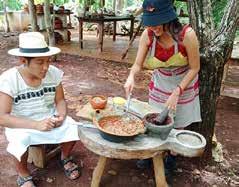


Xa’ Anil Nah is interesting as it is entirely run by a group of dedicated local women, spearheaded by Gladys Collí, a quiet but insistent promoter of her town and people, who skillfully navigates the challenging mindset of a small Yucatecan town and modern demands of sustainable tourism.
La Chozita Xa’ Anil Nah
Santa Elena, Yucatán
m 997 133 5768
YA’AXCHE (RESTAURANTE Y TALLER / RESTAURANT AND WORKSHOP) HALACHÓ
Ya’axche es una excelente opción manejada por el renombrado chef Wilson Alonzo, quien ofrece varias opciones que van desde cenas en el restaurante (solo los fines
de semana) hasta clases y talleres completos. Estos últimos incluyen una visita al mercado donde conocerás a los lugareños y comprarás ingredientes frescos para el día, así como la preparación completa de un Pib y toda la comida que disfrutarás durante tu visita. Yo te recomiendo dedicarle tiempo al taller (que puede durar hasta seis horas aproximadamente): saldrás totalmente satisfecho, bien alimentado y lleno de la cálida sensación de esta acogedora experiencia.
Ya’axche is an excellent option run by local celebrity chef Wilson Alonzo, who offers several options from in-restaurant dining (weekends only) and classes to full-on workshops. The latter includes a market visit where you will meet the locals and buy fresh ingredients for the day, the complete preparation of a Pib, and all the food to be had during the visit. I recommend dedicating time for the workshop (which can run up to six hours or so)—you will come away totally satisfied, well-fed, and imbued with the warm feeling of this welcoming experience.
Along with family members and neighbors, local culinary students from Universidad Tecnológica del Poniente (in Maxcanú) provide support for the activities. An amazing day.
Cualquiera que sea el destino que elijas, tómate tu tiempo, mantén la mente y el corazón abiertos y tendrás un recuerdo excelente para atesorar toda la vida.
Whichever destination you choose, slow down, keep an open mind and heart and you will have an excellent memory to cherish for a lifetime.
Ya’axche Restaurante y Centro Etnogastronómico
Halachó, Yucatán

m 997 151 0862
Q y.aaxche
POR / BY RALF HOLLMANN
32
Tortillas a mano, La Chozita Xa’ Anil Nah Making tortillas by hand at La Chozita Xa' Anil Nah
Pollo pibil, La Chozita Xa’ Anil Nah
Ya’axche
FOTO: LA CHOZITA XA’ ANIL NAH
FOTO: ARIANNE OSALDE
FOTO: LA CHOZITA XA’ ANIL NAH
FOTO: @ATNAVARRETE
Ya’axche
Comer en Yucatán
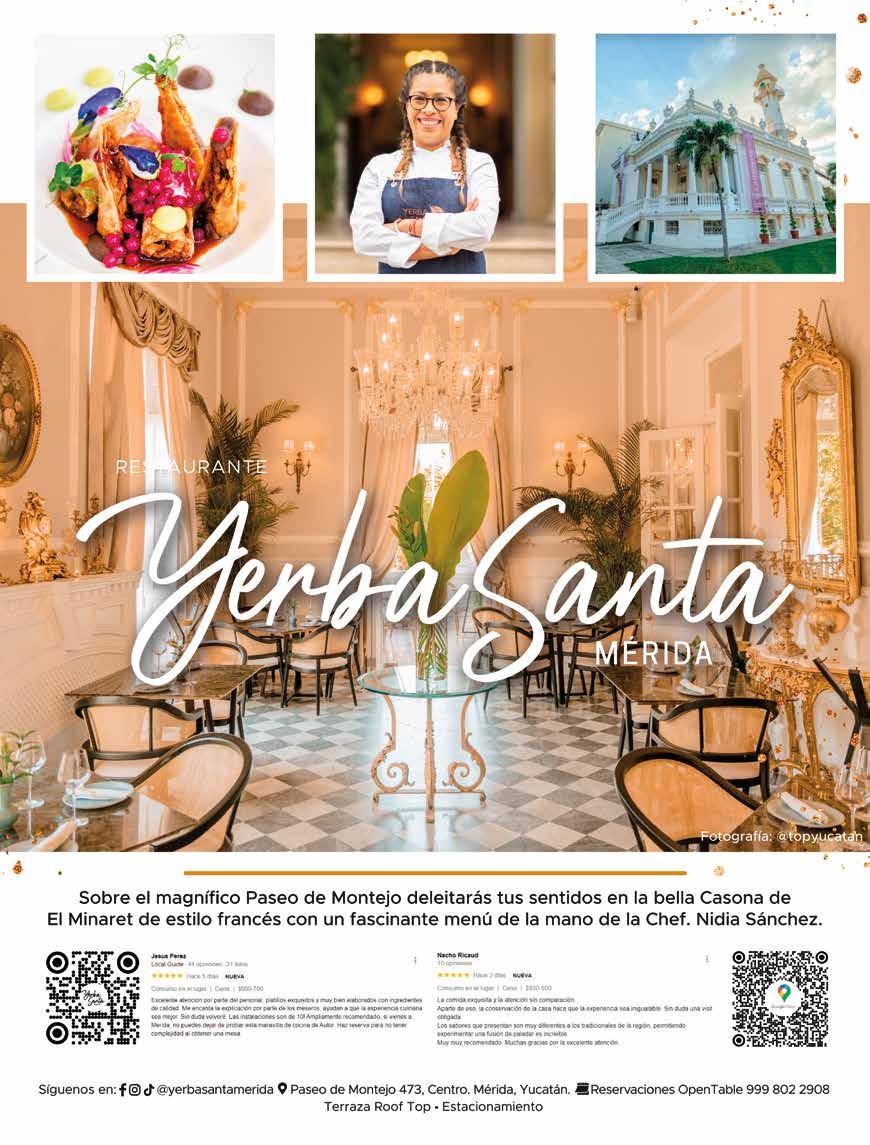
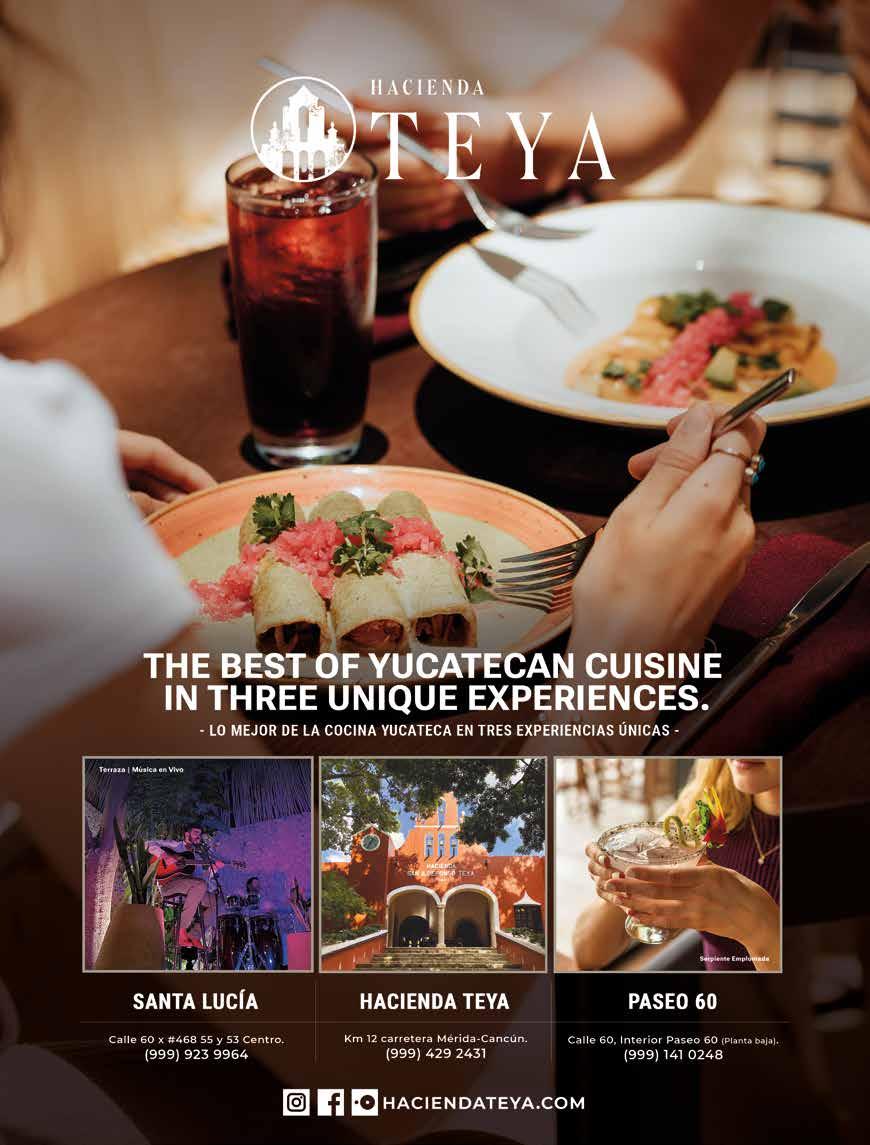
ucatán es hogar de una rica tradición gastronómica, que incluye “botanear” antes de la comida (acompañar la botana con cerveza es opcional). Aquí te presentamos una guía para orientarte sobre las botanas yucatecas que encontrarás.
Codzitos. Crujientes taquitos de tortilla de maíz, rellenos de… nada. Sólo son la tortilla, salsa de tomate, y queso sopero (tipo Cotija) espolvoreado.
Ensalada de papa en escabeche. Esta botanita deliciosamente ácida puede incluir salchichas rebanadas, pero normalmente sus ingredientes más abundantes son papa, cebolla y cilantro; ten cuidado al probarlo, pues algunos lugares le ponen chile habanero. Es buena idea preguntar cuando llegue a la mesa. Un tip: nunca preguntes si algo pica; mejor pregunta si tiene algo de chile, pues el picor puede ser relativo.
Kibis. Los kibis son una tropicalización de los kibbeh libaneses; los encontrarás en una variedad de lugares y presentaciones, como te explicamos en la pág. 4. En los botaneros y cantinas, normalmente se sirven como tortitas pequeñas, de unos cinco centímetros de diámetro, acompañados de cebolla morada encurtida.
Chayitas. Las presentaciones varían, pero las chayitas normalmente son tortitas fritas, hechas de masa revuelta con chaya picada (la chaya es una planta local, en cierto modo similar a la espinaca). A veces se sirven con salsa de tomate, y a veces con Xnipek (pico de gallo).
Polcanes. Aunque son similares a lo que quizá conozcas como “gorditas”, los polcanes se distinguen por su particular forma, similar a la cabeza de una serpiente (Pool K’aan, en maya). Los rellenos también pueden variar, pero el tradicional es el Tooksel, un platillo hecho con frijoles blancos (iibes) y pepita de calabaza molida.
Sikil P’aak. Un dip tradicional hecho de pepita de calabaza tostada y molida, cilantro y tomate asado. Es otra botana vegetariana súper nutritiva, que normalmente se sirve con tostadas.
Xe’ek’. Esta fresca ensalada está hecha con jícama y cítricos, normalmente naranjas y mandarinas. Algunas personas le ponen chile molido, ya sea chile Maax o habanero, y algunas personas le agregan cilantro. Como lo pruebes, es una botana muy tradicional, especialmente en otoño, que es la temporada tanto de jícama como de cítricos. “Xe’ek’” también es la palabra que usamos en Yucatán para describir algo desordenado: “la casa estaba hecha un Xe’ek’”.
Panuchos y salbutes. Tortillas fritas hechas a mano con pollo o pavo desmenuzado, lechuga, tomate, pepino, cebolla y aguacate. El Panucho tiene relleno de frijol en la tortilla, y, a diferencia del Salbut, es crujiente. También se pueden pedir de relleno negro o carne asada.
Un extra: Acompaña tu botana con un coctel a base de cerveza: pídelo y recibirás la cerveza de tu elección junto con el mix (una o dos onzas) en un tarro con hielo. La chelada es sólo jugo de limón, y la michelada, limón y una mezcla especiada de salsas.
Para conocer más platillos yucatecos visita: www.yuc.today/cocina-yucateca
Yucatán is home to a rich cuisine that is surrounded with tradition, and that includes snacking (Botana) before lunch; pairing botanas with beer is optional. Here’s a guide to help you navigate the Yucatecan botanas.
Codzitos. Fried corn tortilla tacos that are usually filled with…nothing. They’re just the crunchy taco shell, covered with tomato sauce and sprinkled with crumbled Sopero cheese (similar to Cotija).
Pickled potato salad. This tangy dish may sometimes be made with sliced sausages, but
you’ll find that the most abundant ingredients are potatoes, onions, and sometimes cilantro; be wary when trying it, since some places throw in slices of Habanero peppers. It’s a good idea to ask in advance.
Kibis. Kibis are a tropicalization of Lebanese Kibbeh; you’ll find them in a variety of places and presentations. At Botaneros and Cantinas, they’re usually served as small patties, a couple of inches in diameter, with pickled red onion.
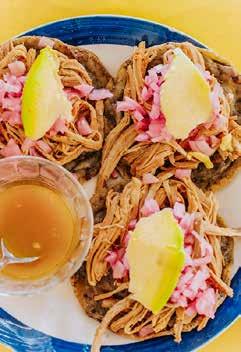
Chayitas. Presentations vary, but Chayitas are usually fried masa with chopped Chaya (a local, tasty leafy green), sometimes served with tomato sauce, but sometimes with Xnipek (Pico de Gallo).
Polcanes. Although similar to what you might know as “Gorditas”, Polcanes are distinguished by their particular shape, similar to a snake’s head (Pool K’aan, in Maya). Fillings may vary, but the traditional one is Tooksel, which is a vegan-friendly dish made with white beans (iibes) and ground Pepita (pumpkin seed).
Sikil P’aak. A traditional dip made with toasted pumpkin seed, cilantro, and roasted tomato. It’s a great (vegan) snack that’s also highly nutritious and is usually served with tortilla chips.
Xe’ek’. This is a fresh salad made with jicama (Mexican turnip) and citrus fruit, usually oranges and mandarin oranges. Some people make it with ground Maax or Habanero pepper, and some people add in cilantro. Any way you try it, it’s a very traditional fall snack (as that’s when both jicama and citrus are in season), and also the word we use to describe a messy situation. “Your room is a Xe’ek’!”
Salbutes and Panuchos. Fried, hand-made tortilla topped with shredded chicken or turkey, lettuce, tomato, cucumber, onion, and avocado. The difference between the two? A Salbut is soft and the Panucho is crunchy and filled with beans. They’re now also available with toppings such as Cochinita Pibil or Relleno Negro—possibilities are endless.
Bonus round: Pair your botana with a beer cocktail. You’ll be brought whichever beer you order along with the mix (an ounce or two) in a beer mug with ice, for you to pour and enjoy. Chelada is lime only; Michelada, lime plus a spicy house mix of sauces; and Ojo Rojo, the lime, sauces, and a double pour of Clamato juice.
33
Y
Visit www.yuc.today/yucatecan-cuisine to read the full version. COCINA YUCATECA: BOTANA • YUCATECAN CUISINE: SNACKS
FOTO: NORA GARRETT
Panuchos
in Yucatán
Eating
Machacados de fruta / A refreshing street snack
Si buscas un escape natural para el calor, no te pierdas los machacados: hielo raspado sobre fruta natural machacada y servido con leche condensada y un toque de vainilla. Distintos a los granizados (hechos con hielo y jarabe), los machacados estan presentes en ferias de todo el estado; los sabores más comunes son plátano, elote y mango.
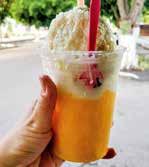
If you’ve tried Marquesitas and are looking for a different street treat, try a Machacado: shaved ice over mashed fruit (usually banana, corn, or mango), served with condensed milk and a dash of vanilla. Not to be confused with Granizados (which are made with flavored syrup), Machacado carts and stands are easily found at fairs, sometimes with a fresh display of available fruit.
Pago con tarjeta / Credit cards Terraza / Terrace Aire acondicionado / Air conditioned Mascotas bienvenidas / Pet-friendly Servicio a domicilio / Delivery Estacionamiento / Parking Bebidas alcohólicas / Alcoholic beverages Opciones vegetarianas / Veggie options Zona de niños / Play
Texas Roadhouse Frente a The Harbor / Periférico x salida a Caucel, Mérida
Hogsons Smokehouse Calle 13 x 14 y 16, Itzimná, Mérida
La Mestiza de Maní Calle 28 x 23 y 21, Centro, Maní
Lapa Lapa Altabrisa / Caucel / Dorada / Kukulcán
Mítica García Lavín / Macroplaza / Fco. de Montejo / Chicxulub
Café Kuun Fiesta Americana: Paseo de Montejo x Av. Colón, Mérida
Café La Habana Calle 62 x 59, Centro, Mérida
Café Montejo Fiesta Americana: Paseo de Montejo x Av. Colón, Mérida
Café Orgánico Calle 33-D #498 x Av. Reforma, Mérida
Ki’Xocolatl Calle 60 #471 Int. 5, Parque Santa Lucía, Centro, Mérida
Merci Plaza San Angelo: Calle 61 x 14, Montes de Amé, Mérida
Al Alba Av Yucatán #351, Los Pinos, Mérida
Al Modar Calle 20 #106, Cholul, Mérida
Azul Cielo Calle 34 x 23 y 25, Centro, Tzucacab
Cafetería Manina Calle 65 #191 x 2-B y 4, Cortés Sarmiento, Mérida
Casa Makech Calle 51 #403 x 50 y 52, Tizimín
Coffrapía Calle 2 #437 x 21 y 23, Fracc. José Ma. Iturralde, Mérida
The Coffee Moon Calle 55 x 54 y 56, Centro, Tekax
Tinoc Café Calle 58 #444 x 51 y 53, Centro, Mérida
Curios Bar Hotel Villa Mercedes: Av. Colón #500 x calle 60, Centro, Mérida
La Fundación Mezcalería Calle 59 #509 x 60 y 62, Centro, Mérida
La Negrita Calle 62 x 49, Centro, Mérida
Stelaris Bar Fiesta Americana: Paseo de Montejo x Av. Colón, Mérida
El Cardenal Cantina Calle 63 x 70, Centro, Mérida
Sisao Calle 37 #211, Benito Juárez Norte, Mérida
Crabster Paseo 60 Paseo 60: Calle 60 x 35 y Av. Colón, Mérida
Crabster Progreso Malecón Tradicional de Progreso x 74 y 76, Progreso
La Pigua Av. Cupules x 62, Centro, Mérida
Mobula Malecón Tradicional de Progreso x 74, Progreso
Q Texas Roadhouse México
E Hogsons Smokehouse
E La Mestiza de Maní
E Lapa Lapa
Q miticaburgers
E Kuun by Nespresso FAMD
m 999 928 6502
Q cafemontejofamd
E Cafe Organico de Merida
E Ki Xocolatl
Q mercimid
Q alalbamid
E Al Modar Patio + Mirador
E Azul Cielo Store & Coffee
E Cafetería Manina
E CasaMakech
Q coffrapia
E The Coffee Moon
Q tinoc.cafestaurante
Q villamercedesmerida
E La Fundación Mezcalería
QE La Negrita Cantina
Q f.a.merida
Q cardenalcantinero
Q sisaomx
Q crabstermx
Q crabstermx
Q lapiguamerida
Q mobulamx
El Pescado Patrullero Calle 22 x 17 y 19, Chicxulub Puerto E El Pescado Patrullero
El Popular Vaselina Calle 9 x 10 y 12, San Felipe
Flippers Calle 51 No. 297 x 82 y 84, Chobenche, Tekax
Kraken Plaza Boulevard: Calle 59-A x Av. San Pedro, Cd. Caucel, Mérida
BC66 Calle 66 x 43 #377, Centro, Mérida
E Restaurant Flippers
QE krakenmid
E Bistro Cultural
Lagos Taverna Griega The Harbor: Calle 60 x Periférico, Mérida Q lagostavernagriega
Pecatto Calle 60 #465 x 53, Centro, Mérida m 999 750 3575
Antica Roma Calle 23-A #350 x 34 y 36, La Florida, Mérida
Dal Baffo Av. Alemán #73, Col. Felipe Carrillo Puerto, Mérida
E Antica Roma merida
QE dalbaffomerida
Trattoria La Pasta Paseo de Montejo #481 www.trattorialapasta.com
Zinc Comfort Food Paseo de Montejo #496 x 45 y 43, Centro, Mérida
QE zinccomfortfoodmerida
34 Comer en Yucatán EUROPEO • EUROPEO
Q
restaurante_vaselina_sf
DÓNDE COMER • WHERE TO EAT
CAFÉ/BRUNCH/POSTRES • CAFÉ/BRUNCH/POSTRES ESTE MES • THIS MONTH
area Anunciante / Advertiser
CANTINAS Y SNACK BARS
DEL MAR • DEL MAR FOTO:
AMERICANO AMERICAN
@ATNAVARRETE
Casa Chica Paseo de Montejo x 45 y 47, Centro, Mérida
Maya de Asia The Harbor: Calle 60 x Periférico, Mérida
Merci Paseo 60: Calle 60 x 35 y Av. Colón
Paseo 60 Calle 60 x 35 y Av. Colón, Mérida

Picheta Calle 61 x 60 y 62, Centro, Mérida
Rosas & Xocolate Paseo de Montejo #480 x 41, Centro, Mérida
Sanbravo Prol. Paseo de Montejo x 45, Benito Juárez Nte., Mérida
Trópico 56 Remate de Montejo: Calle 56-A x 47 y 49, Centro, Mérida
Yerba Santa Paseo de Montejo #473 x 35 y 37, Centro, Mérida
Bachour City 32: Av. García Lavín x Periférico, Mérida
Cuna Hotel Wayam: Av. Colón #508, García Ginerés, Mérida
E Casa Chica
E Maya de Asia
E Merci
E Paseo 60
QE pichetamx
E Rosas & Xocolate
E Sanbravo
QE tropico56mid
Q yerbasantamerida
E Bachour Mérida
E Cuna Merida
Garage - Cocina Legado Calle 100-1 #143-1 x 53 y 53-C, Las Américas Q garage.mid
Idilio Calle 41-A #142-A x 45 y 49. Barrio de Sisal, Valladolid E Idilio Folklore Cervecero
Trotter’s Calle 31 #134 x 34, Buenavista, Mérida
trottersmerida
Asai Hotel Villa Mercedes: Av. Colón #500 x calle 60, Centro, Mérida Q asai.merida
Hanaichi Sky City, piso 8: Av.Andrés García Lavín x 57 y 59, Mérida Q hanaichi.merida
SushiClub Plaza Mangus: Av. García Lavin x Periférico de Mérida
Tama Shokudō Calle 29-A #184 x 22 y 24, Miguel Alemán, Mérida
Yakuza Calle 47 #478 x 54 y 56, Centro, Mérida
Café Alameda Calle 58 #474 x 55 y 57, Centro, Mérida

Siqueff Centro Calle 60 #350 x 35 y 37, Centro, Mérida
Siqueff Norte Plaza Luxury: Av. García Lavín x 27 y 29, Mérida
Ya Beirout Circuito Colonias x 29-A y 31, Miguel Alemán, Mérida
Casa de Piedra Hacienda Xcanatún: Calle 20 S/N x 19 y 19-A, Mérida
Catrín Cocina Cantina Calle 47 #463-B x 52 y 54, Centro, Mérida
K’uxub Cocina de Arte Calle 42 #188-A x 33 y 35, Candelaria, Valladolid

Los Faisanes Zona Hotelera de Chichén Itzá
María Raíz y Tierra Hotel Villa Mercedes: Av. Colón #500 x calle 60, Mérida
Matilda Calle 63 #516 x 62 y 64, Centro, Mérida
Papillon Taqueria Calzada de los Frailes #205 x 48 y 50, Valladolid
Ramiro Cocina Calle 41 #386 x 58 y 60, Centro, Mérida
Rúa Café Calle 35 x 40 y 42, Candelaria, Valladolid
Chuc Calle 60 x 53, Centro, Mérida
Hda. Sotuta de Peón Poblado de Sotuta de Peón
Hacienda Teya Carretera a Cancún Km 12, Mérida
Hda. Teya Santa Lucía Calle 60 #468 x 53 y 55, Centro, Mérida
La Casta Divina Calle 59 #513 x 62, Calle 59, Centro, Mérida
Los Arcos Calle 15, Pisté
sushiclubmerida
tamashokudo
yakuzamx
E Cafe Alameda
E Siqueff Restaurant
E Siqueff Norte
E YaBeirout
E Hacienda Xcanatun
E Catrín
Q kuxub_restaurante
www.haciendachichen.com
Q mariaraizytierra
E Matilda Salón Mexicano
E Papillon Taqueria
Q ramirococina_
Q larua.café
E Café Chuc
E Hacienda Sotuta de Peón
E Hacienda Teya
Q teyasantalucia
E La Casta Divina
www.mayaland.com
Santa Bárbara Calle 19 S/N, Homún Q cenotesantabarbara
Teya Viva Paseo 60: Calle 60 x 35 y Av. Colón, Mérida
Casona de los Cedros Calle 26 #199 x 25, Centro, Espita
Cocina Mirna Calle 55 #243 x 60 y 62, San Francisco, Tekax
Kinich Calle 27 #299 x 28 y 30, Izamal
La Reina Itzalana Mercado de Santiago: Calle 57 x 70 y 72, Centro, Mérida
Lonchería Gorocica Calle 51 x 72 y 74, Col. Chobenché, Tekax
Muldzinick Calle 54 #219 x 49 y 47, Centro, Tekax
Pueblo Pibil Calle 21 #180 x 26, Tixkokob
Restaurante Ahumados Calle 10, frente a instalaciones Expo Feria, Temozón
Q teyaviva
www.casonaloscedros.com
m 997 974 0564
QE kinichizamal
E La Reina Itzalana Oficial
E Loncheria Gorocica D’Martin
E Restaurante Muldzinick
www.pueblopibil.mx
E Restaurante Ahumados
Ya’axche Calle 18 x 33 y 35, ext. Santa Cruz, La Soledad, Halachó Q y.aaxche
35 Eating in Yucatán
Q
QE
Q
Q
DÓNDE COMER • WHERE TO EAT
•
•
•
•
JAPONÉS
FUSIÓN
FUSIÓN LIBANÉS
LEBANESE MEXICANA
MEXICANA YUCATECA
YUCATECAN
• JAPANESE
La Ruta Puuc, más que sólo Uxmal The Puuc Route, Beyond Uxmal
Oficialmente, la Ruta Puuc se refiere a un trayecto de 40 kilómetros que comienza en Uxmal y abarca cuatro sitios cercanos, todos pertenecientes al estilo arquitectónico Puuc; el nombre, sin embargo, hace referencia a Pu’uk, nombre maya de la Sierrita de Ticul , y se refiere a toda la región que la rodea. El estilo Puuc se caracteriza por ser muy ornamentado y, al mismo tiempo, muy geométrico y muy horizontal, con un detalle en sus labrados en piedra que te dejará boquiabierto por su exquisitez, sobre todo cuando te recuerdes a ti mismo que todo este detalle se elaboró sin ayuda de utensilios metálicos: todo fue creado usando piedra contra piedra.
De forma independiente, cada uno de los sitios arqueológicos de la región Puuc ofrece algo que vale la pena ver por uno mismo. En su conjunto, te permitirán darte una idea más clara de la grandeza técnica, arquitectónica y cultural de la civilización maya que se desarrolló en esta parte del estado. Juegos de pelota, arcos monumentales (sí, más de uno) y palacios elevados son sólo algunas de las sorpresas que estos sitios guardan para quien se aventure a recorrerlos.

Aunque la ruta Puuc oficial sólo considera los cinco sitios a continuación, los sitios de Oxkintok y Chacmultún, a ambos extremos de la ruta, pertenecen también al Puuc y vale la pena visitarlos.
Entrando a Labná, entre árboles, te encontrarás con un edificio donde fácilmente podrás reconocer las características del estilo Puuc: muy geométrico, muy horizontal y muy ornamentado. Ahí mismo podrás admirar muy de cerca los junquillos, que son cilindros de piedra que evocan el bajareque (los palos que conforman las viviendas tradicionales mayas), además de relieves y mosaicos, esculturas y mascarones de Chaac. A partir de ahí, un pequeño sacbé (calzada) elevado te llevará a la que es, por mucho, la estructura más famosa de este sitio: el Arco de Labná. Monumental y altamente ornamentado, es un lugar perfecto
36
DESCUBRIENDO LUGARES • YOU’RE GOING PLACES
Zona de Cenotes Zona de Cenotes Muna Sacalum Cenote Kankirixché Hacienda Sotuta de Peón Tekax Adventures Hacienda Teya Tecoh Telchaquillo Tekit Mama Z.A. Mayapán Chunkanán Acancéh Hacienda Petac Hacienda Yaxcopoil Umán Z.A. Aké Cenotes Santa Bárbara Tixkokob Hunucmá
Cuzamá Homún Tahmek Hacienda Temozón Hotel Hacienda Uxmal Choco Story Abalá S. Antonio Mulix Ticul Z.A. Uxmal Kabah Sayil Xlapak Labná Santa
Lázaro Cárdenas Akil Oxkutzcab Z.A. Chacmultún Xul Yaxhachén Tekax Maní
Mérida
Elena
Calcehtok Grutas Calcehtok LABNÁ
FOTO: BRENDA ÁVILA
Labná
Destinos
DESCUBRIENDO LUGARES • YOU’RE GOING PLACES
para tomar fotos, pero no dejes de acercarte y examinarlo a detalle: en los recovecos de los relieves podrás apreciar restos (auténticos) de la pintura maya prehispánica con la que estaba decorado.
Distancia a Labná desde Uxmal: 40 km. Tarifa de admisión general: $70 pesos. Un dato curioso sobre Labná: El Mirador, un edificio elevado de un estilo menos ornamentado que el resto del sitio, te llamará la atención por las ranuras de su crestería; éstas permiten que el aire circule libremente, protegiendo la construcción durante tormentas y huracanes.
XLAPAK
Xlapak es el sitio más pequeño de los que se encuentran en la ruta Puuc, pero posiblemente el más sencillo de recorrer. Su grado de conservación es mucho menor, lo que te permitirá darte una idea mucho más clara de lo laboriosos y delicados que son
triángulos blancos y negros; éstos fueron colocados ahí por los investigadores del sitio para monitorear si la construcción se está deformando con el paso del tiempo, para detectarlo oportunamente y así evitar que colapse.
SAYIL
Vengas de Xlapak o de Kabah, Sayil te va a parecer un cambio extremo. Después de las maravillosas estelas que están en exhibición a la entrada del sitio, sentirás que el camino para llegar a la primera estructura es mucho más largo que en otras zonas arqueológicas. Pero la espera habrá valido la pena, porque el primer edificio que verás es el Gran Palacio, que hace honor a su nombre al tratarse de una estructura de tres pisos y unas 90 habitaciones. A lo largo de sus 85 metros de fachada podrás admirar distintos grados de conservación, que son de cierta forma una manera de entender cómo está dispuesto su interior (el acceso a
KABAH
Kabah es la segunda zona arqueológica más importante de la región Puuc después de Uxmal, y, próximamente, la sede del Museo Arqueológico del Puuc que se inaugurará a finales de 2023. Tu recorrido comenzará en la que probablemente sea una de las construcciones más impresionantes que puedes visitar y admirar de cerca: el Codz Pop (Kots’ Poop, o petate enrollado), cuya fachada está completamente revestida de mascarones del dios de la lluvia, Chaac, tallados en piedra. ¡Ojo! El sitio continúa cruzando la carretera, donde verás la Gran Pirámide y un arco que, aunque es mucho menos decorado que el de Labná, es también mucho más alto.
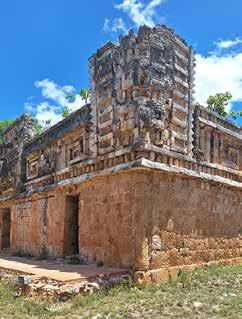

Distancia a Kabah desde Uxmal: 22 km. Tarifa de admisión general: $75 pesos.
Un dato curioso sobre Kabah: La ciudad de Kabah se menciona en el Chilam Balam de Chumayel, uno de los pocos libros mayas prehispánicos que sobreviven.
los procesos de restauración de las construcciones mayas. La zona arqueológica está dispuesta a manera de un circuito de 900 m, a lo largo de los cuales irás visitando las distintas estructuras descubiertas; al ser ésta una de las zonas menos visitadas, el circuito funciona también como un sendero de naturaleza, donde podrás escuchar y ver distintos tipos de animales y plantas en un entorno muy silvestre.
Distancia a Xlapak desde Uxmal: 37 km. Tarifa de admisión general: $70 pesos. Un dato curioso sobre Xlapak: Uno de los edificios del circuito tiene pegados varios pequeños “mosaicos” de plástico con
las habitaciones está cerrado). No dejes de asomarte a su parte de atrás; la construcción, con todos sus detalles en piedra parcialmente ocultos por la selva lo hacen parecer salido de una película de aventuras.
Tarifa de admisión general: $70 pesos.
Distancia a Sayil desde Uxmal: 32 km.
Un dato curioso sobre Sayil: Si tú o tus acompañantes no se sienten cómodos con representaciones anatómicas desproporcionadas, será mejor no tomar la desviación hacia la estela “El Señor de los Falos”. En la región Puuc, la escasez de fuentes de agua dejaba a la población completamente a merced de los dioses de la fertilidad.
UXMAL
Entre los notables conjuntos de la capital del Puuc, como el Cuadrángulo de las Monjas y el Juego de Pelota, sobresale especialmente la Pirámide del Adivino. No puedes perderte: se encuentra justo a la entrada del sitio, tiene la única base ovalada en la zona maya, y es la más alta de la región, con alrededor de 35 m de altura. Ésta es la construcción a la que hace referencia la leyenda del enano de Uxmal; sin embargo, a diferencia de lo que ésta dice, sabemos que no se construyó en una noche, sino que (como muchos edificios mayas) tiene varias etapas de construcción a lo largo de sus varios siglos de existencia.
37
FOTO: BRENDA ÁVILA
FOTO: @ATNAVARRETE
Xlapak
Sayil
Destinations
DESCUBRIENDO LUGARES • YOU’RE GOING PLACES
La Pirámide del Adivino no se puede escalar, pero obtendrás una vista privilegiada de ella, y de toda la zona, desde el Palacio del Gobernador, que es considerado por muchos como el más extraordinario ejemplo de arquitectura precolombina no sólo del área maya sino de toda América.
Desde el Palacio del Gobernador verás también también la Gran Pirámide, justo a un costado, y el Palomar y su elaborada crestería, además del espesor de la selva que rodea el sitio visitable, y esconde la gran extensión que todavía falta por explorar.
Tarifa de admisión general: $531 pesos (extranjeros), $240 pesos (nacionales); $90 pesos (yucatecos).
Un dato curioso sobre Uxmal: La elaborada crestería del Palomar (llamada así por las aves que se refugiaban en sus ranuras) proyecta la sombra de una serpiente que repta a lo largo de la base del edificio durante el solsticio de invierno en diciembre.
No es imposible visitar todos estos sitios en un solo día. Sin embargo, intentarlo puede ser muy cansado (sobre todo considerando las elevadas temperaturas en los sitios arqueológicos). También es importante considerar tu nivel de interés en cada una de las zonas: si únicamente quieres verlas por ti mismo y tomar algunas fotos, no necesitarás demasiado tiempo en cada una. Si realmente te apasiona y quieres conocerlas más a fondo, es recomendable ir con calma y pasar al menos una noche en la región; para visitar también Oxkintok y Chacmultún, en los extremos, lo más cómodo sería planear al menos dos noches a lo largo de la ruta. Esto te dará también oportunidad de incorporar más actividades (y más variadas) durante tu recorrido.
Visita www.yuc.today/230836 para leer nuestro artículo completo sobre la Ruta Puuc, con más información, fotos y opciones de transporte, hospedaje, alimentos y actividades para complementar tu recorrido.
Officially, the Puuc Route is a 40-kilometer trail that starts in Uxmal and comprises four nearby sites, all belonging to the Puuc architectural style. The name, however, refers to the Maya name of the Ticul Hills, Pu’uk, and refers to the entire region around them. The Puuc architectural style is characterized by being very ornate and, at the same time, very geometrical and horizontal. The intricate stone carvings you will see in this area will leave you awestruck for reasons very different from sites like Chichén Itzá or Ek Balam, especially when you remind yourself that this level of detail was created without the use of metal tools: everything was crafted carving stone against stone.
Individually, each of the archaeological sites in the Puuc region offers something worth seeing in person. Collectively, they provide a clearer picture of the technical, architectural, and cultural grandeur of the Maya civilization that flourished south of the state. Grand Ball Courts, monumental arches (yes, more than one), and elevated palaces are just some of the surprises that these sites hold for those who venture to explore them.
Although the official Puuc Route only includes the five stops below, the sites of Oxkintok and Chacmultún, located at both ends of the route, also feature the style and are well worth visiting.
LABNÁ
MITO MAYA: EL ENANO DE UXMAL
Existen tantas variantes de la leyenda del enano de Uxmal como existen yucatecos. Te compartimos un fragmento de una versión de esta leyenda:
En la ciudad de Kabah, una anciana hechicera tenía un huevo del cual brotó un niño; con el tiempo, al niño le creció barba, pero se quedó pequeño de tamaño. Un día, el enano tocó un tunkul (instrumento musical) mágico que la anciana tenía, tan fuerte que el sonido llegó hasta el palacio del rey de Uxmal, quien, preocupado por una profecía, retó al enano a una serie de pruebas.
“Esta noche deberás construir la casa más alta que se pueda ver en este lugar; si cuando amanezca ésta no está terminada, morirás.” Al día si-
guiente, el rey se enfureció al encontrarse con la que hoy conocemos como Pirámide del Adivino.
“El que sobreviva a que se rompan tres cocoyoles en su cabeza será el vencedor”. Antes de realizarse la prueba, la vieja frotó una tortillita de maíz sobre la cabeza del enano. El rey rompió las tres frutas, famosas por su dureza, contra la cabeza del enano, sin hacerle daño. Cuando llegó el turno del rey, éste falleció al instante que el primer cocoyol se rompió contra su cabeza. Así se cumplió la profecía, y el enano se convirtió en el nuevo rey de Uxmal.
Visita www.yuc.today/enano-uxmal para leer la leyenda completa.
Entering Labná, amidst the trees, you will come across a building where you can easily recognize the characteristics of the Puuc style: highly geometric, horizontally oriented, and richly ornamented. Right there, up close, you can admire the Junquillos: stone cylinders reminiscent of Bajareque (wooden sticks used in traditional Maya homes), as well as reliefs, mosaics, sculptures, and Chaac masks. From there, a small elevated Sacbé (walkway) will lead you to the most famous structure of this site: the Arch of Labná. Monumental and highly ornate, it’s a perfect spot for taking photos, but make sure to get closer and examine it in detail: within the nooks and crannies of the reliefs, you can still see authentic remnants of the pre-Hispanic Maya paint with which it was adorned.
Distance from Uxmal to Labná: 40 km (about 25 miles).
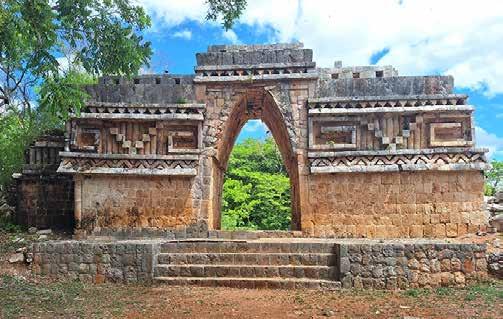
General admission fee: $70 pesos.
An interesting fact about Labná: The Mirador (lookout point), an elevated structure featuring a more simplistic architectural style compared to the rest of the site, has a slotted crest that will surely catch your eye. The slots allow the air to circulate freely, protecting the structure during storms and hurricanes.
38
Destinos
FOTO: BRENDA ÁVILA
Labná
XLAPAK
Xlapak is the smallest site on the Puuc route, as well as the easiest to explore. The structures are far less preserved, which gives you a clearer idea of the arduous and delicate restoration processes carried out on Maya constructions. The archaeological site is laid out as a 900-meter circuit, taking you through the various structures along the way. Since Xlapak is one of the least visited sites in the area, the circuit also functions as a nature trail, where you can listen to and observe different types of animals and plants in a very unmanicured setting.
Distance from Uxmal to Xlapak: 37 km (about 23 miles).
General admission fee: $70 pesos.
An interesting fact about Xlapak: One of the buildings in the circuit has several small plastic “mosaics” with black and white triangles attached to it. Site researchers placed them to monitor whether the construction is further decaying over time, so it can be detected in time to prevent it from collapsing.
SAYIL
Whether you’re coming from Xlapak or Kabah, Sayil will seem like an extreme change. After admiring the remarkable stelae on display at the entrance of the site, you’ll feel that the first structure is further from the entrance than in other archaeological sites. But rest assured, the longish walk will be worth it, because the first building you will see is the Grand Palace, which lives up to its name: it’s a three-story structure with about 90 rooms. Along its 85-meter façade you’ll notice different degrees of preservation, which will help you understand how the interior is arranged (access to the chambers is closed). Remember to peek at the back; the construction, with all its stone details partially hidden by the jungle, makes it look like something out of an adventure movie.
Distance from Uxmal to Sayil: 32 km (about 20 miles).
General admission fee: $70 pesos.
An interesting fact about Sayil: If you or your companions are not comfortable with disproportionate anatomical representations, it’s best not to take the detour to the “Lord of the Phalluses” stele. In the Puuc region, the scarcity of
cenotes and the complete absence of rivers left the population’s access to water entirely at the mercy of the gods or fertility, so representations of well-endowed people and animals is remarkably frequent.
KABAH
Kabah is the second most important archaeological site in the Puuc region after Uxmal, and it is soon to be the location of the Puuc Archaeological Museum, which is scheduled to open

at the end of this year. Your tour will begin at one of the most impressive structures you can visit and admire up close: the Codz Pop (Kots’ Poop, or rolled mat), a building whose façade is completely covered with stone masks of the rain god, Chaac. At this point, you’ll sense that Kabah is a remarkably comprehensive site and that you have already seen many impressive things. However, the site extends across the road, where you will encounter the Great Pyramid and an arch that, while less ornate than the one in Labná, is also significantly taller.
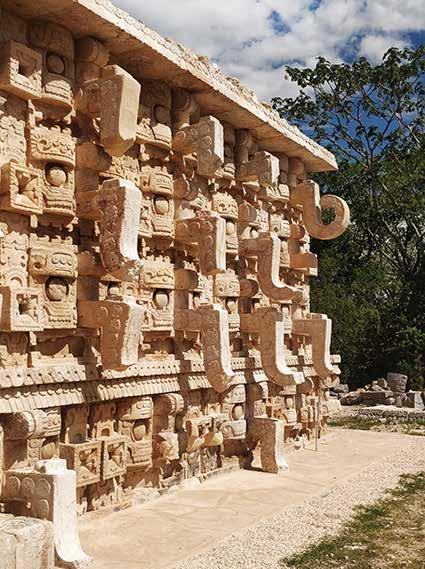
Destinations
39
DESCUBRIENDO LUGARES • YOU’RE GOING PLACES
FOTO: @ATNAVARRETE
Codz Pop, Kabah
There are as many versions of the legend of the dwarf of Uxmal as there are Yucatecos. Here is one version:
In the city of Kabah, an ancient witch found an egg, from which a boy was born. As time went on, his beard grew, but his body remained small. One day, he beat a Tunkul drum the witch kept, so loudly that the sound reached the palace of the king of Uxmal. The king, worried about a prophecy foretelling the end of his rule, challenged the dwarf to a series of tests.
“First, you must build a long, straight, white road.” With the help of the witch and her powers, the dwarf created a Sacbé (white road) that connected the cities of Kabah and Uxmal. Infuriated, the king came up with what he thought was an impossible challenge.
Distance from Uxmal to Kabah: 22 km (about 14 miles).
General admission fee: $75 pesos.
An interesting fact about Kabah: Unlike some archaeological sites that received their current name after the arrival of the Spaniards, the name Kabah is pre-Hispanic, as it is mentioned in the Chilam Balam of Chumayel (one of the few surviving Maya books).
UXMAL
Uxmal is the capital of the Puuc region. Among its many remarkable building groups, like the Nunnery or the Ball Game, a literal standout is the Pyramid of the Magician. You can’t miss it: it’ll be right in front of you as you enter the site, and it’s about 35 meters (115 ft) tall. Its base is also the only one in the Maya area to be rounded. The Pyramid of the Magician is the construction that’s mentioned in the legend of the dwarf of Uxmal; however, contrary to what the legend says, we know that the Pyramid of the Magician was not built in one night. Instead, like many Maya buildings, it spans several construction stages throughout its centuries of existence.
“Tonight you must build the highest house this city has ever seen; if it isn’t finished by dawn tomorrow, you will die.” The king was incensed to wake up the following day and discover what we now know as the Pyramid of the Magician.
“He who survives having three Cocoyol friuts smashed against his head will be the winner.” The witch rubbed a corn tortilla on the dwarf’s head, and so he was unharmed after being hit with the three famously hard fruits.The king, however, died the moment the first Cocoyol hit his head. The prophecy was thus fulfilled: the dwarf became the new king of Uxmal.
Visit www.yuc.today/uxmal-dwarf to read the full version of this legend.
The Pyramid of the Magician cannot be climbed, but you will get a privileged view of the entire site from the Governor’s Palace, considered by many as the most extraordinary example of pre-Columbian architecture in all of America, let alone the Maya area. From there, you will not only see the Great Pyramid, right next to it, and the Dovecote and its elaborate crest, but also the thickness of the jungle that surrounds the visitable area, hiding the vast extent that is still waiting to be explored.
General admission fee: $531 pesos (foreigners), $240 pesos (nationals).
An interesting fact about Uxmal: The elaborate crest of the Dovecote casts the shadow of a snake that crawls along the base of the building during the winter solstice in December.
It is not impossible to visit all the stops on the official Puuc route in a single day. However, attempting to do so can be simply exhausting— especially because of how hot the archaeological sites can get. It is also important to consider that the time you need very much depends on how in-depth you’d like your visit to be: if you only want to take a quick look at the structures and take some photos, less than an hour for each site will feel like plenty.
If you are truly passionate and want to explore each site more thoroughly, an overnight stay is probably the best way to go. For an even fuller experience, make sure to include Oxkintok and Chacmultún in your itinerary, and plan to spend at least two nights along the route. Plus, this will also give you the opportunity to incorporate more (and more varied) activities along your journey.
Visit www.yuc.today/230837 to read our full guide to the Puuc Route, with more information, photos, and options for transportation, accommodations, food, and activities to complement your visit.
OTROS SITIOS ARQUEOLÓGICOS · MORE ARCHAEOLOGICAL SITES
Además de estos sitios y Chichén Itzá, Yucatán cuenta con varios sitios arqueológicos que vale la pena conocer. Visita www.yuc.today/zonas-arq para leer sobre Ek Balam, Mayapán, Dzibilchaltún, Xcambó y otras abiertas al público.
In addition to these sites and Chichén Itzá, Yucatán boasts several archaeological sites that are well worth your time. Go to www.yuc.today/arch-sites to read about Ek Balam, Mayapán, Dzibilchaltún, Xcambó, and others open to the public.


40 Destinos DESCUBRIENDO LUGARES • YOU’RE GOING PLACES
POR / BY ALICIA NAVARRETE @atnavarrete
MAYA MYTH: THE DWARF OF UXMAL
FOTO: ARIANNE OSALDE
FOTO: ARIANNE OSALDE
Pyramid of the Magician, Uxmal
Labná


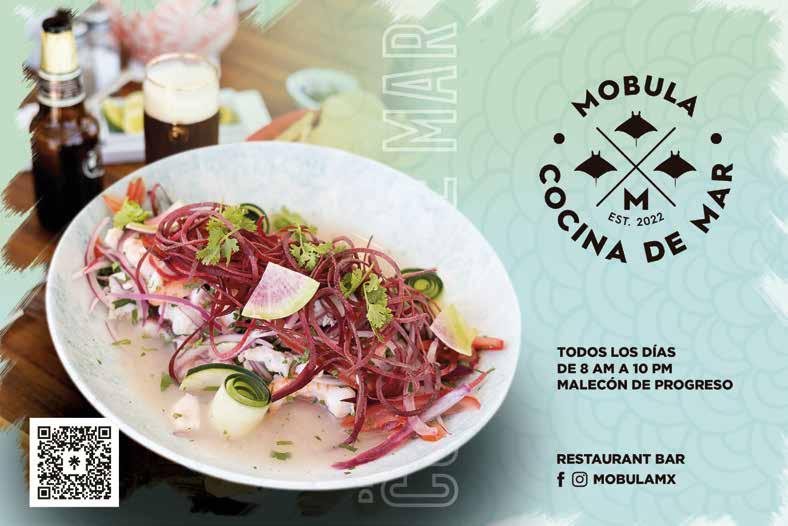
rescos, divertidos y dignos de una escapada para soltar la pesadez de la ciudad: éstas son algunas de las cualidades que acompañan a los cenotes. No son lagunas; tampoco charcas o estanques. Los cenotes son maravillosos espacios subterráneos inundados por agua filtrada a través del suelo calcáreo.
Tipos de cenotes
Encontrarás que los cenotes vienen en muchos colores, formas y condiciones; no hay dos iguales. Tradicionalmente hay tres tipos: los abiertos, los semiabiertos y los cerrados. Unos son muy turísticos, otros son más rústicos. Sea uno u otro, los cenotes son enigmáticos, hermosos y una ventana para echar un vistazo a otro aspecto de la cultura maya: el inframundo.
Los cenotes y el Xibalbá
Los mayas creían que los cenotes y las cuevas eran la entrada al inframundo, Xibalbá; por lo tanto, son considerados lugares sagrados y se debe entrar con respeto. Algunos han sido objeto de estudio por sus vestigios arqueológicos —por ejemplo, el cenote sagrado de Chichén Itzá— y otros todavía cuentan con pequeñas esculturas de sus guardianes. Si lo que quieres es aprender de mitos y leyendas, un guía o los pobladores del área te podrán llenar de magníficas historias.
¿Cómo escoger qué cenote visitar?
Ésta es una duda complicada de resolver: ¡hay demasiados! Y cada uno más bello que el anterior. Para tener un poco de luz respecto a dónde ir, empieza seleccionando un par según su ubicación, accesibilidad al agua y nivel de producción. Algunos cuentan con vestidores, baños y opciones para comer, ya que es posible que termines con ganas de un bocadillo o una bebida.
La realidad es que hay miles de cenotes en Yucatán; muchos tienen señales coquetas sobre la carretera. Explora con cuidado (sin tocar las estalagmitas y estalactitas), diviértete al máximo y, por favor, entra al agua libre de bloqueador solar o repelente para proteger las formaciones de piedra en crecimiento.
resh, fun, and well worth a getaway in nature: these are some of the things that come to mind when we think about cenotes. They’re not lagoons or ponds; cenotes are marvelous subterranean spaces that have been naturally flooded with limestone-filtered water.
Types of cenotes
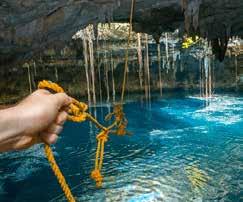
You’ll find that cenotes come in many colors, shapes, and conditions; no two are the same. Traditionally, there are three types: open (exposed, not enclosed in a cave), semi-open (partially exposed), and closed. Some are very touristy, others are more rustic. Whichever you choose, cenotes are enigmatic, beautiful, and a window into another aspect of Maya culture: the underworld.
GUÍA BÁSICA DE CENOTES:
BASIC CENOTE GUIDE:
Poblaciones con muchos cenotes Towns with many cenotes: Homún, Cuzamá y Cenotillo
Para niños y adultos mayores Suitable for kids & seniors Santa Bárbara (Homún)
Instagrameables • Instagram-worthy Hacienda y Cenotes Mucuyché (Abalá)
Hacienda Oxmán (Valladolid)
Suytún (Valladolid), Ik-Kil (Chichén Itzá)
Actividades adicionales • Activities galore Hacienda Selva Maya (Valladolid) Chichikan (Valladolid), X’Canché (Ek Balam) Hacienda Sotuta de Peón
Rústicos cerca de Valladolid Rustic close to Valladolid Xcanahaltún, Palomitas, Dos Aguas, Sac Aua, Yokdzonot y X’Canché
Cooperativas cerca de Chemax e Xcan Co-ops close to Chemax and Xcan Cenote Pueblo Fantasma, Cenote y gruta Nohoch Actun, Cenote Choj Ha
Rústicos cerca de Uxmal Rustic close to Uxmal Kankirixché, Xbatún y el trío: Nah Yah, Suem y Noh Mozón
Nocturnos • Open at night San Ignacio (Chocholá), Zazil Tunich (Valladolid) y Cenote Chihuán (Holcá)
Dentro de la ciudad • Within the city Costco (Mérida) y Zací (Valladolid)
En sitios arqueológicos
At archaeological sites
Xlacáh (Dzibilchaltún), X’Canché (Ek Balam) y Cenote Sagrado (Chichén Itzá)
Visita privada • Private visit Los 7 Cenotes y Destino Mío
Cenotes and Xibalbá
The Maya believed that cenotes and caves were the entrance to the underworld, known as Xibalbá; therefore, they’re considered sacred places and should be entered with respect. Some have been studied for their archaeo-
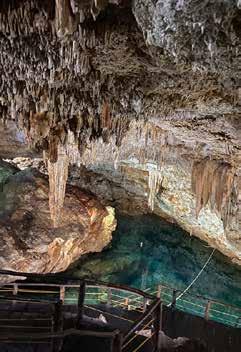
logical remains—for example, the Sacred Cenote at Chichén Itzá—and others still have sculptures of their guardians. If you want to learn about myths and legends, a guide or the community’s locals can tell you magnificent stories.
How to pick the right one for you?
Perhaps the most complicated question to answer, as there are so many cenotes! And each one is more beautiful than the last. To shed some light on where to go, start by selecting a handful based on their location, accessibility, and how wild you’d like for them to be. There are so many to choose from! Some have lockers, restrooms, and restaurants, which come in handy when swimming works up an appetite.
The reality is that there are thousands of cenotes in Yucatán; many have flirty signs on the road to show you where they are. Wherever you decide to go, explore with care, don’t touch the stalactites and stalagmites, have as much fun as possible, and please enter the water free of sunscreen or insect repellent, to protect the growing stone formations.
41 Destinations
F FOTO: YUCATÁN TODAY FOTO: COOX MAYAB
Cenote Pueblo Fantasma
Cenote Xooch Cenotillo
F
CENOTES
rte sacro, sincretismo, historia y arquitectura colonial: esta ruta es para conocedores. La mejor forma de hacer este recorrido es en automóvil; las iglesias, en su mayoría del siglo XVI, no tienen horarios fijos de apertura; tendrás mejor suerte de martes a sábado, entre 8 y 10 am y de 4 a 7 pm.
Acanceh: Frente a la Plaza de las Tres Culturas (nombrada así por reunir las culturas maya, colonial y contemporánea) está la iglesia de Nuestra Señora de la Natividad y la capilla de la Virgen de Guadalupe. Aquí encontrarás también, justo a un costado, dos pirámides que puedes todavía escalar.
Tecoh: Éste es el sitio de una imponente iglesia en honor de la Virgen de la Asunción. Cuenta con mucha piedra labrada, un retablo maravilloso y varias pinturas, incluyendo una atribuida al renombrado artista novohispano Miguel Cabrera.
Telchaquillo: En la fachada de la iglesia dedicada a Nuestra Señora de la Concepción verás glifos mayas grabados y, sobre ellos, una imponente cruz que corona el templo. La iglesia es austera en su interior, pero cuenta con esculturas que sin duda te llamarán la atención.
Tekit: Visita la parroquia dedicada a San Antonio de Padua para admirar su vibrante retablo rojo y dorado; a un costado verás una estatua dedicada a este santo, a quien se le encomendó el pueblo y sus cosechas.
Mama: La iglesia en honor de Nuestra Señora de la Asunción cuenta con cinco capillas y, en un atrio cerrado, un colorido retablo con representaciones de distintos pasajes de la Biblia.
A RChumayel: La iglesia de la Purísima Concepción alberga a un Cristo de madera negra que es muy venerado por considerarse muy milagroso, y que suele estar adornado con prendas donadas en agradecimiento por sus bendiciones.
Teabo: Entre muros y verdes jardines se erigen la parroquia y el exconvento dedicados a San Pedro y San Pablo. En su retablo se representa la Pasión de Cristo con detalles impresionantes.
Maní: En este Pueblo Mágico encontrarás una de las iglesias más grandes del estado, dedicada a San Miguel Arcángel, y un histórico convento que precede al de Izamal. Reserva un recorrido ($35 pesos) para visitarlo y escuchar la historia del Auto de Fe que tuvo lugar aquí, infame por la destrucción de incontables documentos mayas. Aprovecha tu visita para conocer el Solar Maya U Lu’umil Kuxtal, los meliponarios U Naajil Yuum K’iin y Lool-Ha, las grutas con un pequeño cenote, y algún taller de bordado; prepara tu cartera, querrás llevarte todo a casa.

eligious art, syncretism, history, and colonial architecture: this route is not for the uninitiated. The best way to do this tour is by car. The churches, most of them dating from the 16th century, dont have a fixed schedule, so your best bet is to visit from Tuesday to Saturday between 8 am and 10 am, and from 4 to 7 pm.
Acanceh: In addition to the Our Lady of the Nativity church and Our Lady of Guadalupe; chapel, Acanceh is home to several Maya pyramids right in the heart of the village, which you can still respectfully climb.
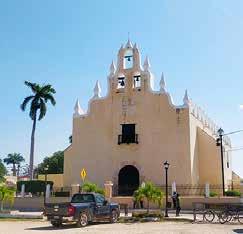
Tecoh: This impressive church honors Our Lady of the Assumption. As it was built on top of a Maya temple, you’ll see plenty of engraved stone, a beautiful altarpiece, and several paintings, including one by renowned colonial artist Miguel Cabrera.
Telchaquillo: On the façade of the church of The Immaculate Conception you’ll see Maya glyphs and a large cross that crowns the temple. Inside, the church is modest, but it has several sculptures that will grab your attention.
Tekit: Visit the parish of San Antonio de Padua to catch a glimpse of its uniquely vibrant red and gold altarpiece; outside on the side street you can see a sculpture of this saint, charged with the protection of Tekit and its corn harvests.
Mama: This church also honors Our Lady of the Assumption. Inside there are five chapels and, within a closed atrium, you’ll find a colorful altarpiece with representations of different passages from the Bible.
Chumayel: The Immaculate Conception church houses a statue of Christ made of black wood that is very revered and known to grant difficult miracles; you’ll often see offerings at the statue’s feet.
Teabo: Surrounded by walls and sitting next to lush gardens, you’ll find the former convent of San Pedro y San Pablo (Saint Peter and Saint Paul). The altarpiece in this temple has images of the Passion of Christ with incredible detail.
Maní: This Magical Town is home to one of the largest churches in the state, devoted to St. Michael and a convent that predates the one in Izamal. Book a tour ($35 pesos) to visit and hear about the Auto da Fe that took place here, infamous for causing the destruction of most pre-Hispanic Maya documents and artifacts. While you’re here, visit Solar Maya U Lu’umil Kuxtal, the U Naajil Yuum K’iin and Lool-Ha native bee farms, the caves of Xcabachén, and an embroidery workshop.
42 Destinos
FOTO: @ATNAVARRETE RUTA DE LOS CONVENTOS • CONVENT ROUTE
Tekit
Muna Hacienda Sotuta de Peón Hacienda Ochil Hacienda Teya Tecoh Telchaquillo Tekit Mama Z.A. Mayapán Xcanchacán Acanceh Hacienda Sta. Cruz Hacienda Petac Hacienda Yaxcopoil Umán Z.A. Aké Kanasín Mérida Cuzamá Homún Chunkanán Temozón Sur S. Antonio Mulix Ticul Oxkutzcab Dzan Sta. Elena Akil Tekax Teabo Chumayel Maní Tipikal Z.A. Uxmal Choco-Story Museo del Chocolate © YUCATÁN TODAY
as haciendas de México eran parte de un sistema económico iniciado por los españoles en el siglo XVI, similar al sistema feudal de Europa. Eran eficientes granjas y centros de manufactura que producían carne y otros productos para exportación. En Yucatán, las haciendas reforzaban el sistema de castas, basado en la raza, con los mayas como esclavos.
La mayoría de las haciendas yucatecas solían ser ganaderas, hasta que en el siglo XIX comenzaron a enfocarse exclusivamente en la producción de henequén, una variedad del cactus de agave, el cual era exportado por la creciente industria de transporte.
La casa principal era usualmente el edificio más grande, donde el hacendado tenía sus habitaciones centrales y donde ocurría la mayor parte de la administración.
El procesamiento de henequén tenía lugar en la casa de máquinas. Había usualmente una capilla, una casa del mayordomo en donde vivía el capataz y muchos otros edificios más pequeños para almacenamiento y habitaciones. Cada hacienda tenía una escuela, una enfermería, una tienda, una iglesia, un cementerio, un área hidráulica, una prisión y los establos.
Las haciendas de Yucatán llegaron a su apogeo a principios de 1900, impulsadas por la próspera economía local que florecía gracias a la fibra de henequén usada para hacer soga, cuerda y cordel.
Hacienda Santa Rosa
Hacienda Sotuta de Peón
Hacienda Temozón Sur Hacienda Uxmal Plantation
Hacienda Yaxcopoil
Hacienda y Z. A. de Aké
Hacienda Mucuyché
Hacienda San Lorenzo Oxman
Hacienda Santa Cruz Palomeque
Las casonas en el Paseo de Montejo y Avenida Colón en Mérida son las casas que el “oro verde”, el henequén, ayudó a proveer. Después de la Guerra de Castas en Yucatán y posteriormente la invención de fibras sintéticas, la mayoría de las haciendas fueron abandonadas, hasta la década de 1990, cuando muchas fueron restauradas a su gloria original.
Hacienda Santo Domingo de Yunkú
Hacienda Santuario Noc Ac
Hacienda Tepich
Hacienda Zamná
Haciendas in México were the basis of an economic system that the Spaniards began in the 16th century, similar to the feudal system of Europe and the plantations of the southern U.S. They were efficient farming and manufacturing centers that produced meat and other products for export. The haciendas enforced a social system of castes, based on race, with the Maya as slaves. Most Yucatecan haciendas in the 19th century produced rope from Henequén (sisal), a variety of the agave cactus, which was exported for the booming shipping industry. The main house, or Casa Principal, was usually the largest building, where the Hacendado kept his living quarters and where the administration took place.
• Maxcanú
• Carr. Tekik de Regil-Uayalceh
• Abalá
• Z.A. Uxmal
• Carr. Umán-Muna
• Carr. Tahmek-Tixkokob
• Carr. Abalá-Telchaquillo
• Valladolid
• Mérida
• Carr. Mucuyché-Sacalum
• Carr. Mérida-Chuburná Puerto
• Acanceh
• Carr. Baca-Timul
Henequén processing took place in the machine house, or Casa de Máquinas. There was usually a chapel, a Casa del Mayordomo, where the foreman lived, and many other smaller buildings for storage and living quarters. Each hacienda had a school, infirmary, store, church, cemetery, hydraulics area, jail, and stables.
Un viaje a Yucatán estaría incompleto sin visitar las haciendas del estado, ya que muchas de ellas han sido convertidas en hermosos hoteles de cinco estrellas, con elegantes cuartos, donde se sirven suntuosas cenas, con piscinas y magníficas tierras; otras haciendas son museos que proveen un vistazo a la época colonial; unas más están ocupadas por gente local, cuyos ancestros las reclamaron durante la Revolución Mexicana; y otras permanecen sin restaurar, abiertas a los daños del tiempo.
Visita www.yucatantoday.com/haciendas-yucatan para leer la versión extendida de este artículo.
The haciendas of Yucatán saw their heyday in the early 1900s when the local economy was booming due to the Henequén fiber that was used worldwide to make rope, cord, and twine. The mansions on Paseo de Montejo and Avenida Colón in Mérida are the rich homes the “green gold,” Henequén, helped provide. After the Yucatán Caste War and later the invention of synthetic fibers, most haciendas were abandoned to decay in the jungle until the 1990s, when many of them were brought back to their former state of glory.

Some haciendas in Yucatán have been renovated into beautiful five-star hotels, complete with elegant rooms, sumptuous dining facilities, swimming pools, and magnificent grounds. Other haciendas are museums, providing a glimpse into former colonial times. Others are lived in by locals whose ancestors reclaimed them during the Mexican Revolution; still others remain unrestored and open to the ravages of time.
Visit www.yucatantoday.com/en/haciendas-yucatan to read the extended version of this article.

43 Destinations
L
HACIENDAS
TOURS • PASADÍA / TOURS • DAY PASS
Hacienda Tekik de Regil
FOTO: CATHERWOOD TRAVELS
bicada a 125 km de Mérida, Chichén Itzá, una de las siete maravillas del mundo moderno, es para muchos una visita obligada en Yucatán. Es el sitio maya mejor conocido. Lo que la hace imperdible son sus estructuras variadas y preservadas incluyendo la majestuosa Pirámide de Kukulkán.
El nombre Chichén Itzá proviene de las palabras mayas: “Chi”, boca, “Chén”, pozo e “Itzá”, el nombre del pueblo que gobernaba esta región. En el sitio podrás observar una gran variedad de influencias arquitectónicas. De manera general, el sitio se divide en tres áreas: el Grupo Norte (con una clara influencia Tolteca), el Grupo Central (del periodo Temprano) y el que es conocido como Viejo Chichén (de estilo Puuc, pero que está cerrado a los visitantes).
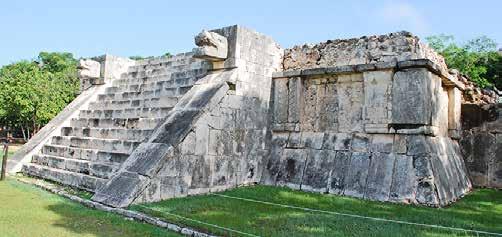
Entre lo más destacado está la famosa Pirámide de Kukulkán, el Templo de los Guerreros, el Juego de Pelota, el Conjunto de las Monjas y el Caracol. También tienes que ver el Cenote Sagrado, donde se encontraron gran cantidad de ofrendas incluyendo cerámica, tela, oro, jade e incluso restos humanos. Es muy importante recordar que está estrictamente prohibido nadar aquí.
El parador está muy bien equipado con restaurantes, baños y tiendas de regalos. Desde el 2006, no se permite escalar ninguna de las estructuras de este sitio. Buena parte es accesible en silla de ruedas.
CHICHÉN ITZÁ EN CORTO
Abierto todos los días del año de 8 am a 4 pm. Entrada: $614 pesos (extranjeros), $272 pesos (mexicanos) y $90 pesos (locales). Entrada gratuita para mexicanos los domingos.
Espectáculo de luz y sonido: Visita el sitio web para ver fechas disponibles www.nochesdekukulkan.com
Para llegar: En automóvil, desde Mérida toma la carretera Mérida - Cancún de cuota (la forma más directa) y sigue los señalamientos hasta llegar a Chichén Itzá. Para llegar por autobus, ADO cuenta con varias salidas matutinas diarias para que puedas realizar tu visita. También puedes participar en alguna de las salidas diarias organizadas por una agencia de viajes.
ocated 125 km from Mérida, Chichén Itzá, one of the seven modern wonders of the world, is considered a must-see site in Yucatán. It’s without a doubt the bestknown Maya archaeological site and part of what makes it so special is its varied and well-preserved structures such as the Pirámide de Kukulkán.
The name Chichén Itzá comes from the Maya words “Chi,” mouth; “Chén,” well; and “Itzá,” which was the name of the people that governed this region. At the site you will be able to observe a wide array of architectural influences, and it is generally divided into three
areas: the north group (with a clear Toltec influence), the central group (from the early period), and what is known as Old Chichén (with Puuc-style constructions that remain closed to visitors).
The highlights include: the magnificent Castillo de Kukulkán, the Temple of the Warriors, the Grand Ball Court, the Nunnery, and the Observatory. Be sure to also take a look at the Sacred Cenote, where a large number of offerings were found including ceramics, fabrics, gold, jade, and even human remains. Just remember that swimming there is strictly forbidden.
At the main entrance you will find restaurants, bathrooms, and gift shops. Climbing any of the structures at this site has been forbidden since 2006.
A good part of the site is wheelchair-accessible.
How to get there: By car, from Mérida, take the Mérida - Cancún toll highway (the most direct way), and follow the road signs to Chichén Itzá. By bus, catch one of the several morning departures at the ADO terminal. Many travel agencies also have daily departures (and tours) to the mighty Chichén Itzá.
CHICHÉN ITZÁ IN FIGURES
Open every day of the year from 8 am to 4 pm. Entry: $614 pesos (foreign visitors), $272 pesos (Mexican citizens), and $90 pesos (locals).
Free admission for Mexicans on Sundays.
Video mapping: Check website for available dates
Tickets: www.nochesdekukulkan.com
44 Destinos CHICHÉN ITZÁ
U L
FOTO: JUAN MANUEL MIER Y TERÁN C.
uchas riquezas hacen de Valladolid un Pueblo Mágico, como sus bellas calles e iglesias, su gastronomía y su gente. Lo que sobra en esta ciudad es paz, aunque no siempre fue el caso. Fundada en 1543, fue el escenario de vastas confrontaciones entre los conquistados y los conquistadores, desde la Guerra de Castas en 1847 a la Primera Chispa de la Revolución Mexicana en 1910. Hoy es una encantadora ciudad en la que vale la pena quedarse cuando menos un día.
La Calzada de los Frailes: Puedes pasar días recorriendo esta calle emblemática que se construyó en el siglo XVI para llegar al barrio de Sisal. Comienza en la esquina de las “cinco calles” y finaliza en el exconvento San Bernardino; ahí encontrarás varias boutiques y rincones para los amantes del café.
Sitios de Cultura: La Casa de los Venados es una parada esencial en tu visita. Una pareja estadounidense abre las puertas de su casona restaurada y comparte su colección de más de tres mil piezas de arte popular mexicano, la más grande en manos privadas. Están también los museos MUREM (Museo de Ropa Étnica Mexicana) y de San Roque, y la Casa Ramón Mendoza. Choco-Story, por su parte, te llevará por un recorrido fascinante por la cultura maya y su historia con el cacao.
San Bernardino de Siena: Visita el exconvento fundado en 1552 por los franciscanos que llegaron de Siena, Italia. No podrás resistir una sesión fotográfica tras otra, tanto en su magnífica fachada y sus jardines como en su interior color de rosa.
Barrios: La ciudad cuenta con seis de origen colonial, cada uno con su propia iglesia, encantador parque y atractivo: Santa Lucía,
Video mapping: todos los días, en español e inglés, en las paredes del ex-Convento San Bernardino de Siena. Entrada libre.
Para llegar: En auto desde Mérida, toma la carretera de cuota y sigue los letreros hacia Valladolid. Por autobús, hay salidas diarias desde la Terminal ADO Mérida Centro Histórico o de los Autobuses del Centro.
LO QUE NO PUEDE FALTAR
· Toma el tour gratuito todos los dias desde la plaza, verifica los horarios.
· Prueba los lomitos de Valladolid, la longaniza de Valladolid o el escabeche oriental.
· Nada en un cenote cristalino.
· Visita Ek Balam o Chichén Itzá.
There are quite a few riches that make Valladolid a “Pueblo Mágico,” such as its beautiful streets, churches, gastronomy, and people. What this town is not lacking is peace, though this was not always the case! Founded in 1543, it was the stage of vast confrontations between the Maya and the Conquistadores during events such as the Guerra de Castas (1847) and the first spark of the Mexican Revolution (1910). Today, Valladolid is a charming Yucatecan city worth a day-long visit, at the very least.
La Calzada de los Frailes: You can spend days strolling along this charming street built in the 16th century for access to the Sisal neighborhood. It starts at the corner of the Cinco Calles, and ends at the former convent San Bernardino de Siena. You’ll find boutiques and charming spots for coffee lovers.
Cultural Sites: Casa de los Venados is a must. An American couple opens the doors of their restored Casona and shares their more than 3,000-piece collection of Mexican folk artthe largest in private hands. The city is also home to MUREM (Museum of Mexican Ethnic Clothing), Museo de San Roque, Casa Ramón Mendoza and Choco-Story, a museum that takes you through Maya culture and its history with cacao.
San Bernardino de Siena: Head over to the former convent San Bernardino, founded in 1552 by the Franciscans from Siena, Italy. You won’t resist a photo shoot after another while visiting its magnificent façade, gardens, and pink and beautifully lit corridors.
Barrios: The town has six colonial neighborhoods, each with its own church, park, and particular charm: Sisal, Santa Lucía, Candelaria, San Juan, Santa Ana, and Centro.
Video mapping: available in English and Spanish, on the walls of the former convent San Bernardino de Siena. Free entry.
How to get there: By car from Mérida, take the Mérida - Cancún toll highway, and follow the road signs to Valladolid. By bus, there are daily departures from Terminal ADO Mérida Centro Histórico or from Autobuses del Centro.

CalzadadelosFrailes
WHAT YOU SHOULDN’T MISS
· Take the free walking tours starting at the main plaza every day at 10 am and 7 pm, (schedules may vary).
· Try the Lomitos de Valladolid, Longaniza de Valladolid, or the Escabeche Oriental.
· Swim in one of its many crystal-clear cenotes.
· Go to Ek Balam or Chichén Itzá.
45 Destinations
La Candelaria, Sisal, San Juan, Santa Ana y el Centro.
Cenote Dzitnup 7 km Chichén Itzá 40 km Calle 37 Calle 51 Calle49 Calle 45 Calle 45 Calle 33 Calle 41 Calle 36 Calle 40 Calle 54 Calle 48 Calle 39 Calle 35 Calle 43 Calle 38 Calle 46 Calle 50 Calle 52 Calle 42 Calle 44 ADO Iglesia de San Servacio Casa Ramón Mendoza Mercado Zací Choco-Story San Roque Santa Ana Casa de los Venados Le Muuch Convento de San Bernardino de Siena Autobuses de 2a.
Calle 34 Calle 34 Calle 47 Calle 47 Calle47 Cancún (Cuota) 156 km Mérida (Cuota) 160 km Hotel Olbil 300 m Tulum Libre 102 km Cancún Libre 160 km Museo de Ropa Étnica de México Calle 49 Video mapping © YUCATÁN TODAY M VALLADOLID
FOTO: JUAN MANUEL MIER Y TERÁN C.
bicado a tan solo una hora de la capital, Izamal es uno de los Pueblos Mágicos de Yucatán. Notarás de inmediato que la conocida “Ciudad de los Cerros” está pintada de un amarillo brillante; hasta te parecerá que irradia felicidad. Aquí te presentamos algunos de los sitios y actividades que ofrece para ti.
Convento San Antonio de Padua: Su impresionante atrio, de 8,000 m2, no puede no impactarte: es el atrio cerrado más grande de toda América. El convento, fundado por Fray Diego de Landa en 1549, se construyó sobre la base del templo maya Pap-Hol-Chac; esto hace que sea uno de los puntos elevados más fotogénicos de Yucatán, ideal para disfrutar la brisa.
Dentro del convento puedes visitar el altar de Nuestra Señora de Izamal (la patrona del estado, celebrada cada 8 de diciembre), ornamentado en estilo barroco. Visita también su camarín, un amplio y elegante cuarto donde los vestidos y accesorios de la Virgen son resguardados.
Sitios arqueológicos: Dentro de la ciudad, la cultura maya vive, y hay seis sitios arqueológicos que se pueden apreciar: Kinich Kakmó (el principal atractivo maya de Izamal y la pirámide más grande en superficie del estado), T’u’ul (El Conejo), Habuk, Itzamatúl (el cual pasó por tres etapas de construcción), Kabul y Chaltún Ha. El acceso es gratuito y puedes escalar las estructuras.
Centro Cultural y Artesanal: Una excelente parada para los amantes del arte. Podrás contemplar interesantes e innovadoras propuestas y escoger una pieza única para llevarte a casa (entrada $25 pesos).
Artesanías: Maravíllate con la tienda Hecho a Mano, llena de arte popular mexicano. Vi-

sita el taller de Don Esteban Abán, o adquiere artesanías y productos locales en la Plaza Constitución.
Shamanismo maya: En el santuario del Hermano Maya podrás participar en diversas ceremonias o realizarte una limpia.
Cocina Regional: Kinich, Zamná o Los Arcos.
Video Mapping: Jue. - sáb. 8 pm, Parque de los Cañones, Izamal. Entrada: $104 pesos (mexicanos) y $149 pesos (extranjeros).
Para llegar: En coche deberás tomar la autopista Mérida - Cancún, desvíate en el km 48 hacia Izamal, duración aprox. 45 min en carro. En autobús, la terminal está en la Calle 67 x 50 y 52, con salidas cada hora. En van hay más salidas y precios económicos; el paradero está en la Calle 65 x 52 y 54
LO QUE NO PUEDE FALTAR WHAT YOU SHOULDN’T MISS
El Convento de San Antonio de Padua. Un almuerzo regional.
· El Video Mapping. La pirámide Kinich Kakmó. Una ceremonia maya.
· The San Antonio de Padua convent.
· A Yucatecan lunch.
· The Video Mapping.
· The Kinich Kakmó pyramid.
· A Maya ceremony.
Located one hour away from the capital, the yellow city of Izamal seems to radiate happiness. Here are some of the sights and activities it offers:

Convento de San Antonio de Padua: You can’t not be impressed by its massive atrium, measuring almost 8,000 sq m (over 86,000 sq ft): it’s the largest closed atrium on the continent. The convent, founded by Fray Diego de Landa in 1549, was built on top of the Maya temple Pap-Hol-Chac, which makes it one of Yucatán’s most picturesque lookout points and a great spot to enjoy the breeze.
Inside the church itself, you will see the beautifully restored altarpiece, the stained-glass window of St. Francis of Assisi, and many statues along the walls. The second floor is where the statue of Our Lady of Izamal, Queen and Patron
Saint of Yucatán, is housed. Nuestra Señora de Izamal is celebrated every December 8. You can also visit her Camarín (dressing room), an ample and elegant room where the Virgin’s elaborate dresses and accessories are kept.
Archaeological sites: Inside the city, Maya culture is front and center with six main sites: Kinich Kakmó (the largest pyramid in the state, surface-wise), T’u’ul (“The Rabbit” in Maya), Habuk, Itzamatúl, Kabul, and Chaltún Ha. Admission to all the sites is free and respectfully climbing the structures is allowed.
Centro Cultural y Artesanal: An excellent stop for art lovers to contemplate interesting and innovative artworks (entrance $25 pesos).
Shopping: Discover artisans’ talent at Hecho a Mano and be marveled by Mexican folk art. Visit Don Esteban Aban’s workshop. On Plaza Constitución you can buy a variety of handcrafts and local products.
Maya shamanism: Another must is Hermano Maya’s sanctuary, where you can participate in traditional ceremonies, or even have a “cleanse” done to do away with bad luck.
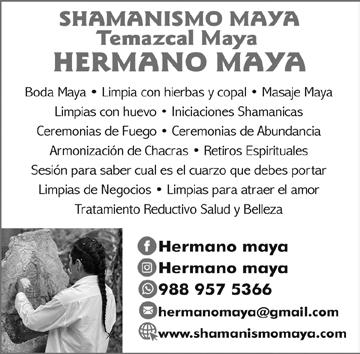
Where to eat: Be delighted by exquisite regional food at Kinich, Zamná, or Los Arcos.
Video mapping: Thu. - Sat. 8 pm, Parque de los Cañones, Izamal. Entry fee: $104 pesos (Mexicans) and $149 pesos (foreigners).
How to get there: From Mérida, take the highway towards Cancún and exit at Km 48 towards Izamal at the Hoctún exit. By bus, the terminal is on Calle 67 x 50 y 52, with departures every hour. Vans offer more departures; the stop is at Calle 65 x 52 y 54, Centro.
46 Destinos
U
IZAMAL
FOTO: LAURA PASOS
isal: Es uno de los pueblos mágicos de Yucatán, y el único que se encuentra en la costa. Desde el siglo XVI se convirtió en el principal puerto del estado y el punto de entrada y salida de mercancía y viajeros, incluida la emperatriz Carlota de México en 1865. Sin embargo, el fuerte de su volumen de carga estuvo en el henequén, que de hecho es conocido como “sisal” en el extranjero debido a que las cajas que lo contenían traían el sello de este puerto.
Visita el muelle y el Fuerte de Santiago; la pequeña plaza te invita a tomarte fotos con los cañones y sillas confidentes. En la ex-Aduana, edificio histórico que hoy alberga una biblioteca, encuentras una amplia oferta de actividades para todas las edades e intereses: buceo, pesca deportiva y artesanal, avistamiento de aves, pasadías en la bocana, en el manglar y en los petenes, visitas al ojo de agua, snorkel en el arrecife, barcos y cañones hundidos (únicos en la zona), tours especializados en fotografía de aves, flamencos o cocodrilos, senderismo (a pie o en bicicleta) o paseos a caballo por la playa. Todas están disponibles a través de guías locales certificados.
Para una estancia más relajada, pasa el día en sus amplias playas, visita el muelle y disfruta de los pescados y mariscos que se ofrecen en sus restaurantes.
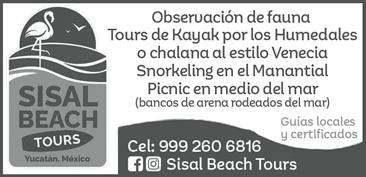
Celestún: Celestún es considerado desde 1979 como Patrimonio Mundial de la Reserva Especial de la Biósfera. Aquí, de noviembre a marzo, encontrarás una de las colonias de flamencos rosados más grandes del mundo. Estos factores son la razón por la que miles de visitantes de todas las edades vienen a este tranquilo puerto, localizado a 96 km de Mérida.
La forma más segura de avistar aves y apreciar la belleza natural de este puerto es mediante un un tour en lancha. En la entrada del puerto encontrarás un parador con estacionamiento, baños, tienda y el embarcadero. El paseo tiene una tarifa fija de $2,200 pesos por lancha, con cupo para hasta seis personas adultas (o cuatro adultos y dos niños). El tour dura poco más de una hora e incluye la visita a la zona de flamencos, el recorrido por el manglar y el acceso al ojo de agua Baldiosera, donde puedes bañarte.
Por tu propia seguridad y la de la naturaleza, asegúrate de contratar tu tour únicamente con guías certificados.
Para llegar desde Mérida: En auto, toma la salida a Tetiz desde Periférico; para ir a Sisal tomarás la desviación hacia Hunucmá. En ambos casos, el viaje durará aproximadamente una hora. En autobús, las salidas a Sisal son desde la terminal 50 (Calle 50 x 65 y 67, Centro), diariamente a las 5 pm y los regresos a las 6 am; los domingos hay una corrida adicional que sale a las 8:30 am y regresa a las 6 pm. A Celestún puedes ir en taxi colectivo (Calle 67 x 48 y Av. Primero de Mayo, Centro); el viaje dura aproximadamente 75 minutos. No hay horarios fijos de salida, pero el pasaje cuesta alrededor de $65 pesos.
Sisal: It’s one of Yucatán’s four Magical Towns, and the only one by the beach. Back in the 16th century, it became the state’s main port and sole entry point for visitors, including Empress Carlota de México in 1865. Sisal was also where Henequén fibers were exported from Yucatán to points all over the world; the port’s stamps on the cargo boxes are the reason the fiber is known worldwide as sisal.
Visit the pier and the Fort of Santiago; the square is perfect for photos with authentic cannons and traditional confidant chairs. At the former Customs Office, you will find information on a variety of activities for all ages and interests: snorkeling, scuba diving, sport and artisanal fishing, bird watching, day tours to the estuary, the mangrove, and the freshwater spring, tours to see the sunken ships and cannons (unique in this region), hiking and bike rides, and even horseback riding on the beach. All these activities are available with certified tour guides.
For a more relaxed stay, spend the day on its sandy beaches, walk along the pier, and enjoy the fish and seafood offered at its many restaurants and even bars.
Celestún: Celestún was appointed World Heritage Biosphere Reserve in 1979; here, especially between November and March, you’ll find one of the largest pink flamingo colonies in the world. Any of those may be the reasons why thousands of people make the hour-long trip to this port every year.
The best way to see the birds and appreciate Celestún’s natural beauty is taking a boat tour. As you’re driving into town, just by the bridge, there’s a visitor center with parking, restrooms, a store, and a dock. You can hire the tour at a fixed rate of $2,200 pesos for up to six adults (or four adults and two children). The tour lasts a little over an hour and includes a visit to see the flamingo colony, an expedition through the mangrove, and access to the Baldiosera water spring, where you can swim.

For your own safety and that of the local wildlife, make sure to hire your tour from licensed guides only.
How to get there: By car, take the Tetiz exit on Periférico (it goes all the way to Celestún) and follow the signs; for Sisal, you’ll take the detour to Hunucmá. Both trips are roughly an hour drive. By bus to Sisal, Autobuses Oriente (Calle 50 x 67, Centro) offers one daily departure to Sisal leaving at 5 pm, and from Sisal to Mérida at 6 am. On Sundays, there is an additional run leaving Mérida at 8:30 am and Sisal at 6 pm. To Celestún, a shared van (Calle 67 x 48 y Av. Primero de Mayo, Centro) trip is about $65 pesos. There aren’t set schedules; vans leave as they fill up.
47 Destinations
S FOTO:MKCT
SISAL / CELESTÚN
Manglar, Sisal
Progreso de Castro es hoy en día uno de los puertos más reconocidos de México, y sin duda el más importante de la Península de Yucatán. Sin embargo, a comparación del resto del estado, es una población bastante joven: se fundó apenas en el año de 1871 como respuesta a la necesidad de trasladar la aduana, que entonces estaba en Sisal, a un lugar más cercano a Mérida.
Su muelle, que data originalmente de los 1930s, comenzó midiendo 2 km de largo; la poca profundidad del Golfo de México ha dado lugar a ampliaciones y extensiones que lo han llevado a ser el más largo y de los más icónicos del mundo, con 6.5 km de longitud, certificado con el récord Guinness desde julio de 2023.
Progreso ofrece oleaje tranquilo y seguro para nadar o sólo disfrutar la playa. Puedes ir temprano para ocupar lugar en un restaurante o un club para disfrutar todo el día en la playa, o dedicarte a recorrer el Malecón y detenerte en las distintas atracciones que ofrece para todas las edades. En cualquier caso, seguro lo pasarás muy bien.
Progreso ofrece cada vez más cosas para deleitar a visitantes y residentes; aquí te compartimos una probadita de algunas.
Malecón Tradicional: Hacia el lado derecho del muelle (viendo hacia el mar), verás espacios fotogénicos, como las letras de Progreso, y varios deliciosos restaurantes que tienen vista al mar.
Malecón Internacional: Al lado izquierdo del muelle encontrarás juegos para niños, un jardín de lectura, cine al aire libre, carrusel, rueda de la fortuna, baños y muchas estatuas con las que te divertirás posando para una foto. Es perfecto para visitarlo a cualquier hora, sin embargo, en la tarde es particularmente agradable.

Museo del Meteorito: ¿Sabías que una buena parte de Yucatán se encuentra en el cráter de impacto del meteorito que acabó con los dinosaurios hace 65 millones de años? Progreso ahora cuenta con un museo interactivo que te llevará por la historia del planeta, incluyendo las varias extinciones masivas, la vida de los dinosaurios y las consecuencias del impacto que les puso fin.

Además de ser una experiencia súper educativa y fascinante para niños (y adultos) de todas las edades, las mega esculturas de distintos tipos de dinosaurios serán un hit entre chicos y grandes. Consulta sus tarifas en nuestra página 10.
Qué comer: Lo más típico son los ceviches y el pescado frito (disponibles en varios restaurantes), pero las opciones son infinitas. ¿Te gustaría comer con vista al mar? Acércate a Crabster, Eladio’s, Almadía, El Ha Guay o Mobula. Si buscas un espacio más allá del Malecón, están Silcer Club de Playa, La Antigua y Yum Ixpú.
Comida callejera: Si eres aventurero, anímate a probar los dulces de las bandejas que llevan de un lado a otro de la playa:
los hay de coco, pepita, cacahuate y merengues, además de paletas y caramelos. Otras golosinas que te ofrecerán en la playa son vasos de fruta con chile, helados y granizados, además de cocos fríos. Por la tarde, asegúrate de probar también una marquesita, un esquite, o un elote preparado para realmente disfrutar de Progreso como los yucatecos.
Ecoturismo: Visita la Reserva Ecológica El Corchito para ver manglares, ojos de agua y la flora y fauna de la costa. Otra opción es la Ría de Progreso, en donde, además de ver familias pescando con cordel, puedes realizar tours en kayaks dentro de los manglares, practicar stand-up paddle, o solamente pasear.
Más puntos de interés: Visita Pig Beach entre 8 am y 6 pm para ver a una familia de cerditos rescatados por la policía ecológica municipal. Míralos nadar (o mejor aun, acompáñalos) de jueves a domingo entre las 12 y la 1 pm. Complementa tu visita con una clase de kitesurf, una escapada a Chelem, o visitando el Sendero Jurásico en Chicxulub (detalles en la pág. 50).
Para llegar: Manejando desde Mérida, sólo sigue al norte en la Calle 60 o Paseo de Montejo hasta llegar a Progreso. En autobús, Autoprogreso opera desde las 5 am hasta las 10 pm. Puedes tomarlo desde la terminal (Calle 62 x 65 y 67) o en cualquiera de las paradas a lo largo del trayecto entre Mérida y Progreso.
48 Destinos
PROGRESO
FOTO: YUCATÁN TODAY
Museo del Meteorito
FOTO: YUCATÁN TODAY
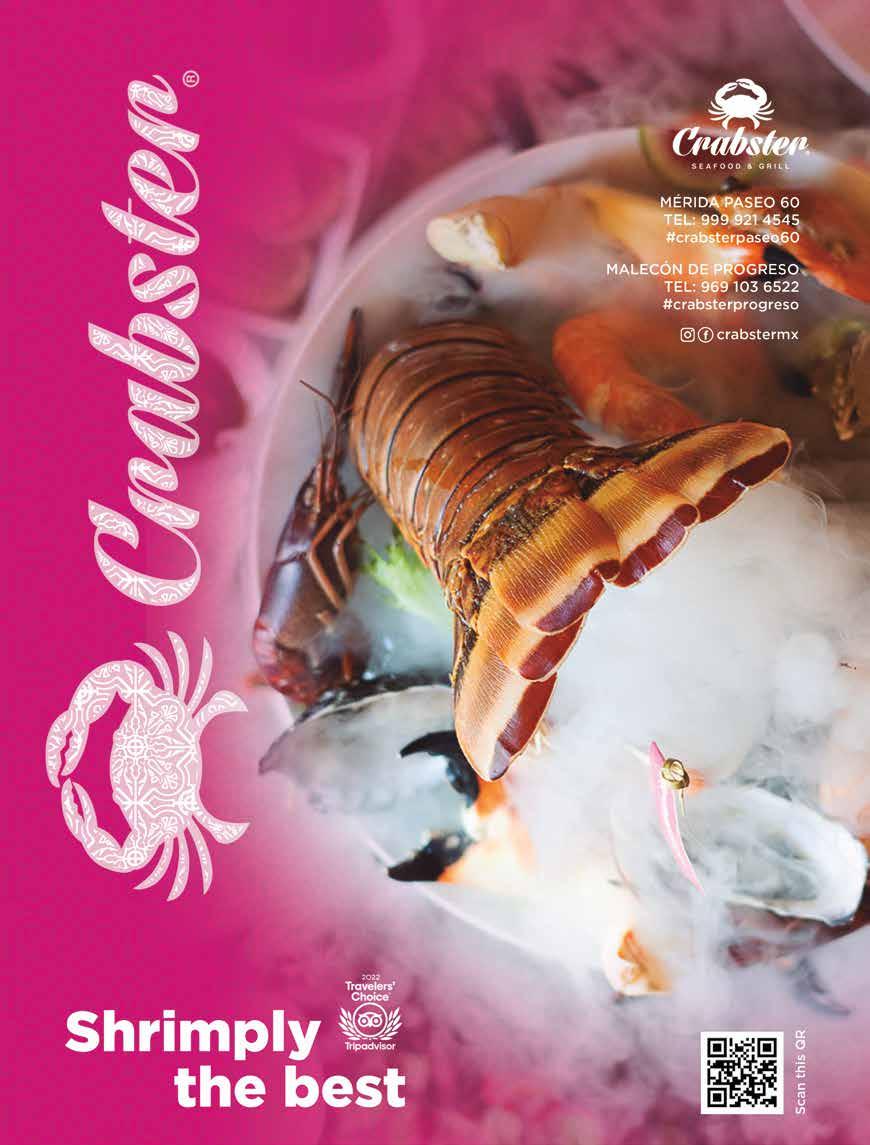

rogreso de Castro is, nowadays, one of México’s most recognizable ports, and, without a doubt, the most important one in the Yucatán Península. However, it’s a rather young settlement compared to other places in the state: it was founded in 1871, with the explicit purpose of avoiding the longer travel time to the more historical port of Sisal.
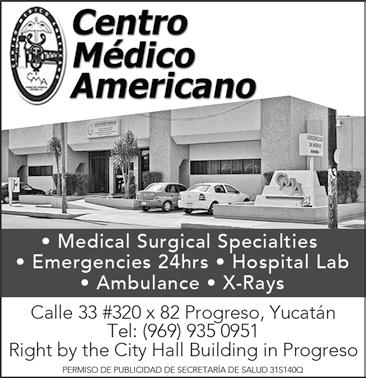
The Progreso dock was originally built in the 1930s, measuring 2 km (1.3 mi). The shallow waters of the Gulf of Mexico have given way to extensions that have led to it becoming the longest in the world at 6.5 kilometers (4 mi).


Progreso usually offers small, gentle waves that are safe for swimming or just enjoying the beach. If you’re there early, you can get yourself a table at a restaurant or beach club to enjoy a full day at the beach, or spend it strolling down the Malecón (boardwalk), leisurely stopping at the many attractions it offers for people of all ages. You’ll have a great time either way. Here are a few sights and attractions.
Malecón Tradicional (Traditional Boardwalk): To the right of the pier (if you’re facing the water) you will catch several landmarks and unique buildings which you can take lots of pictures with (including the Meterorite Museum, more info below), and restaurants with a stellar view of the Gulf of México.
Malecón Internacional (International Boardwalk): To the left of the pier there is a newer area where there are several attractions such as playgrounds, a reading garden, an outdoor cinema, a carrousel, a Ferris wheel, bathrooms, and lots of cool statues you’ll have tons of fun taking pictures with. It’s perfect for a visit anytime, but late afternoons (and the sunset) tend to be the highlight of the day.
Meteorite Museum: Did you know that a good portion of Yucatán is inside the impact crater left behind by the meteorite that killed
the dinosaurs 65 million years ago? Progreso now has an interactive museum that commemorates this fact while giving you a tour of the history of the planet, including the various mass extinction events, the life of the dinosaurs, and what exactly happened when the meteor struck—it’s mind-boggling.
The museum is a fascinating educational experience on its own, but the different types of dinosaur sculptures will impress children and adults alike, and make for great pictures. Check out the museum’s rates on page 10.
What to eat: Locals’ favorite dishes include fresh ceviche and fried fish, but options are endless, for both restaurants and dishes. Are you looking for a place to eat with a nice view of the beach? Go to Crabster, Eladio’s, Almadía, El Ha Guay, or Mobula. If you are looking for a place beyond the boardwalk, you could try Silcer Club de Playa, La Antigua, or the no-frills local favorite, Yum Ixpú.
Fun Street Food: If you’re feeling really adventurous, try the candy sold on trays that are carried up and down the beach; you’re guaranteed to see at least one vendor. There are coconut, pumpkin seed, and peanut options, as well as meringues and caramels in all shapes, colors, and sizes.
Other daytime vendor treats include baggies or cups of tropical fruit (dressed with powdered chili to taste), ice cream and shaved ice, and cold coconuts. In the afternoons, Marquesitas and dressed corn (both in cups or on the cob) are additional options to really enjoy Progreso like the locals.
Additional attractions: At El Corchito Eco-Reserve you’ll see mangroves, springs, and many of the coastline’s plants and animals in the wild Another great option is the Ría de Progreso, where, in addition to seeing local families line-fishing, you can do many activities like taking mangrove tours; there’s also a rowing area where you can rent kayaks and canoes to get a low-impact workout out in nature .
Visit the piggies at Pig Beach between 8 am and 6 pm; stop by Thu. - Sun. 12 - 1 pm to join them for a swim. Feeling adventurous? There are several kitesurfing schools that offer beginner lessons. For additional dino-fun for kids, visit Sendero Jurásico (more details on page 50).
How to get there: Driving from Mérida just go north until you reach Progreso. You can’t miss it! By bus, the Autoprogreso bus leaves every 10 minutes between 5 am and 10 pm. You can take it at the terminal (Calle 62 x 65 y 67) or at any of its stops along the road to Progreso.
49 Destinations
PROGRESO
FOTO: YUCATÁN TODAY
Malecón Internacional
P
FOTO: YUCATÁN TODAY
P
Cómo llegar: Toma la desviación hacia Chelem en la carretera Mérida a Progreso y sigue hacia el oeste; también puedes tomar la nueva carretera a través de Sierra Papacal.
Chelem: Este tranquilo poblado se encuentra 10 kilómetros al oeste de Progreso, pero separado del mismo por el puerto de abrigo y varias marinas. Cerca de la plaza principal, encontrarás minisúpers, un centro de salud, un mercado y una parada de colectivos que viajan desde y hacia Progreso.
Chelem tiene una cantidad sorprendente de restaurantes de comida regional e internacional; también hay múltiples restaurantes familiares que sirven pescados y mariscos frescos. De postre, detente en cualquier puesto de cocos para probar alguna de las múltiples presentaciones que manejan.
Chicxulub Puerto: Este pequeño pueblo pesquero está 7.5 km al este de Progreso. Su nombre se hizo de fama internacional en los últimos años, pues al ser el poblado más cercano al punto de impacto del meteorito que acabó con los dinosaurios hace unos 65 millones de años, el cráter ahora lleva su nombre. Aunque el Museo del Cráter de Chicxulub se encuentra en Progreso (más información en la pág. 48), aquí encontrarás el Sendero Jurásico, una experiencia interactiva a lo largo de tan sólo unos cuantos metros. Si tienes el tiempo contado, toma en cuenta que puedes ver las enormes efigies desde el libramiento (la carretera contigua a la ría).
Cómo llegar: Puedes desviarte hacia el este justo antes de llegar a Progreso, o tomar la ruta directa, desviándote desde la carretera Mérida - Motul.
T
Chicxulub Puertohe ports of Chuburná, Chelem, and Chicxulub are among visitors’ favorite beach destinations, one reason being their proximity to Progreso. At Easter and summer, you might think everyone in Mérida has moved here. In the winter, they’re all popular snowbird destinations.
Chuburná Puerto: This tiny village, 20 kilometers west of Progreso, is the westernmost point of Yucatán’s main coastal road. It is also home to Playón Las Dunas, a large expanse of beach that would seem to be endless. On weekends, you’re bound to find locals having picnics at El Playón, as well as kitesurfers making the most of all that space.
How to get there: Take the detour to Chelem from Carretera Mérida - Progreso, and keep going west; if you’re coming from the city’s west, there is also a new road that goes through the village of Sierra Papacal.
Chelem: This little port is located 10 kilometers west of Progreso, just across the harbor and several marinas. Around the main square, you’ll find small supermarkets, a health center, a lo-

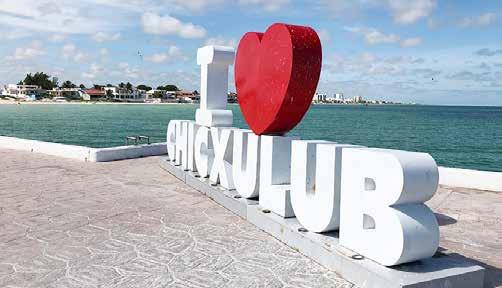
cal market, and a Colectivo (van) stand offering transportation to and from Progreso.
Chelem has a surprising number of restaurants serving both local (mainly seafood) and international style meals. For dessert, stop at a coconut stand to try one of their many sweet specialty offerings.
Chicxulub Puerto: The name of this fishing village, just 7.5 kilometers east of Progreso, is pronounced cheek-shoo-loob. It is also a name known around the world, as the crater left by the meteorite that wiped out the majority of dinosaurs 65 million years ago bears its name, due to its proximity to the epicenter. While the Chicxulub Crater Museum is actually by the Malecón in Progreso (see p. 49), here you’ll find the Sendero Jurásico (Jurassic Trail), an interactive experience several meters long. If you don’t feel like stopping, you can take a look at the dinosaur effigies from the road along the estuary.
How to get there: Follow the signs to turn east just before you enter Progreso; you can also take a direct route from the Mérida - Motul road, exiting right before you get to Conkal.
50 Destinos
Calle 17 Calle 24 Calle 22 Calle 20 Calle 18 Calle 19 Calle 23 Calle 27 Calle 25 Chuburná Puerto 10 km RÍA DE CHELEM
Yucalpetén 5 km Progreso 12 km
Calle 28 Calle 30 Calle 21
Golfo de México
Área de Flamencos Flamingo Area Mercado Plaza / Main Plaza
Ojo de Agua / Natural Water Spring Embarcadero / Wharf Autobuses
or su proximidad a Progreso, los puertos de Chuburná, Chelem y Chicxulub se encuentran entre los predilectos de visitantes de todas partes. Durante Semana Santa y verano, podrías creer que todos los habitantes de Mérida se encuentran en estas tres poblaciones; en el invierno, te encontrarás sobre todo extranjeros huyendo del frío.
Chuburná Puerto: Este pequeño poblado, 20 kilómetros al oeste de Progreso, marca el inicio de la carretera costera. Chuburná es el hogar del Playón Las Dunas, una larga extensión de playa que parece no tener fin. Este tramo de playa es muy frecuentado por los yucatecos, que disfrutan hacer picnics, y kitesurfistas buscando sacar el máximo provecho al espacio disponible.
FOTO: YUCATÁN TODAY FOTO: YUCATÁN TODAY CHUBURNÁ PUERTO / CHELEM / CHICXULUB PUERTO
Chelem
ntre 40 y 80 kilómetros al este de Progreso, sobre la costa, se encuentran tres poblados que ofrecen cada uno un gran rango de atractivos y actividades que te encantarán. Elige uno o visítalos todos; cada uno tiene algo mágico qué mostrarte.
Telchac Puerto: Telchac es conocido por su amplia extensión de dunas, que lo hacen ideal para disfrutar la playa y nadar en el mar. En el centro del poblado hay un muelle desde donde los telchaqueños pescan con cordel, y tiendas y restaurantes que ofrecen variedad de mariscos y dulces de coco para todos los gustos. La oferta hotelera va desde casas completas (que se pueden rentar por días, semanas e incluso meses) hasta habitaciones de hotel.

San Crisanto: En este pequeño pueblo, a 10 km de Telchac Puerto, las vocaciones principales son la pesca y el cultivo de coco. Pasa el día en el balneario Zac-Ha; hay palapas, baños, regaderas, área de estacionamiento y espacio para acampar. (pasadía: $110 pesos por persona, de 9 am a 5 pm; campamento: $180 pesos por persona). También puedes hospedarte en las cabañas ubicadas un kilómetro más adelante, disponibles con previa reservación.
San Crisanto cuenta con un proyecto sustentable que reúne a los pobladores en actividades turísticas, artesanales y de conservación; parte del mismo consiste en paseos por el manglar en barcas sin motor que finalizan con una visita a un ojo de agua dulce ($110 pesos por persona).
Dzilam de Bravo: Aunque no tiene playa, este puerto pesquero, el último de la carretera costera, es ideal para hacer tours, incluyendo un enorme ojo de agua en el mar que vale la pena el viaje. Los lugares a visitar en los tours son las Bocas de Dzilam, Punta Arena, playa El Cielito, el famoso ojo de agua Xbuya-Ha, el cenote Elepetén y las piedras de Chacaltún para hacer snórkel. También hay tours especializados para hacer pesca deportiva o avistamiento de aves. No dejes de checar los tours de bioluminscencia, disponibles todo el año en las condiciones adecuadas (E Tico’s Tours).
Cómo llegar: En autobús, desde Mérida, por Autobuses del Noreste (Calle 67 x 50, Centro). Desde Progreso también hay varias salidas en combis y autobuses.
ACTIVIDADES CERCANAS
Sayachaltún: Paseos ecoturísticos en el manglar. Xcambó: Una de las zonas arqueológicas más extensas de Yucatán, y la única que se encuentra en la costa. Xtampú: Salinera comunitaria donde es posible ver lagunas rosadas.
Between 40 and 80 kilometers (25 and 50 miles) east of Progreso, also on the coast, you’ll find three villages that offer fun and plenty of activities you’ll enjoy for sure. Pick one or visit them all; you’ll find each onehas something incredible to offer.

Telchac Puerto: Telchac is known for its wide, sandy beaches, perfect for both sunbathing and swimming. The village has a dock from where Telchaqueños practice line fishing, as well as shops and restaurants with a variety of seafood and coconut-based delicacies. Lodging options include houses (which you can rent by the day, week, or even for months at a time) as well as hotel rooms.
San Crisanto: The San Crisanto beaches are some of the less visited by tourists, which means more space to enjoy yourself. The beach club Zac-Ha offers different services like Palapas, restrooms, showers, a parking area, and camping space (Day passes: $110 pesos per person, 9 am - 5 pm; overnight camping: $180 pesos per person). You can also spend the night at the cabins located a kilometer away, by prior reservation only.

Through a sustainable project that fosters local tourism, handcrafts, and biodiversity conservation activities, locals offer mangrove tours on a man-powered boat, including a swim in a crystal-clear, freshwater spring ($110 pesos per person).
Dzilam de Bravo: Despite not having a proper beach, this fishing town (the last one on the coastal road) offers an endless number of tours, including one to a freshwater spring in the ocean that make the trip worth it. Ask about tours to Bocas de Dzilam, Punta Arena, El Cielito beach, the famous Xbuya-Ha freshwater spring, the Elepetén cenote, and snorkeling in Chacaltún, as well as fishing and birdwatching tours. Stunning bioluminescence tours are also available year-round. For more information, check out E Tico’s Tours.
How to get there: Autobuses del Noreste (Calle 67 x 50, Centro) offers bus options from Mérida; from Progreso, you can get there by van or bus.
NEARBY ACTIVITES
Sayachaltún: Environmentallly friendly tours of the mangrove.
Xcambó: One of the largest, oldest archaeological sites in Yucatán, as well as the only one on the coast.
Xtampú: A community salt mine where the lagoons turn bright pink depending on the mining process.
51 Destinations
E
GOLFO DE MÉXICO TELCHAC PUERTO Motul 20 km Mérida 62 km Sinanché 15 km Progreso 40 km Dzilam de Bravo 30 km Dzemul 13 km Baca 35 km SAN CRISANTO Puerto de AbrigoHarbor Muelle / Pier Plaza Principal Main Plaza Cabañas Ejido San Crisanto Xtampú Manglar / Mangrove Xcambó
FOTO: MKCT FOTO: MKCT
Dzilam de Bravo Telchac Puerto
© YUCATÁN TODAY TELCHAC
PUERTO / SAN CRISANTO / DZILAM DE BRAVO
Buscas rincones más retirados? En el noreste de Yucatán te esperan dos destinos que te ofrecen bellos paisajes y un ambiente tranquilo.
Tizimín: Esta ciudad, cuyo nombre viene de Tsíimin, la palabra maya para el “tapir” (el animal sagrado y totémico del dios supremo de los mayas), fue fundada por los padres franciscanos que venían con los conquistadores en 1544. Curiosamente, con la llegada de los españoles, la que era la tierra de los tapires se fue convirtiendo en la tierra de los caballos, que, por lo alargado de su cara, también se llaman Tsíimin en maya.
Además de una activa industria de aserradero, la tierra fértil de Tizimín mantiene los pastos y granos para el ganado; es aquí que encontrarás el grueso de esta actividad en el estado. Esto se refleja no sólo en la vestimenta y costumbres de sus habitantes, sino en sus tradiciones gastronómicas, que incluyen más platillos a base de res y carnero.
Actividades: Visita el Parque Ecológico
El Monte y el poblado de San Manuel km 11 para actividades de ecoturismo con la familia. Para un chapuzón en algún cenote, visita el Cenote Kikil. También podrás visitar la Laguna Nachi Cocom. Y si no quieres salir de la ciudad, te esperan el Salón de Arte e Historia y su centro.Las pirámides mayas más cercanas incluyen Ek Balam y la casi desconocida Kulubá, ubicada unos 35 km al suroeste de Tizimín.
Cómo llegar: En autobús desde la terminal Noreste se ofrecen dos salidas diarias; también hay taxis colectivos (Calle 52 x 65 y 67) que ofrecen salidas cada 75 a 90 minutos.
El Cuyo: Conocido como el tesoro escondido de la Costa Esmeralda de Yucatán, es una pequeña comunidad playera donde disfrutarás de un ambiente típico y tranquilo de un pequeño puerto que te invita a
relajarte y disfrutar la hermosura de la naturaleza. El pueblo conserva su arquitectura tradicional: coloridas casas hechas de paneles de madera con palapas y techos bronceados por el sol, y ofrece también un sinfín de actividades acuáticas.
Este paraíso está situado en la Reserva Especial de la Biósfera de Ría Lagartos, la cual es internacionalmente famosa por los 20,000 flamencos rosados que anidan en ella entre enero y septiembre. También podrás observar más de 250 diferentes especies de aves que visitan la zona.
Actividades: Puedes conocer el faro, rentar cuatrimotos, contratar un carrito de golf, hacer kitesurfing y descansar. Dirígete hacia la arena o al pequeño puerto para observar el majestuoso atardecer al norte de la costa de Yucatán.
Cómo llegar: Para llegar en automóvil desde Tizimín, dirígete al este hasta Colonia Yucatán, y luego al norte hasta El Cuyo. Si vas en transporte público, hay autobuses que van de Tizimín a El Cuyo pasando por el poblado de Colonia Yucatán.
ooking for more secluded corners? Two destinations with beautiful sights and plenty of peace await in northeast Yucatán.
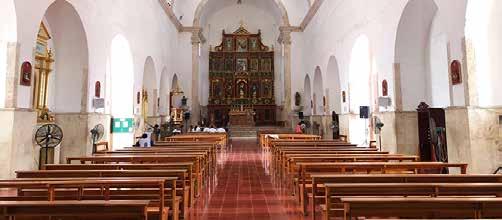
Tizimín: This city, whose name comes from Tsíimin, the Maya word for tapir (the sacred and totemic animal of the supreme Maya god), was founded by Franciscan friars in 1544. Interestingly, after the Europeans’ arrival, the land of tapirs became the land of horses, which were also named Tsíimin in Maya because of their long, tapir-like faces.
Besides an active timber industry, Tizimín’s fertile land supports pasture and grain for livestock, which is the main driver behind its booming economy. This is easily seen not
only in locals’ dress, habits, and traditions, but in their everyday food, which includes more beef- and lamb-based dishes.
Tizimín offers comfortable hotels, restaurants with varied cuisine, such as Casa Makech, and travel agencies promoting tours to nearby sites. Between December and January, you’ll find the city transformed by the celebration of its patron saints, the biblical Magi. The festivities include masses, pilgrimages, parades, vaquerías, cattle exhibits, agricultural, industrial, and commercial exhibits. Plan ahead if you’d like to visit, as accommodation can be scarce this time of the year.
Activities: Visit the Parque Ecológico El Monte and the village of San Manuel km 11 for ecotourism activities (for all ages!). Looking for a cenote in the area? Go to Cenote Kikil. Also in the area: the Nachi Cocom lagoon. If you don’t want to leave the city, the Art and History Hall and its city’s Centro are a perfect option. Nearby Maya pyramids include Ek Balam and the almost unknown Kulubá, located southwest of Tizimín.
How to get there: By bus, Terminal Noreste offers two daily departures. There are also shared vans (Calle 52 x 65 y 67, Centro) leaving every 75 to 90 minutes.
El Cuyo: Known as Costa Esmeralda’s hidden treasure, El Cuyo is a small beach community where you’ll enjoy the tranquil ambiance of a small port. Everything about it invites you to relax and enjoy the beauty of nature. For the most part, the village conserves its traditional architecture: colorful houses made from wooden slabs or concrete, topped off with palapas and sunburned concrete roofs.
This paradise is nestled in the Ría Lagartos Special Biosphere Reserve, which is internationally famous for the 20,000 pink flamingos that nest there between January and September every year. With more than 250 different birds visiting Río Lagartos, it is also a fantastic place for birdwatching.
Activities: Check out the lighthouse, take rides on quad bikes, hire golf carts, kitesurf, and chill out here. Head to the beach or small pier to take in the majesty of the sun setting along the north coast.
How to get there: From Tizimín, go east towards Colonia Yucatán, and then north to El Cuyo; refer to our map of the Yucatán Peninsula for details. By public transportation, buses go from Tizimín to El Cuyo via Colonia Yucatán.
52 Destinos TIZIMÍN / EL CUYO
¿ L
FOTO: YUCATÁN TODAY
Templo de los Tres Reyes Magos, Tizimín
Las Coloradas
stos pequeños poblados ubicados en la costa norte de Yucatán son simplemente estupendos. Desde ambos puedes explorar manglares y salineras, observar pájaros y animales, así como disfrutar mientras te relajas en la playa.
San Felipe: Este pintoresco pueblo de pescadores es la puerta de acceso a la Reserva de la Biósfera de Ría Lagartos, una de las maravillas naturales del estado de Yucatán.
Una de las características de San Felipe es la construcción de las viviendas en madera y de todos los colores, lo que hace que sea uno de los poblados visualmente más alegres de todo Yucatán. San Felipe cuenta con aproximadamente 500 casas de este estilo.

Toma un recorrido en lancha para explorar el ojo de agua, Playa Bonita e Isla Cerritos. Los tours salen de una palapa al fondo del pueblo. Los precios se manejan por lancha, no por persona. Toma en cuenta que sólo es posible llegar hasta la playa en barco. No olvides hacer una parada en El Popular Vaselina para comer.
Río Lagartos: A 9 km está Río Lagartos. Ahí encontrarás hoteles y restaurantes con opciones para visitar la ría y bellas playas. La Biósfera de Ría Lagartos es famosa por ser el hogar de la población más grande de flamencos en México durante una parte del año. Probablemente te encuentres con varias especies de aves locales y migratorias al igual que cocodrilos mientras paseas por la ría.
Mientras caminas por el pintoresco pueblo pesquero, asegúrate de conocer los pe-
queños muelles, ya que algunos tienen columpios bastante divertidos y dignos de ser publicados en tu Instagram.
Las Coloradas: Este pequeño puerto presenta un escenario que impacta todos tus sentidos, un espectáculo visual de color rosa. No te pierdas una visita a este apacible lugar, donde podrás apreciar las aguas naturalmente rosadas y un horizonte limpio donde se confunde dónde terminan las lagunas y dónde comienzan el cielo y las nubes.
Las Coloradas es un destino que ha atraído a visitantes de todo el mundo. Si te preguntas a qué se debe este color rosado, la explicación es sencilla: la pigmentación es producida por microorganismos y algas que se encuentran en las aguas de este puerto, debido a la alta concentración de sal.
Las Coloradas están a 20 minutos de Río Lagartos por tierra o por mar. Puedes recorrerlas a pie o admirarlas desde lo alto en la torre mirador. Como sugerencia te recomendamos contratar un guía, ya sea en el poblado o desde Río Lagartos. Además, te recomendamos visitar al mediodía para apreciar tonos aún más contrastantes y escenarios dignos de fotografías increíbles.
TOURS DISPONIBLES AVAILABLE TOURS
Tours de pesca.
· Tours de avistamiento de aves.
Tours de cocodrilos.
Tours de las lagunas de color rosa Las Coloradas: a pie, en bicicleta y en vehículo tipo safari.
Tours depart from the Palapa at the far end of the village. Prices are per boat rather than per person. Note that the beach here is only accessed via boat ride. Don’t forget to stop at El Popular Vaselina for a delicious lunch.
Río Lagartos: 9 km down the road is Río Lagartos, where you’ll find hotels, restaurants, and options for tours of the estuary, and stunning beaches. The Río Lagartos Biosphere is famously home to the largest American flamingo population in México for much of the year. You’re also likely to see many other species of local and migratory birds, as well as crocodiles whilst touring the estuary from here. There are also specialized wildlife tours available.
As you stroll through this quaint fishing village, be sure to check out the small jetties as some have Instagram-worthy swings.
Las Coloradas: This small port presents scenery that will dazzle all of your senses. You’ll see natural pink water pools create a clean horizon, and blur the line where the lagoons end and the sky and the clouds begin. This is a destination that has attracted visitors from all over the world. If you’re wondering about the water’s pink hues, the explanation is simple: the pigmentation is produced by micro-organisms and algae that are found in the waters of this port due to the high concentration of salt.
· Fishing tours.
· Birdwatching tours.
· Crocodile-spotting tours (at night).
· Las Coloradas pink salt lakes tours: by foot, by bike, and by safari vehicle.

These small (tiny) towns along the north coast of Yucatán are truly stunning. They’re all great starting points to explore mangroves and salt fields, practice birdwatching, and enjoy a relaxing time at the beach.
San Felipe: This picturesque fishermen’s village is the gateway door to the Ría Lagartos Biosphere Reserve, one of Yucatán’s impressive natural wonders. San Felipe looks different to its neighbors because of its over 500 wood houses painted in every color; they make San Felipe one of the cheeriest-looking villages in Yucatán.
Visit San Felipe to enjoy a serene time on the water. Take a Lancha (boat) tour to explore the Ojo de Agua, Playa Bonita, and Isla Cerritos.
Would you like to visit? The famous pink lagoons are 20 minutes away from Río Lagartos by land or sea. You can just stroll around or see them from a 12-meter lookout tower.
As a suggestion, we recommend hiring a guide, either once you get there or from Río Lagartos. Additionally, we recommend visting around noon see the water at its pinkest, and capture stunning photographic scenes.
53 Destinations
E
FOTO: LAS COLORADAS PARQUE TURÍSTICO
SAN FELIPE / RÍO LAGARTOS / LAS COLORADAS
San Felipe
FOTO: YUCATÁN TODAY
BIENESTAR • WELLNESS / DIRECTORIO DE SALUD • HEALTH DIRECTORY
érida, y todo el estado de Yucatán, ha sido por mucho tiempo un polo de salud para el sureste de México, e incluso Centroamérica. Con una gran infraestructura de servicios médicos, modernos y equipados hospitales y profesionales de clase mundial, no es difícil entender por qué cada vez más personas eligen venir a atenderse aquí para todo tipo de dolencias y tratamientos.
Sin embargo, eso no es todo. Yucatán ofrece también una amplia gama de opciones para practicar deportes, sobresaliendo tanto en instalaciones como en entrenadores, en disciplinas que van desde el atletismo hasta el ajedrez, pasando por las artes marciales, deportes acuáticos, y deportes de equipo. Si el deporte no es lo tuyo, pero deseas mantenerte en forma, también hay un sinfín de opciones de gimnasios y estudios para practicar distintos estilos de danza, spinning, crossfit, y decenas de otras disciplinas.
Tampoco es necesario descuidar tu salud mental y emocional, con opciones para prácticas de meditación, arte y muchos otros hobbies, además de terapias que van desde los masajes hasta tratamientos de medicina alternativa y tradicional, psicoterapia, etc.
érida, and all of Yucatán, has long been a healthcare hub for southeast México, and even Central América. With outstanding infrastructure, modern and fully equipped hospitals, and world-class health professionals, it isn’t hard to understand why a growing number of travelers, now even from up north, are choosing to come here to be treated for all sorts of ailments, dental work, and even optional procedures, like cosmetic surgery.
That’s not all, however. Yucatán also offers a wide array of options to stay healthy, for example, through sports, from baseball to chess, including martial arts and water sports, just to name a few local favorites. If organized sport isn’t your thing but you still want to stay active, there’s also plenty of gyms and studios where you can try different practices, including different kinds of dance, spinning, crossfit—in short, more than we could possibly list.
You don’t need to set your mental and emotional health aside while you’re here, either. All over the state you’ll find places to practice meditation, art, and many other hobbies, in addition to therapies that go from massage to alternative and traditional medicine, psicotherapy, etc.
HOSPITALES • HOSPITALS
Centro Médico Americano
Progreso
m 969 935 0951 www.cmaprogreso.com.mx
Centro Médico de las Américas (CMA)
Mérida
m 999 926 2111 www.centromedicodelasamericas.com.mx
Clínica de Mérida
Mérida
m 999 942 1800 www.clinicademerida.com.mx

Faro del Mayab
Mérida
m 999 689 4500 www.hospitalfaro.com
Star Médica
Mérida
m 999 930 2880 www.starmedica.com
SALUD Y BIENESTAR • HEALTH AND WELLNESS
Casa Ki’óol & Spa
# + 52 999 216 0874 / www.kiolspa.blogspot.com

Q casakiool E CASA KIOOL Mérida
Control Odontológico
Dr. Víctor Gámez
m 999 926 4429
E Control Odontologico Integral

Quality Dental (Dr. Javier Cámara)

m 999 167 9444
Q qualitydentalmid1 E Quality Dental
Shaman Hermano Maya
# 988 954 5366 / www.shamanismomaya.com
Q mayahermano E Hermano Maya
Star Óptica
m +52 999 137 0066
www.staroptica.com /atencion@staroptica.com

Yaxkin Spa en Chichén Itzá
m 999 920 8407
E Hacienda Chichen Resort and Yaxkin Spa
54 Referencia Rápida
M M
AGENCIAS DE VIAJE / TOURS / TRANSPORTACIÓN • TRAVEL AGENCIES / TOURS / TRANSPORTATION

Destino Mérida Private Tours
m 999 261 6126
www.destinomeridatours.com
E Destino Merida Private Tours
Hal Tun Transportadora
m 999 126 1998
www.yucatanviptours.com
E Hal Tun Transportadora
k haltuntransportadora@hotmail.com
Mayan Ecotours
www.mayanecotours.com
E Mayan Ecotours
Tekax Adventours
m 997 973 4372
E Tekax Adventours
Sisal Beach Tours
m 999 260 6816
INMOBILIARIAS • REAL ESTATE + PROPERTY MANAGEMENT
Bayside Real Estate
Calle 21 x 80, Malecón Tradicional
www.baysideyucatan.com
E Bayside Real Estate Yucatán
Caban Condos
m +1 306 361 1800 / 984 234 8694
www.cabancondosmexico.com
Q E Caban Condos Mexico
Gone South Property Management
m 999 164 1118
www.gonesouth.online
Hamaka Professional Co-Hosting
m 999 965 8953 / www.hamaka.mx
Q E hamaka.mx
Homes for Sale
m 999 264 3777 / 999 163 4050
www.homesforsaleinyucatan.com
Marcrisanto
m 999 327 8666 www.marcrisanto.mx
Mexico International
Calle 9 #63 x 6 y 8, Reparto Dolores Patrón (García Ginerés)
m 999 920 6856 www.mexintl.com
E Mexico International Real Estate
Meridano Inmobiliaria
m 999 414 1250 www.meridano.com.mx
Q meridano.mx
Yucatán Beach and City Property
m +1 830 273 3881
L 999 129 9403
www.yucatanbeachandcityproperty.com
E Yucatán Beach and City Property
RENTADORAS DE AUTOS • CAR RENTAL AGENCIES
Chichén Car Rental

m 999 905 6590
Q chichencarrental E Chichen Car Rental
Mayan Wheels Car Rental

Mérida m 999 666 7320
Progreso m 969 103 6735
México Rent a Car
m 999 127 8556 / 999 988 8465
www.mexico-rent-acar.com


E México Rent A Car

UB Rent a Car
m 999 920 2929 # 999 209 2830
rentaautoub@gmail.com www.rentacarub.com
VIP Rent a Car
m 999 406 5017 # 999 301 9926
viprentacar2017@gmail.com
E VIP Rent a Car Yucatán
Xootrip
m 999 950 2290 # 999 236 1545
xootrip@gmail.com www.xootrip.com E Xootrip
Yucatán Best Car Rental
m 999 923 6337 # 999 328 2577 yucatanbestcar@gmail.com
55 Quick Reference
BIENVENIDO A YUCATÁN

En Yucatán, las calles llevan números en vez de nombres. Fuera del centro, los números de las calles pueden cambiar de una colonia o fraccionamiento a otro.
Diversión al aire libre: Las calles del estado son muy seguras; de lo que deberás cuidarte es del calor. Usa protector solar, manténte en la sombra e hidrátate con agua purificada.
Propinas: Las propinas son esenciales para prestadores de servicios como camaristas de hotel y guías en sitios arqueológicos y grutas. En restaurantes, el 15% del consumo es una propina justa.
CONDUCIR EN YUCATÁN
Estacionamiento: Está prohibido estacionarse en banquetas pintadas de rojo y amarillo. En el centro, busca estacionamientos públicos, que cobran hasta $40 pesos por hora. Por ley, las tarifas deben estar publicadas.
Gasolineras: En México no hay gasolineras de autoservicio. Pídele al despachador la cantidad que necesites (en pesos o litros) y asegúrate de que la bomba marque ceros. La mayoría de las gasolineras aceptan tarjetas de crédito, pero es mejor preguntar.
Topes: Sobre todo en el interior del estado, ten mucho cuidado con los topes; en algunas poblaciones, los habitantes los construyen por su cuenta, lo que significa que pueden no estar debidamente señalizados.
TEMPORADA DE HURACANES
De junio a noviembre es la temporada de tormentas tropicales; mantente al tanto de los avisos oficiales y sigue las instrucciones de las autoridades.
Encuentra más información en nuestro sitio web: www.yuc.today/consejos-viaje
WELCOME TO YUCATÁN

Yucatán city streets go by numbers instead of names; keep in mind that, beyond Centro, street numbers may change from one sector (Colonia) to the next.
Outdoor fun: Walking, jogging, and running are generally safe in Yucatán; the one thing to look out for is the heat. Wear sunscreen, remain in the shade when possible, and stay hydrated by drinking purified water only.
Tipping: Tips are essential to travel industry staff, like hotel maids and guides at archeological sites and caves. In restaurants, 15% of your bill is a fair tip; for musical trios, $100 pesos for three songs. Gas station and parking attendants expect $5 to $10 pesos.
DRIVING IN YUCATÁN
Drinking and driving: You might run into police breathalyzer checkpoints; should the alcohol concentration in your breath be 0.40 mg/L or above, you could be fined or jailed, and your vehicle towed.
Parking: Street parking is limited in Centro, and parking by curbs painted yellow or red is forbidden. Keep and eye out for public parking lots (Estacionamiento Público), which may charge up to $40 pesos per hour; rates should be posted at the entrance.
Gas stations: There are no self-serve stations in México. Ask the attendant for the amount you need (in pesos or liters) and make sure the pump is set to “zero.” Credit cards are also accepted at most stations, but it’s always a good idea to ask beforehand.
Speedbumps (Topes): When driving anywhere, but especially in villages, keep an eye out for surprise speedbumps; some residents build their own, meaning they may not be properly signaled, nor up to code.
HURRICANE SEASON
Tropical storms may strike between June and November; keep an eye out for official announcements and follow instructions.
Visit www.yuc.today/travel-tips for more information to make the most of your stay
TELÉFONOS DE EMERGENCIA • EMERGENCY PHONE NUMBERS
Emergencia / Emergency m 911
Bomberos / Fire department m 999 924 9242 y 060
Cruz Roja / Red Cross m 999 924 9813 y 065
Policía Estatal / State police m 999 930 3200
Ángeles Verdes (auxilio vial)
Green Angels (roadside help) m 999 983 1184 y 078
Policía turística / Tourist police m 999 930 3200 ext. 462
Denuncia anónima
Anonymous tipline m 089
Guardia Nacional / National Guard m 999 946 1223 / 999 946 1203
Policía de Mérida / Mérida Police m 999 942 0060 y 999 942 0070
CONSULADOS • CONSULATES
Instituto Nacional de Migración
Mexican Immigration Office m 999 925 5009
Alemania • Germany
m 999 944 3252 / merida@hk-diplo.de
Belice • Belize
m 999 928 5421 / consbelize@dutton.com.mx
Canadá
m 998 883 3360 / 555 724 9795
Chipre • Cyprus m 999 924 6821 / tonyabxa@hotmail.com
Cuba
m 999 944 4215
España • Spain
m 999 948 3489 / consulado.es.mid@gmail.com
Estados Unidos • U.S.A.
m 999 942 5700 / meridacons@state.gov
Francia • France
m 999 930 1500 / chfrances@gmail.com
Honduras
m 999 923 1978 /consulhonyuc.@hotmail com
Líbano • Lebanon
m 999 925 9957 / rdodajemahum@msn.com
Luxemburgo • Luxembourg merida@consul-hon.lu
56 Referencia Rápida
CONSEJOS DE VIAJE • TRAVEL TIPS

























 E Cenote Dzonotoch
E Cenote Dzonotoch





















































 Halachó, Yucatán
Halachó, Yucatán














































































